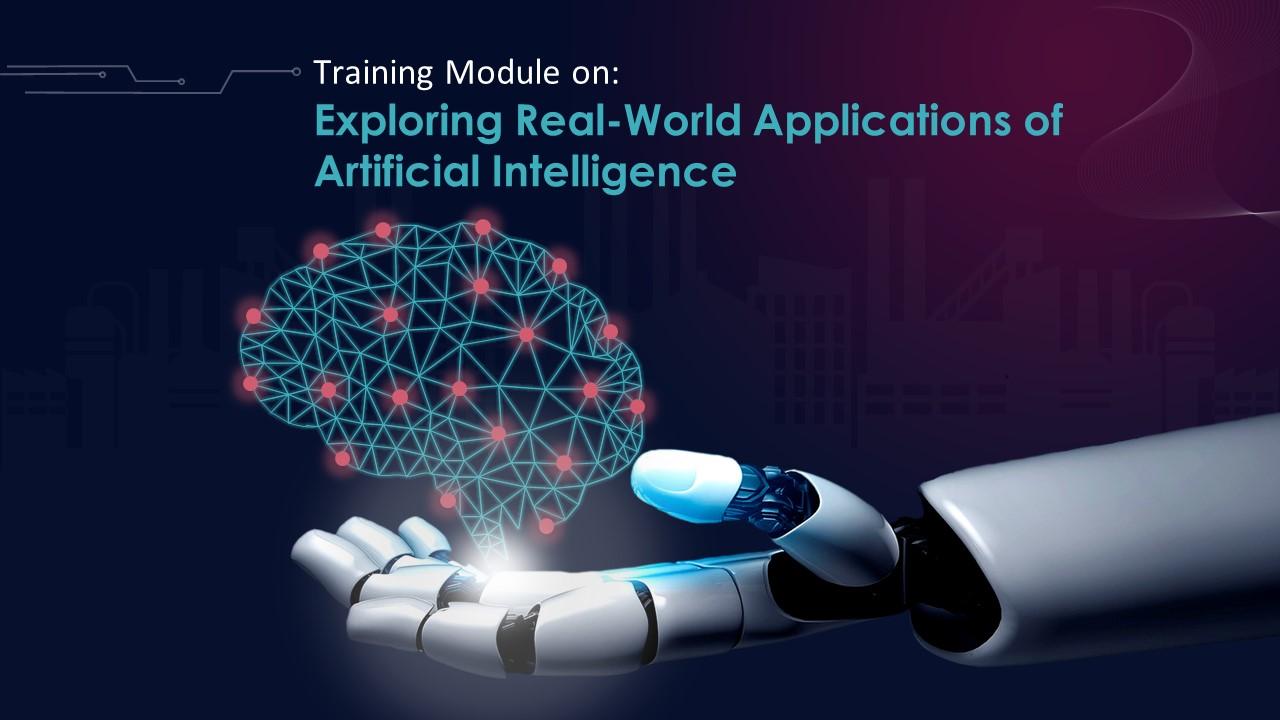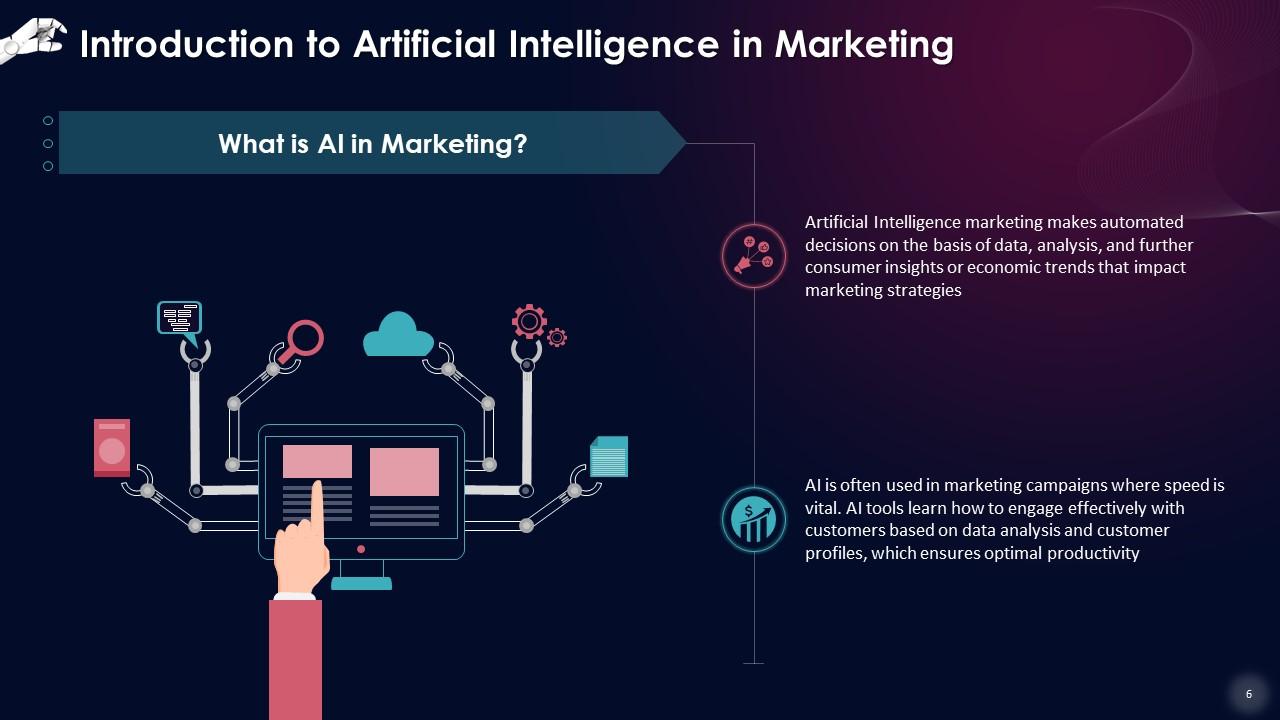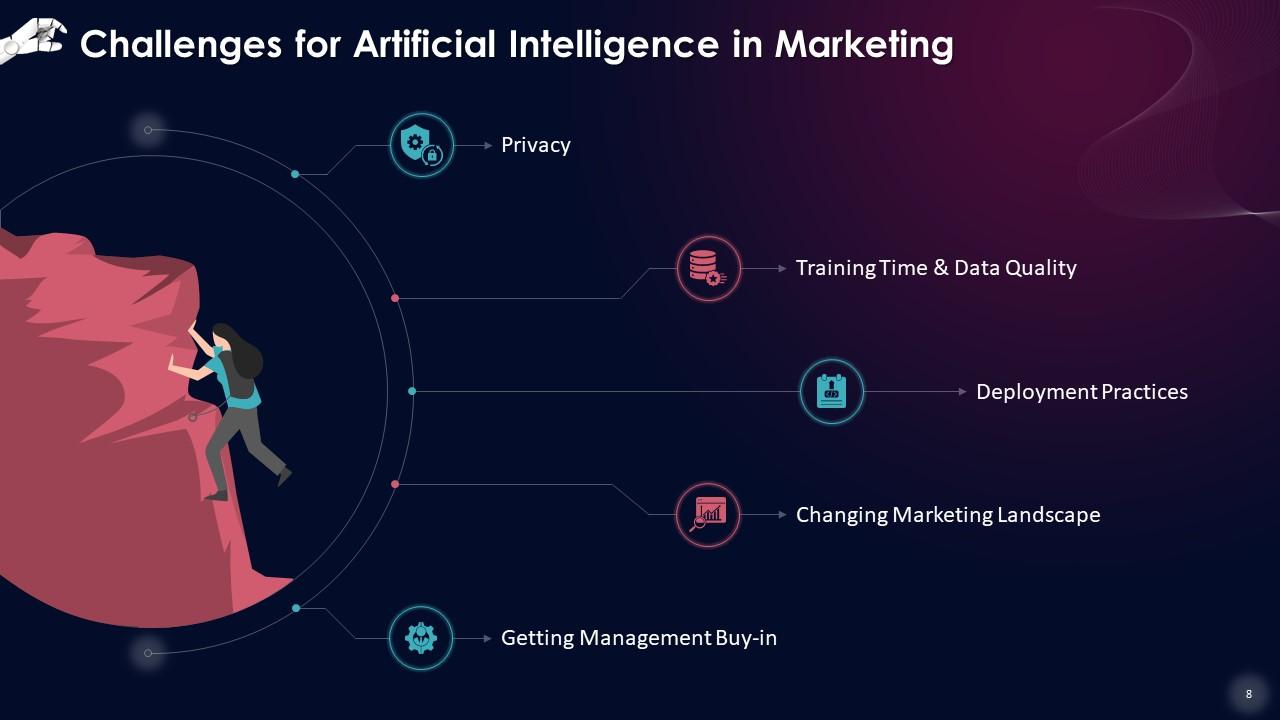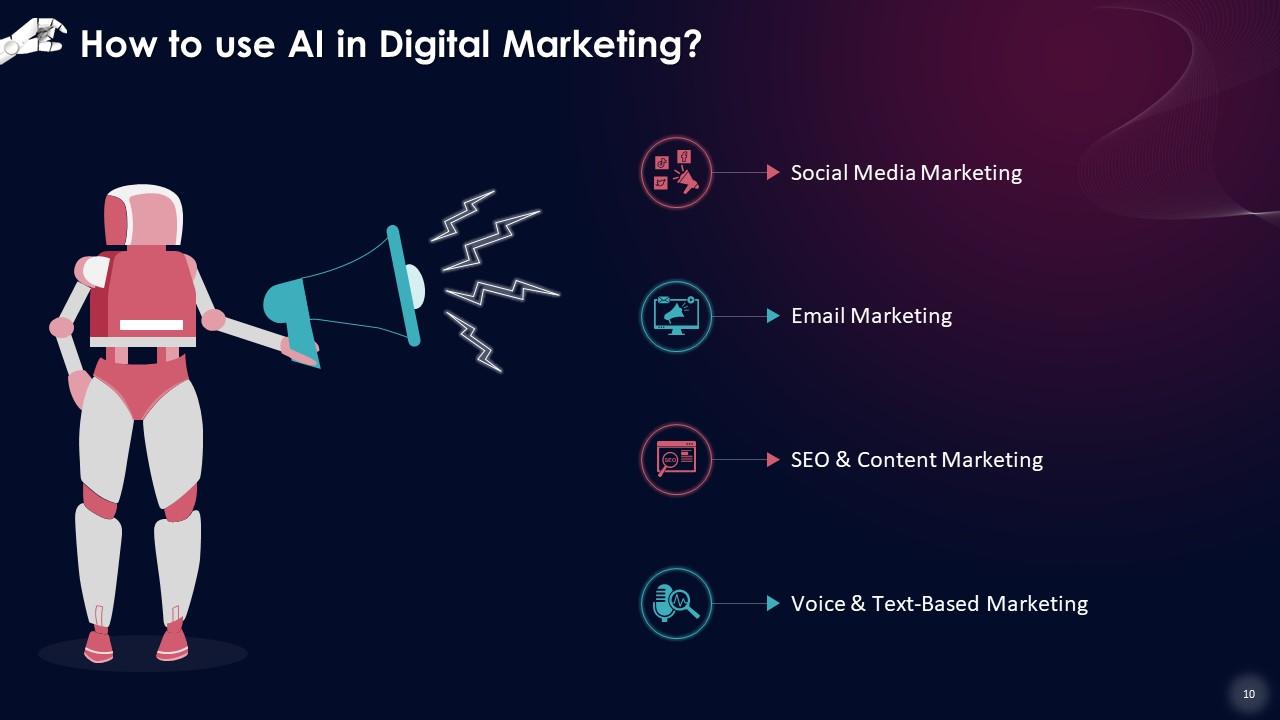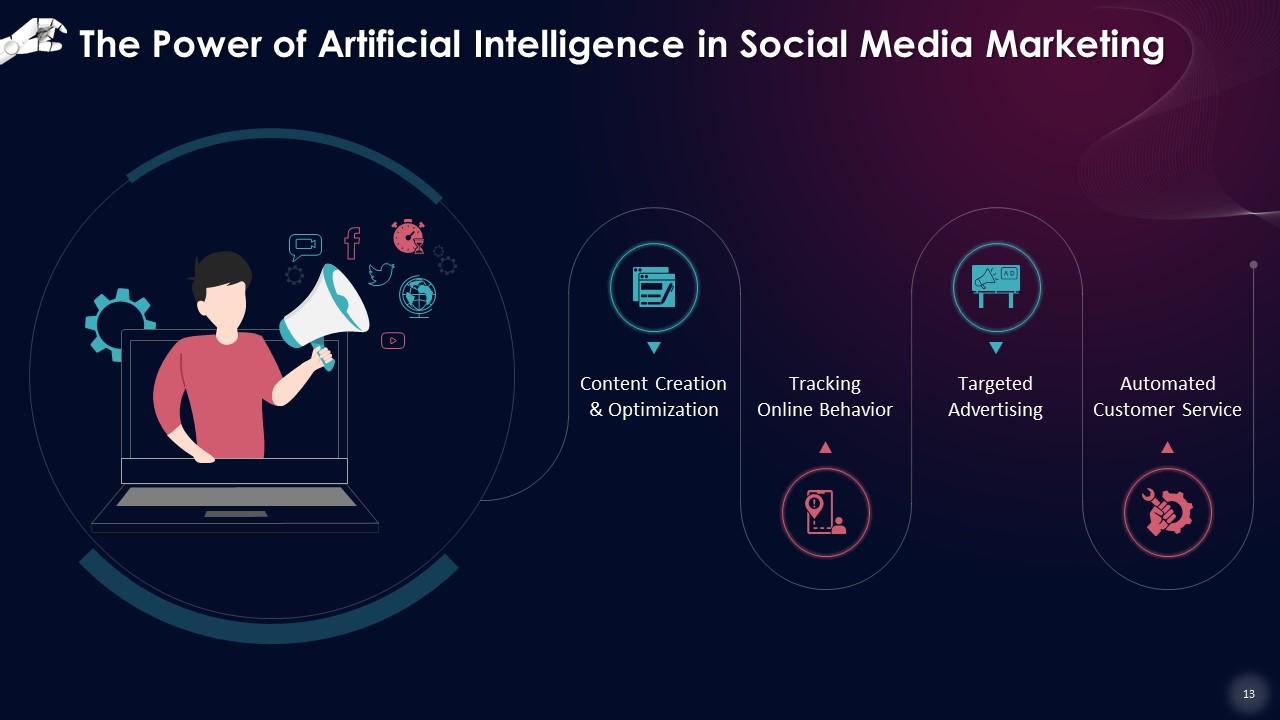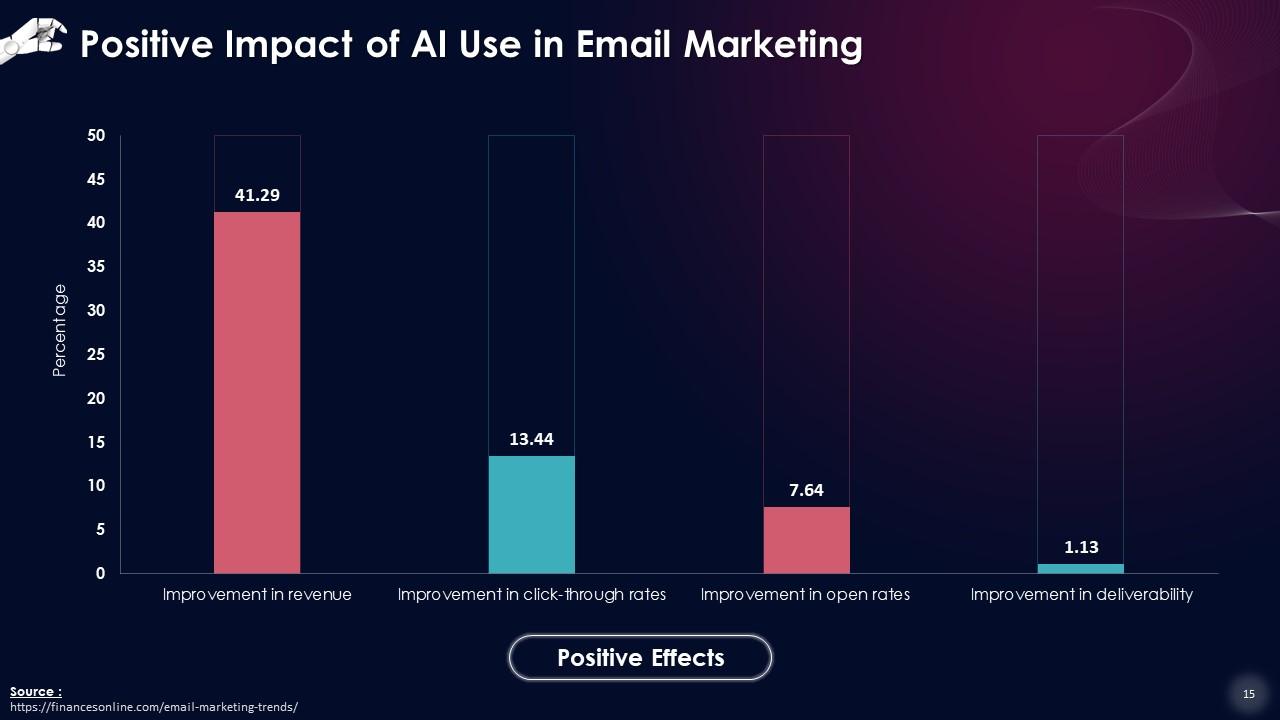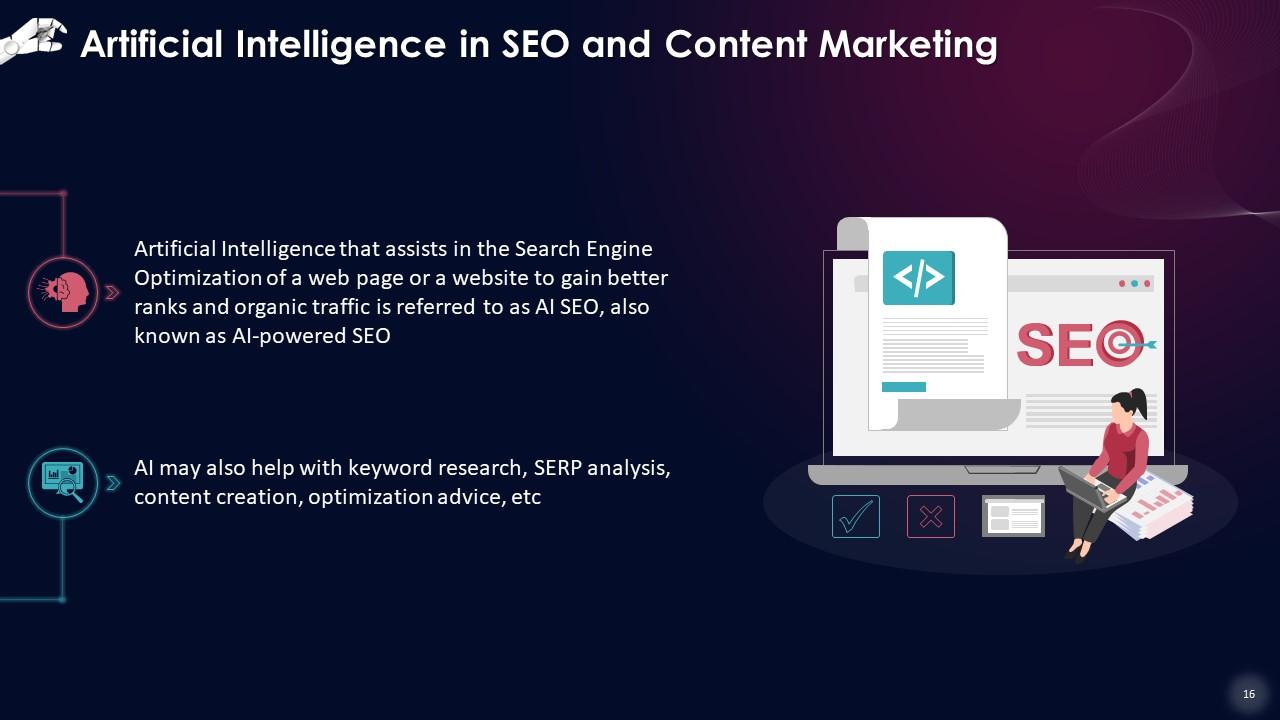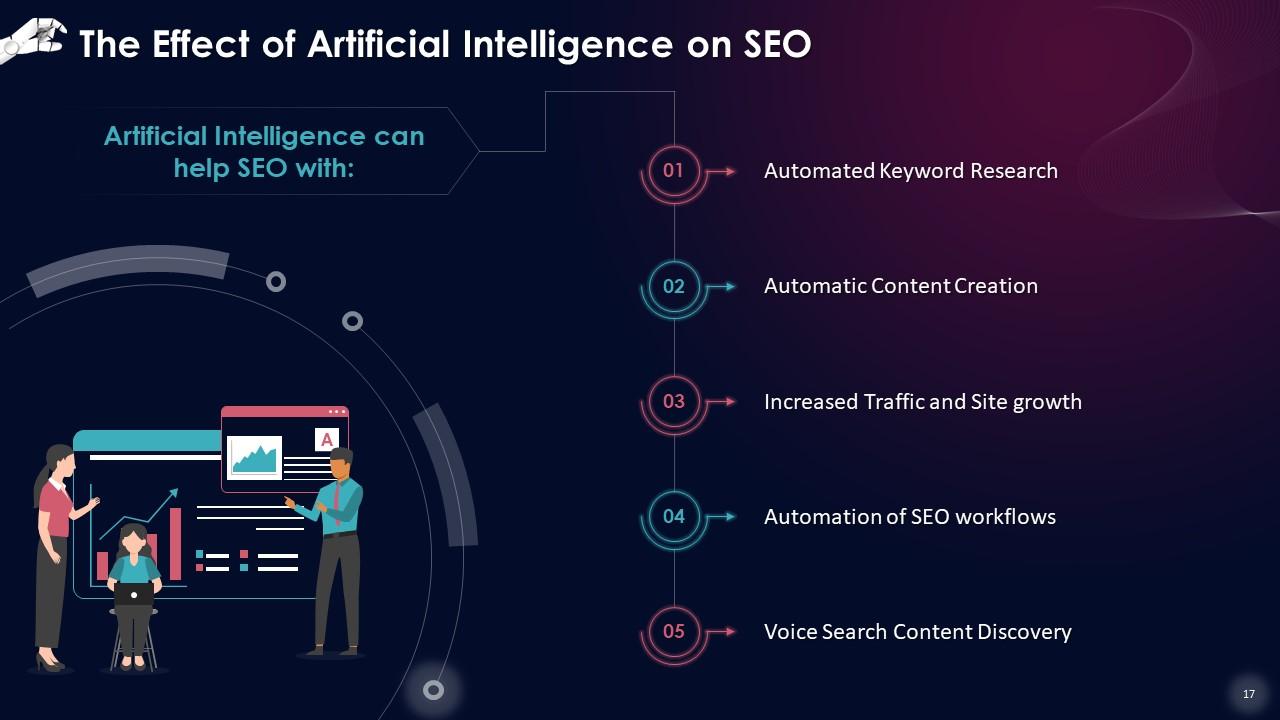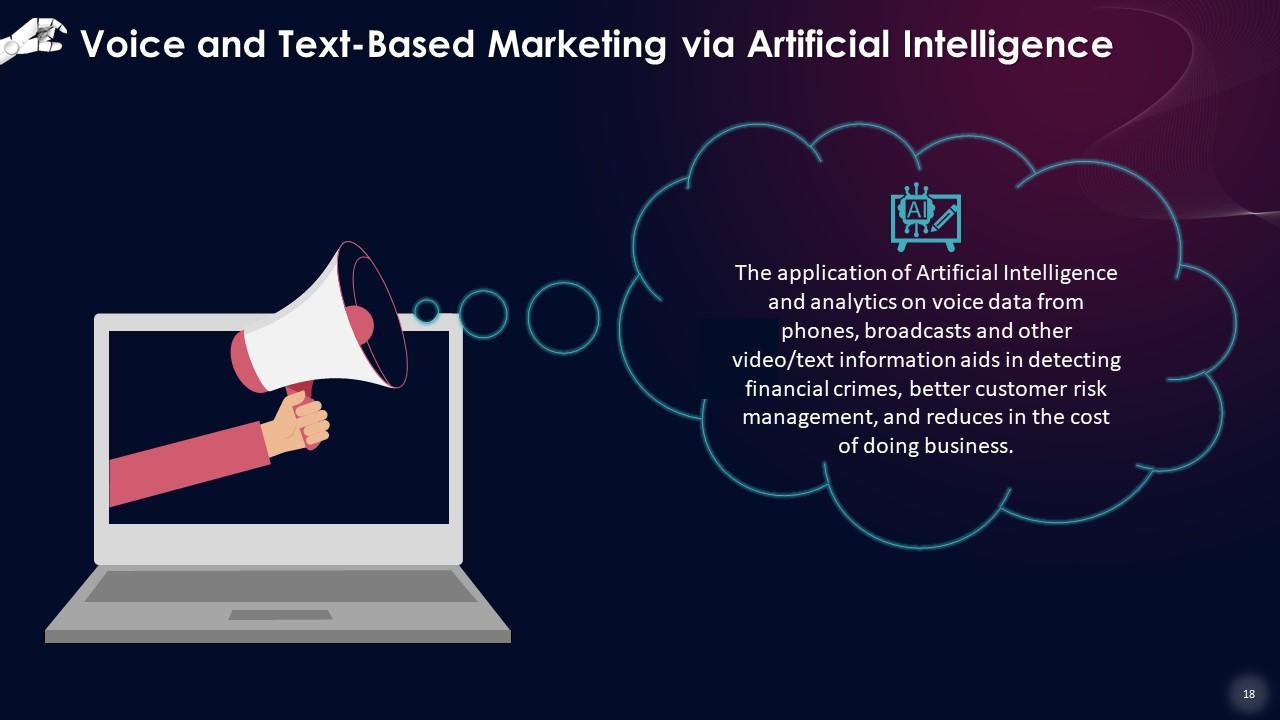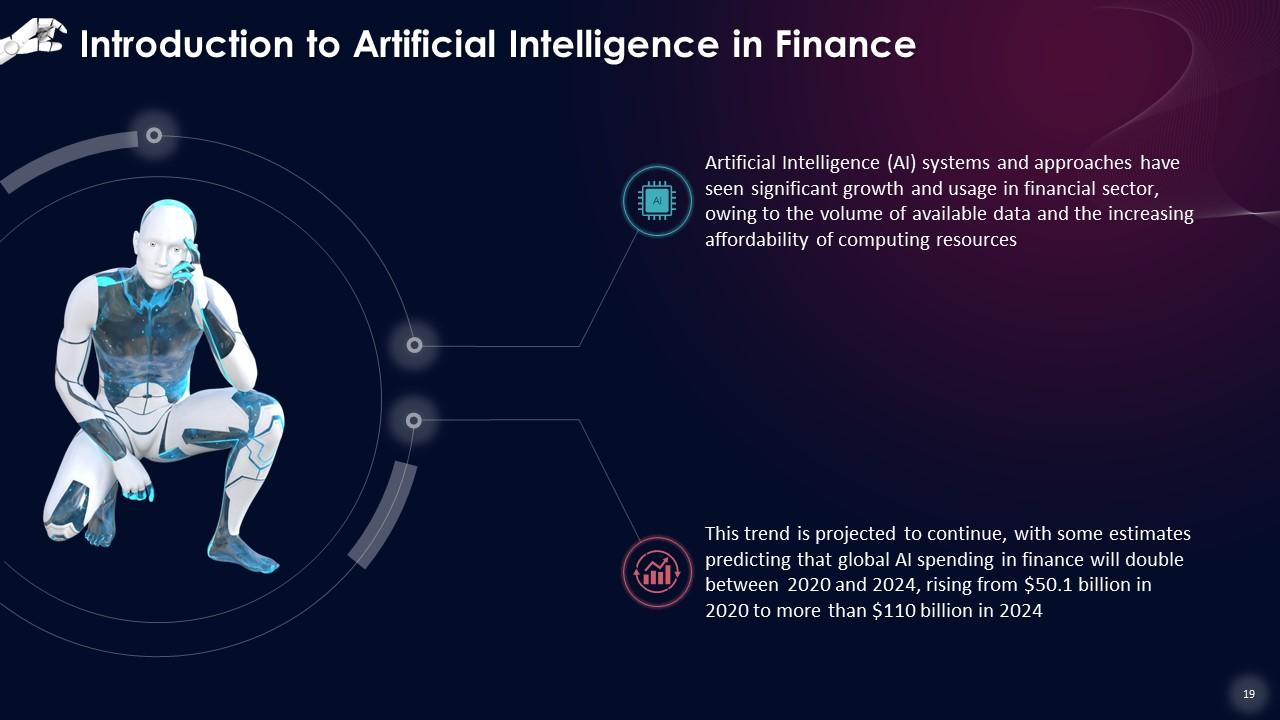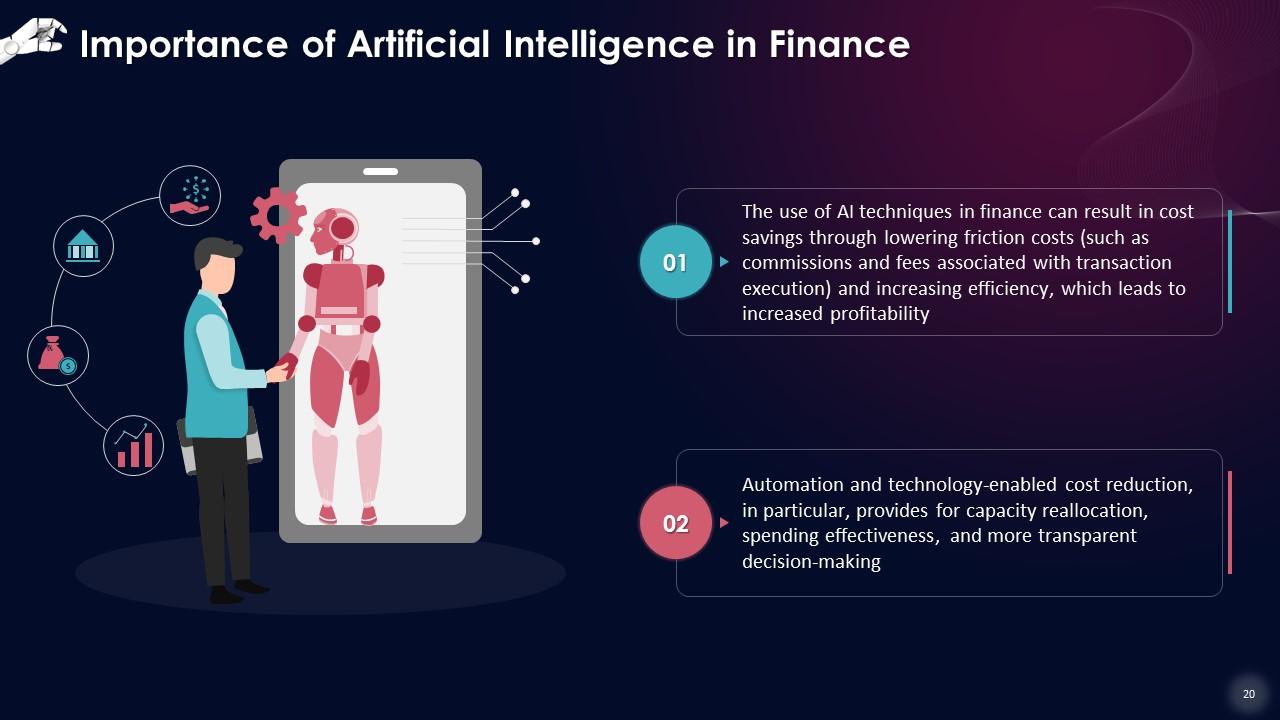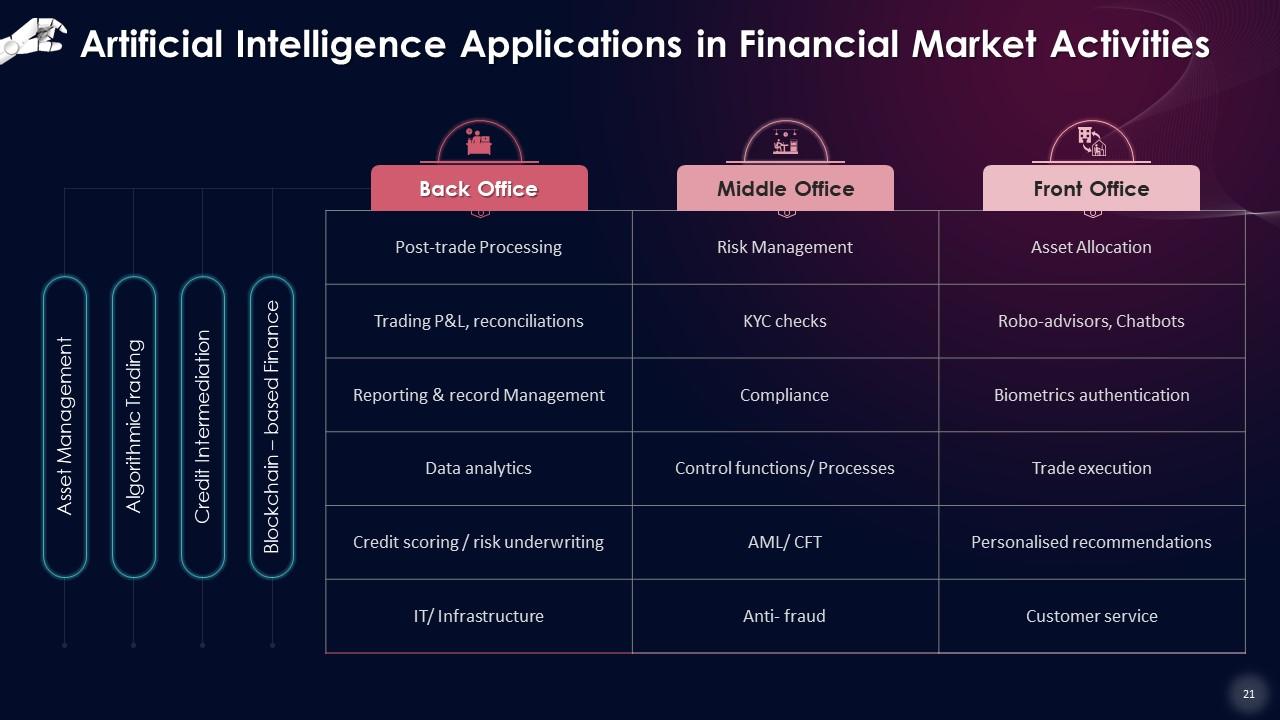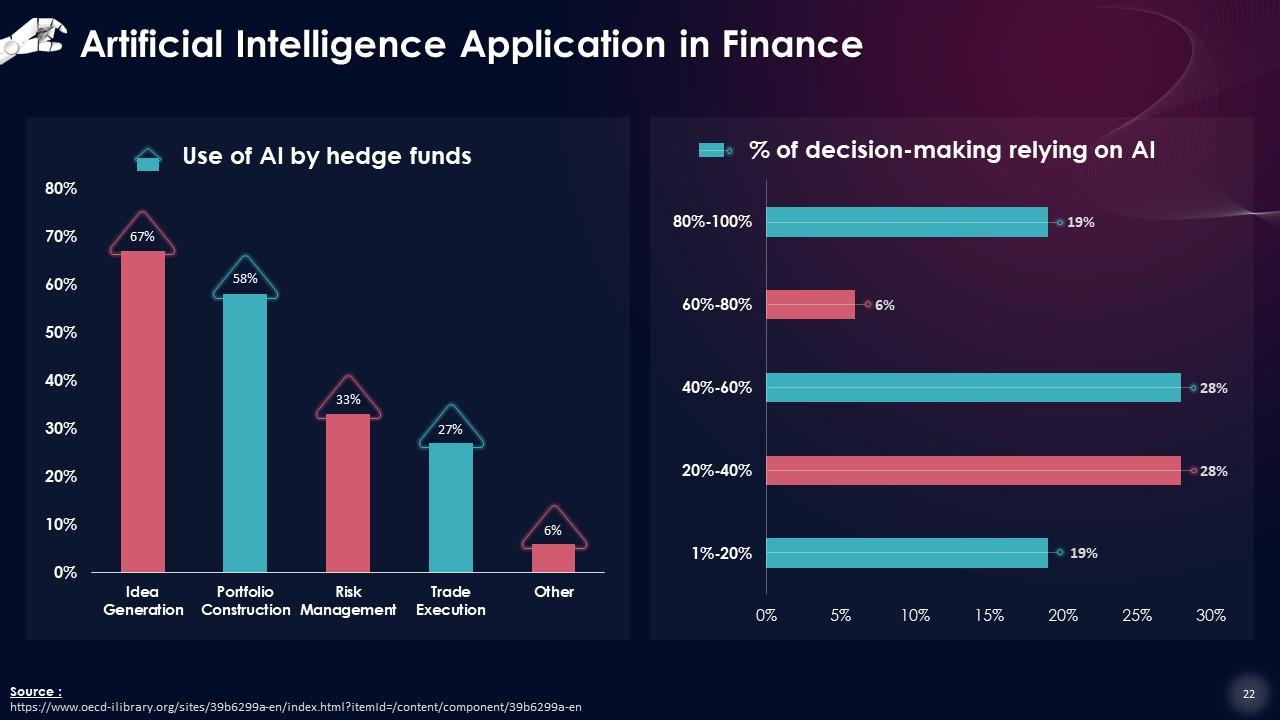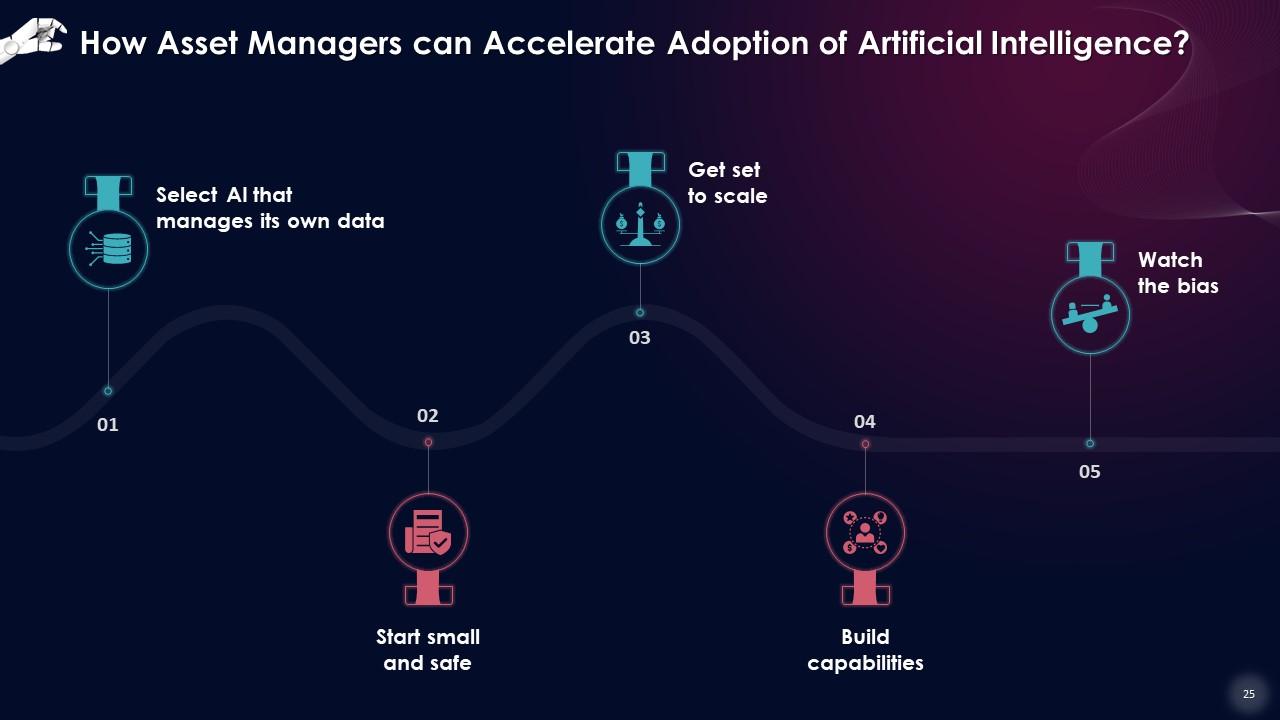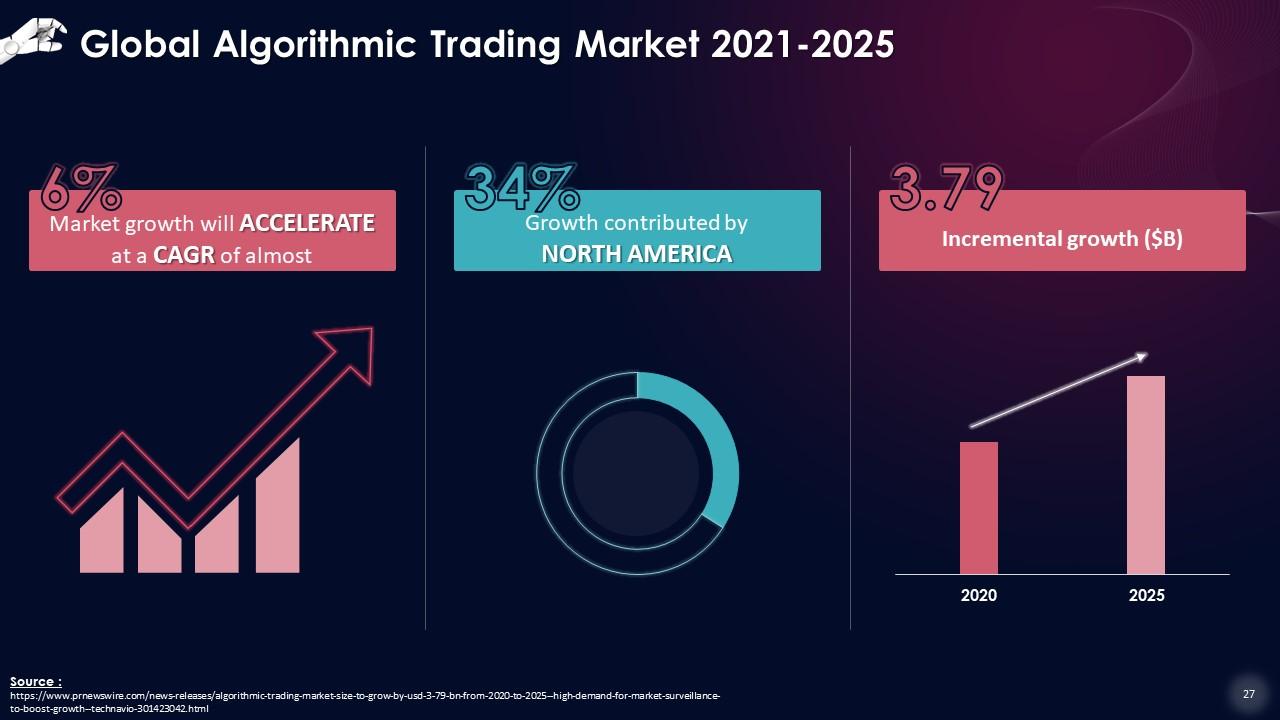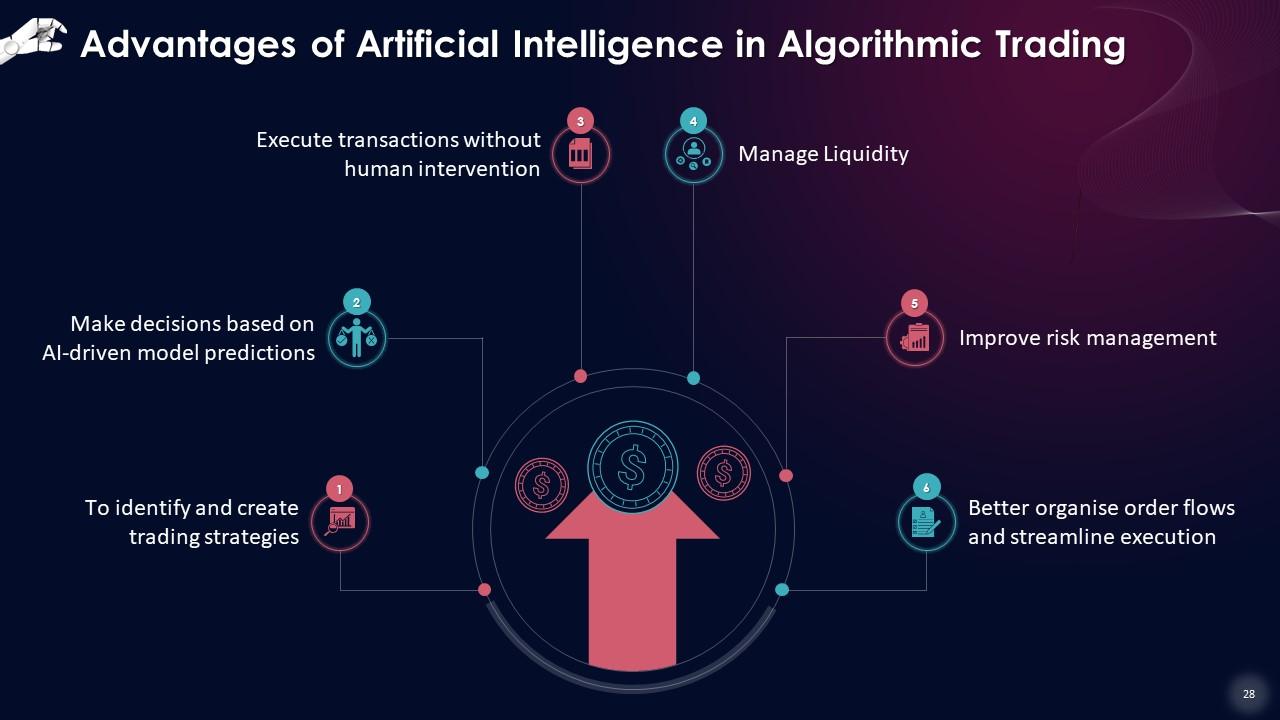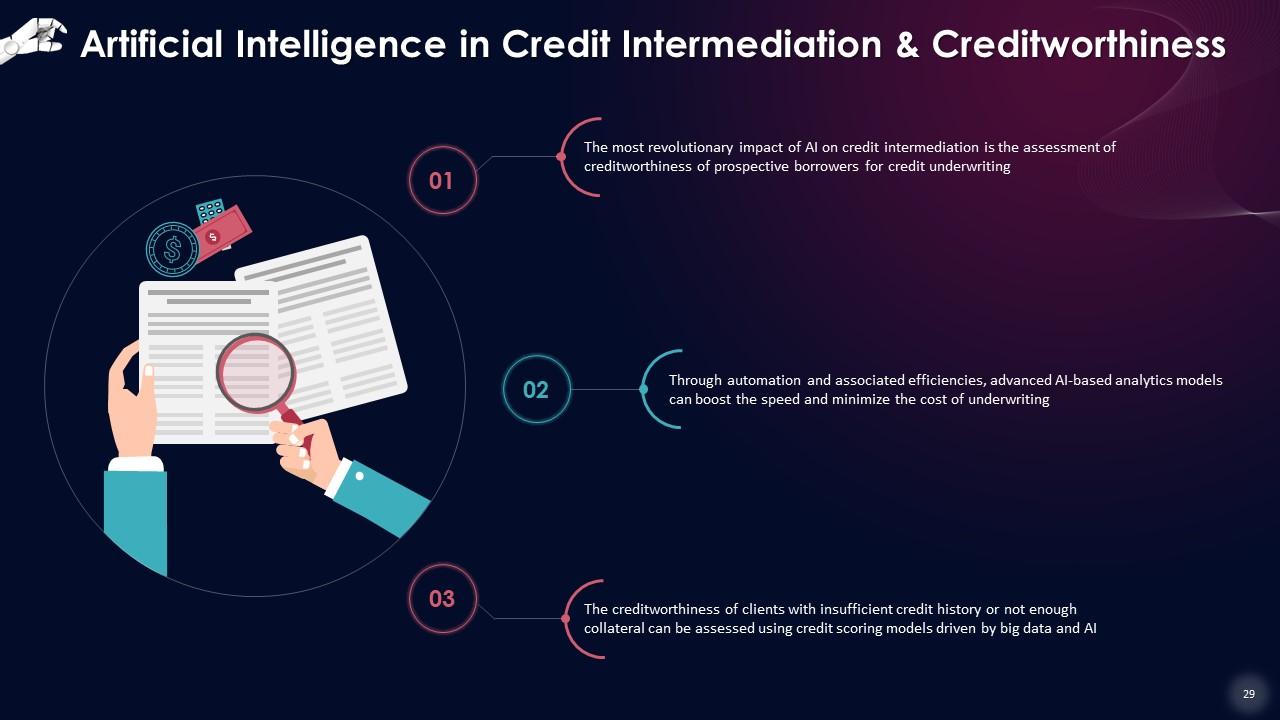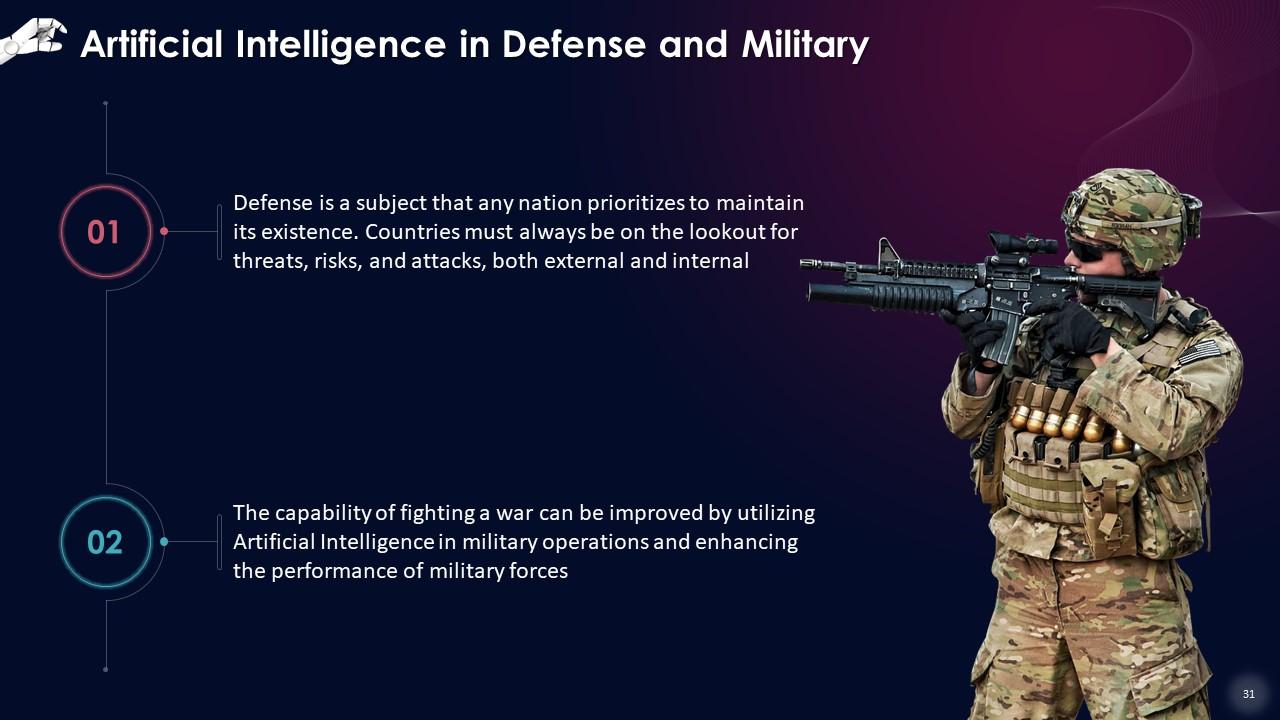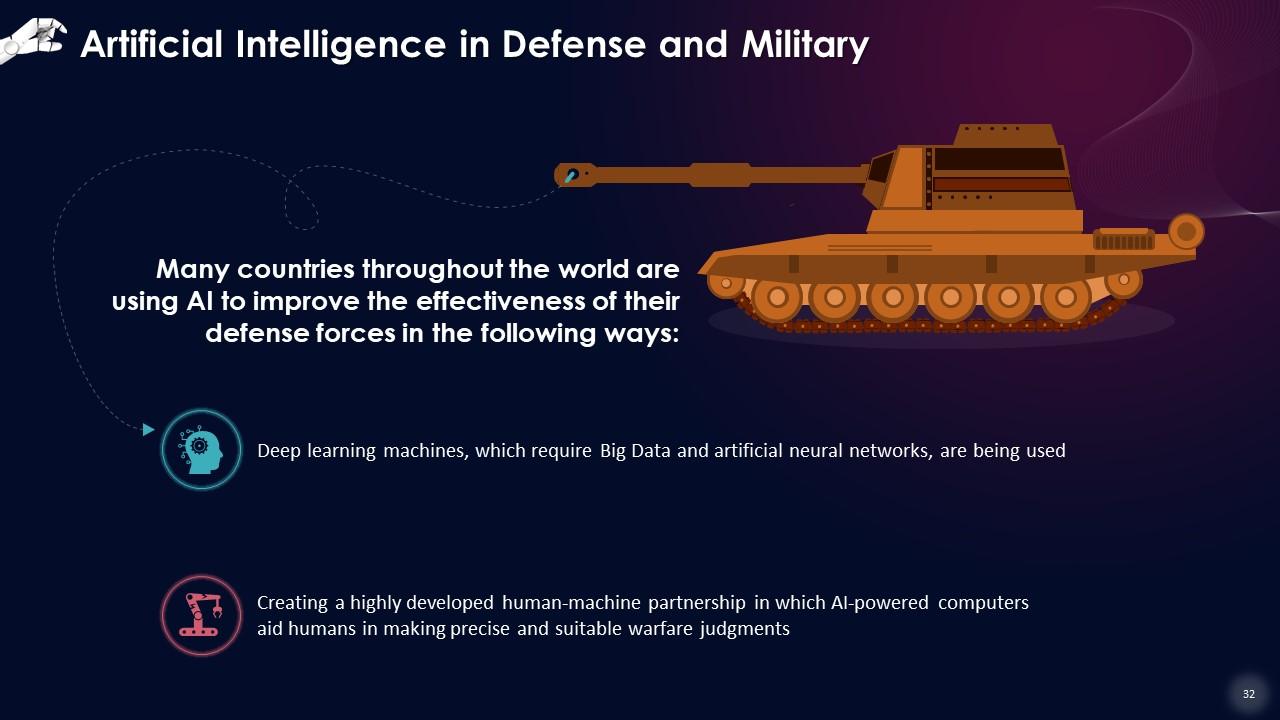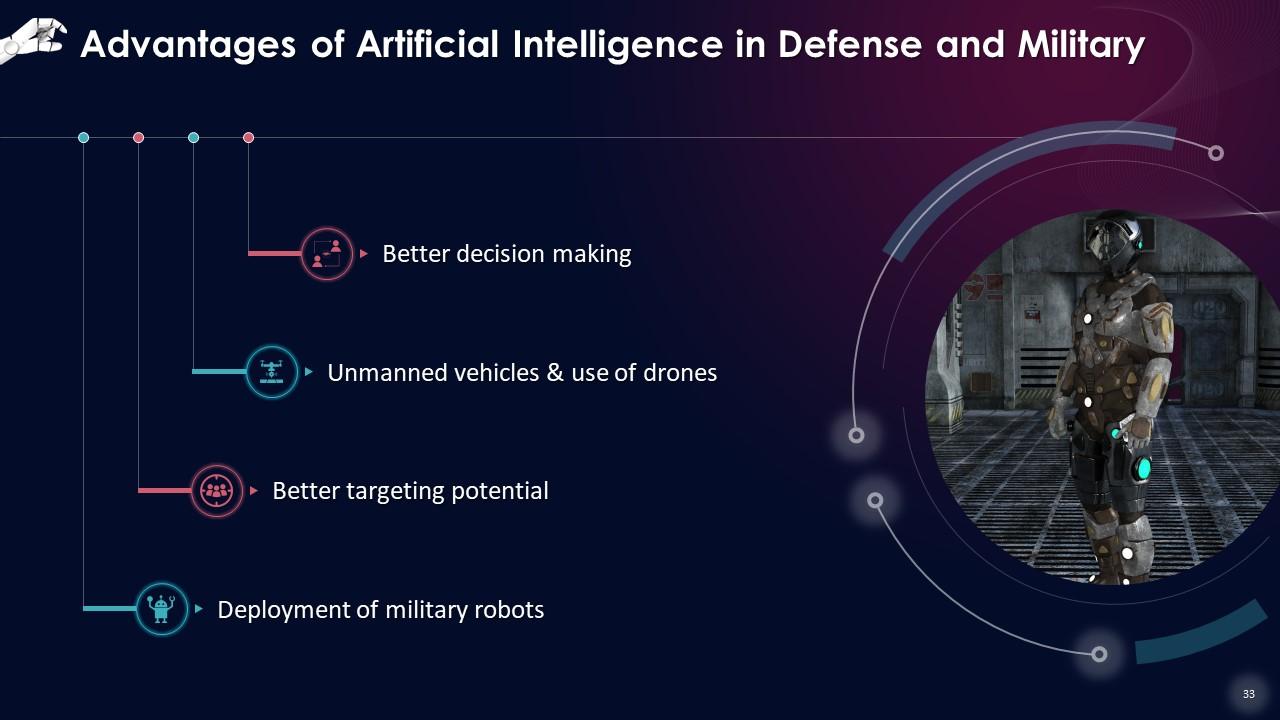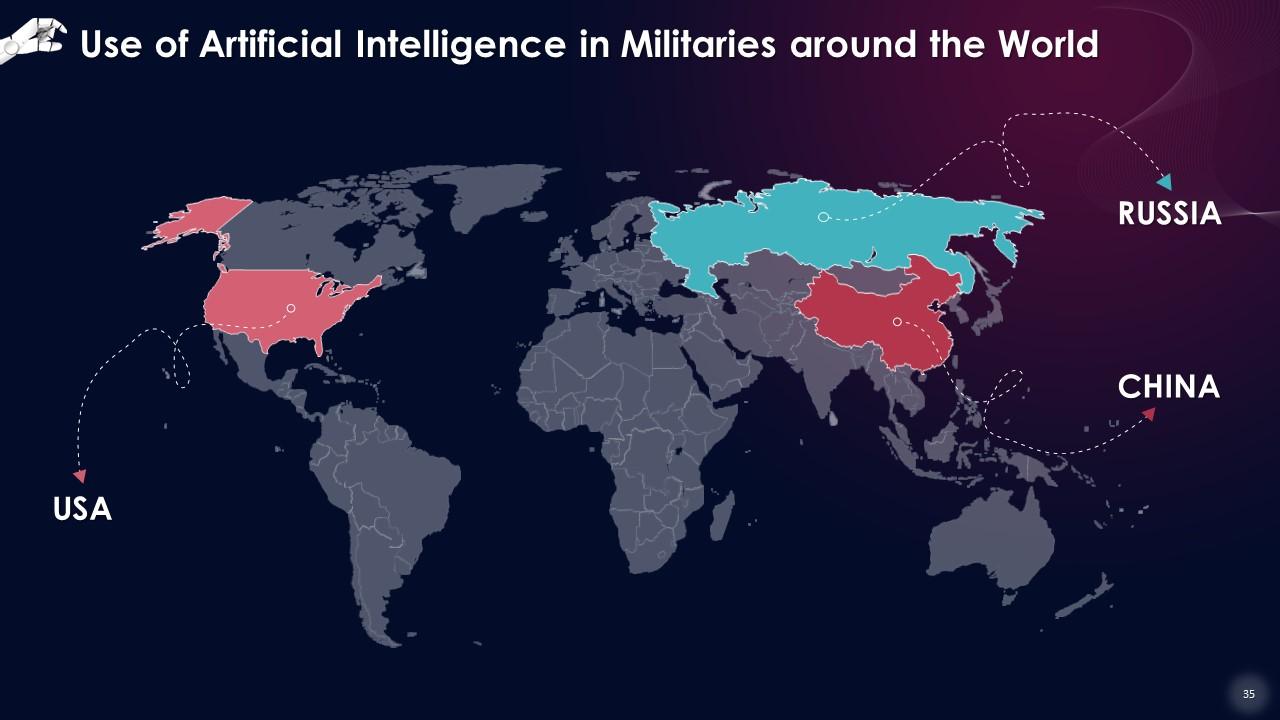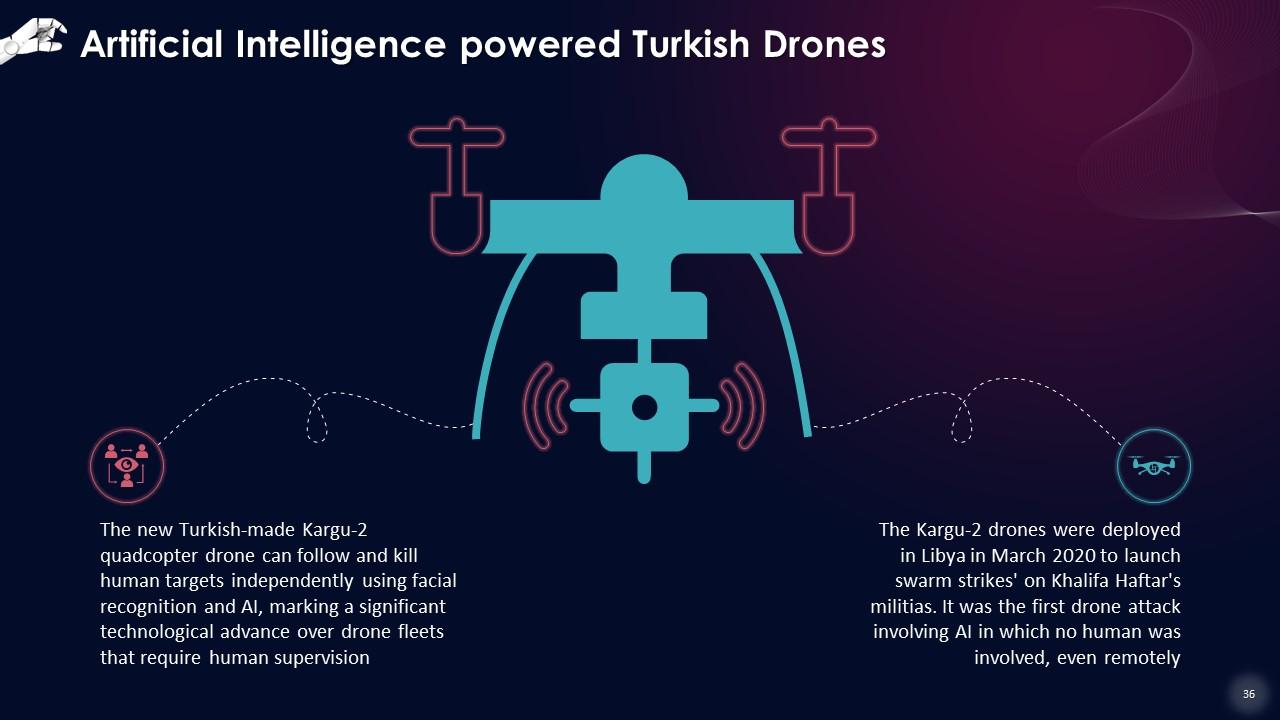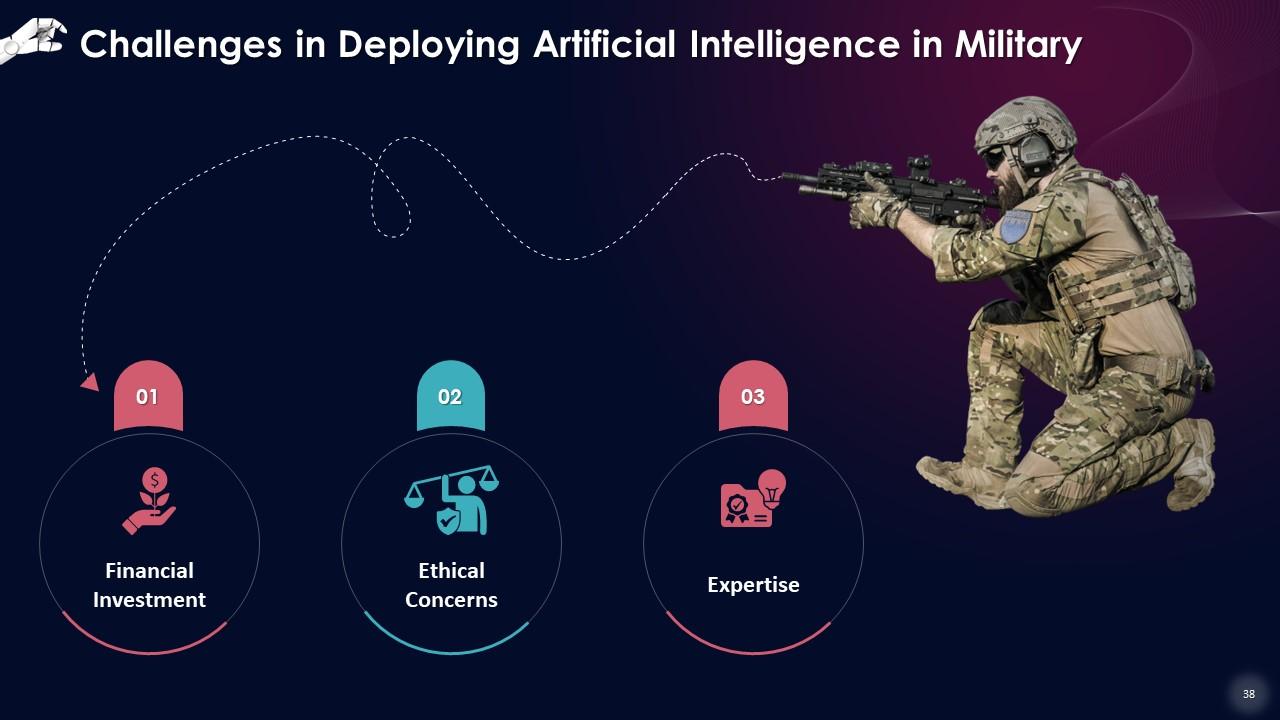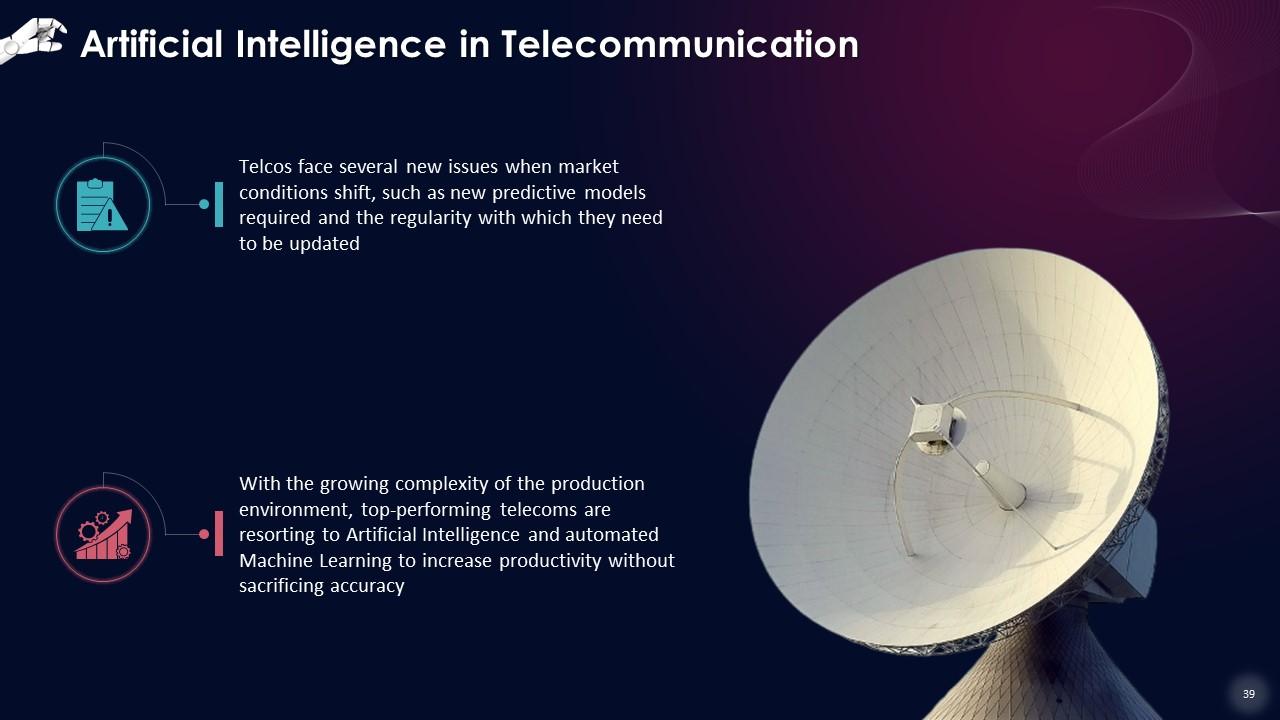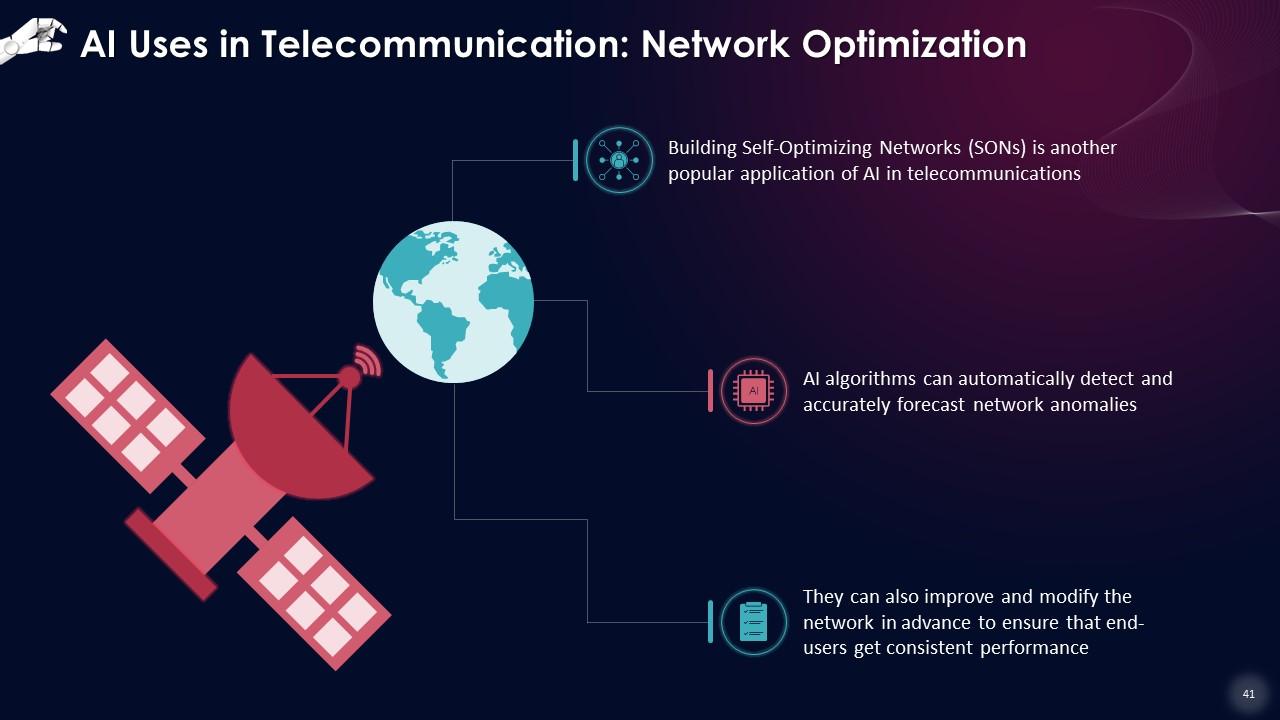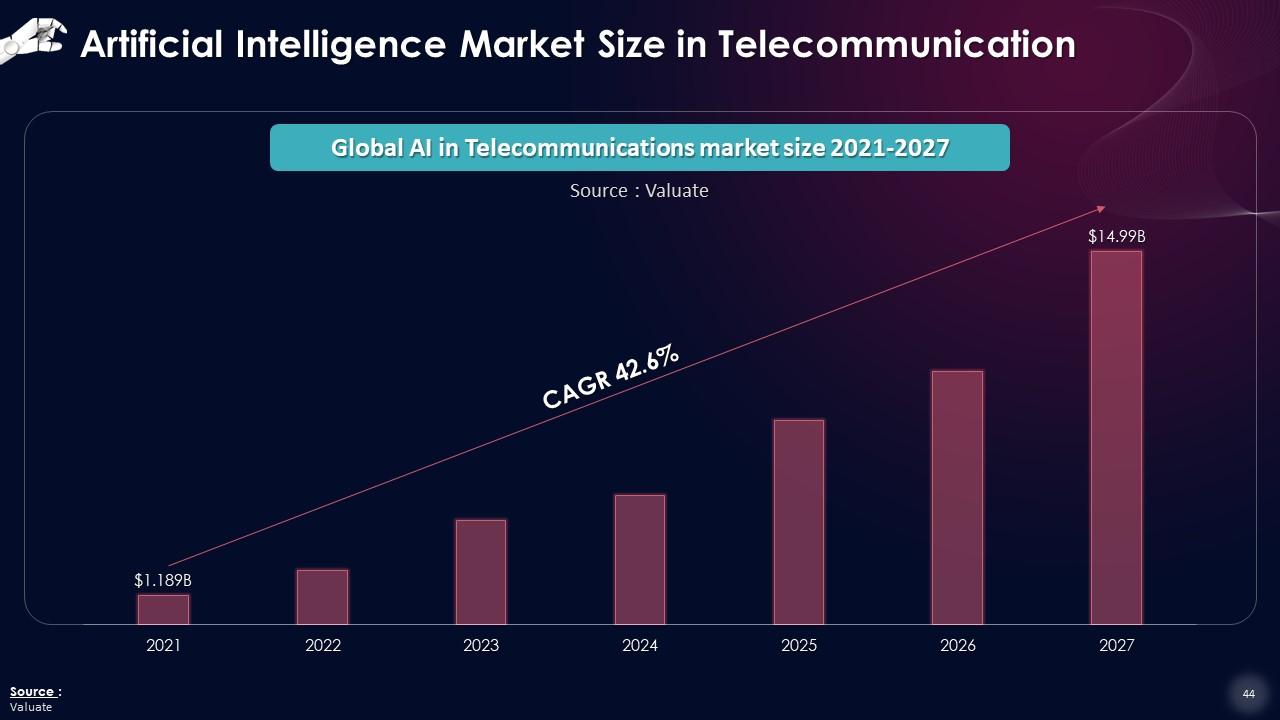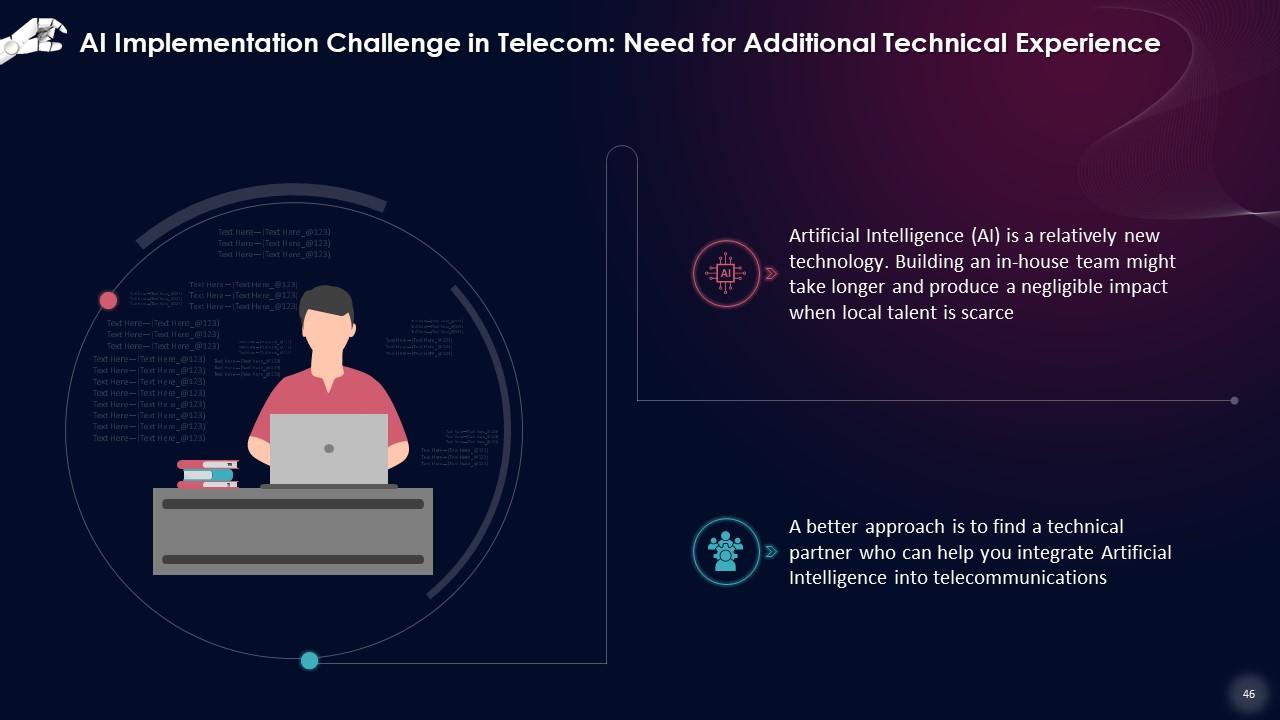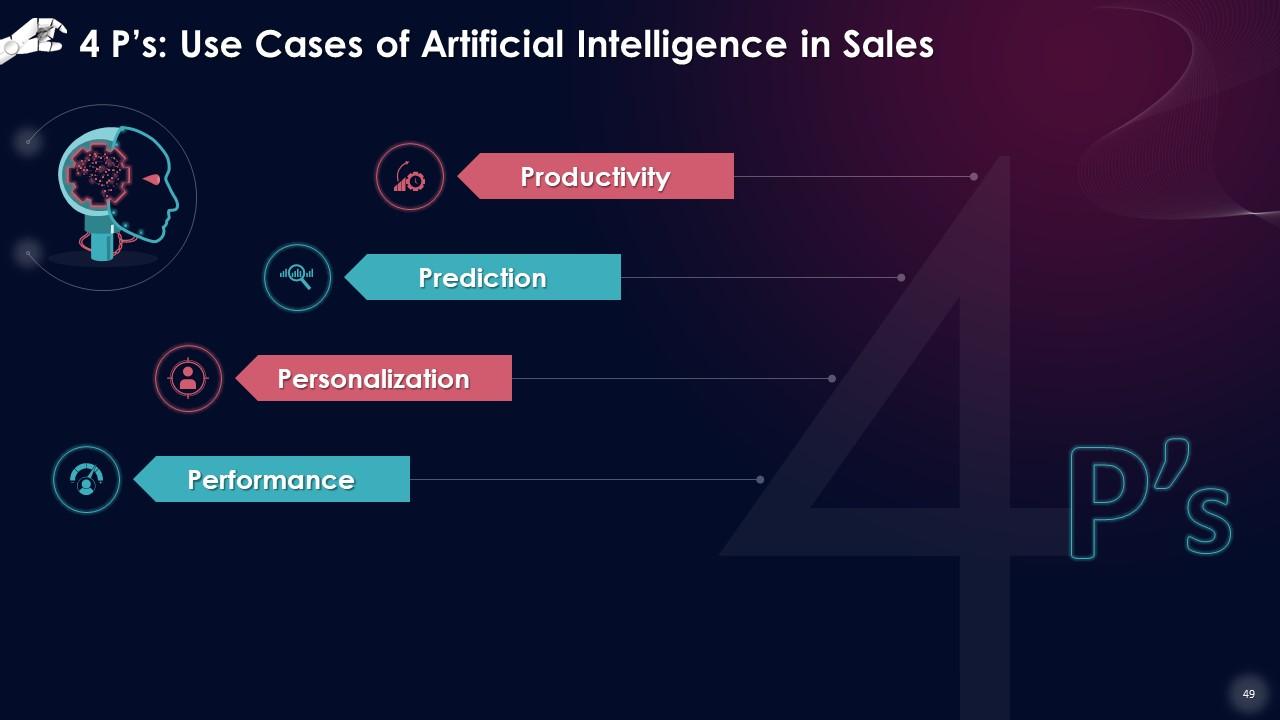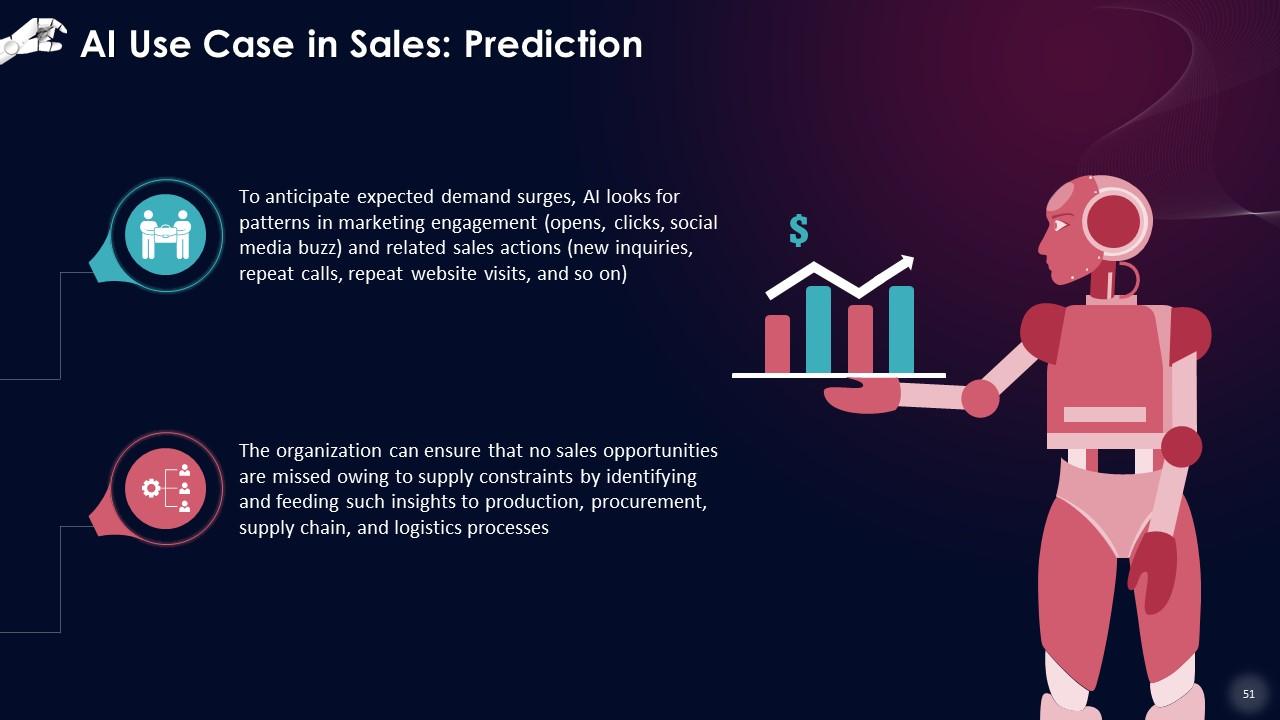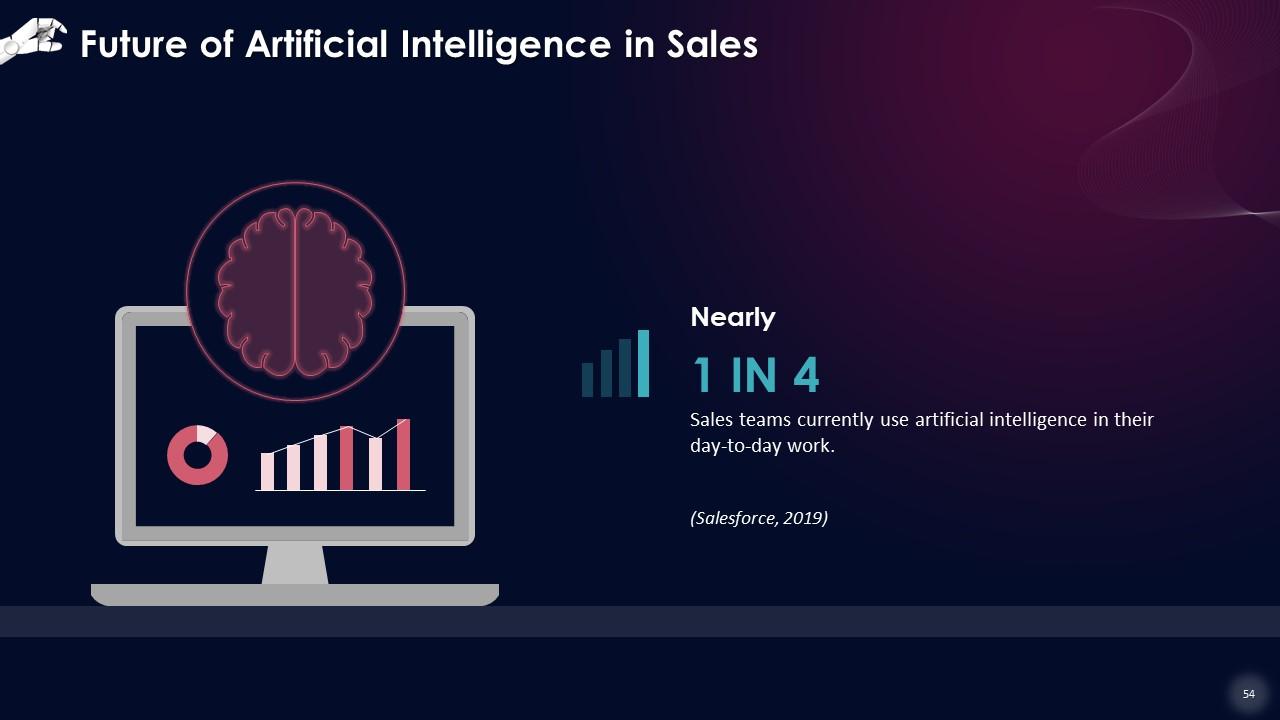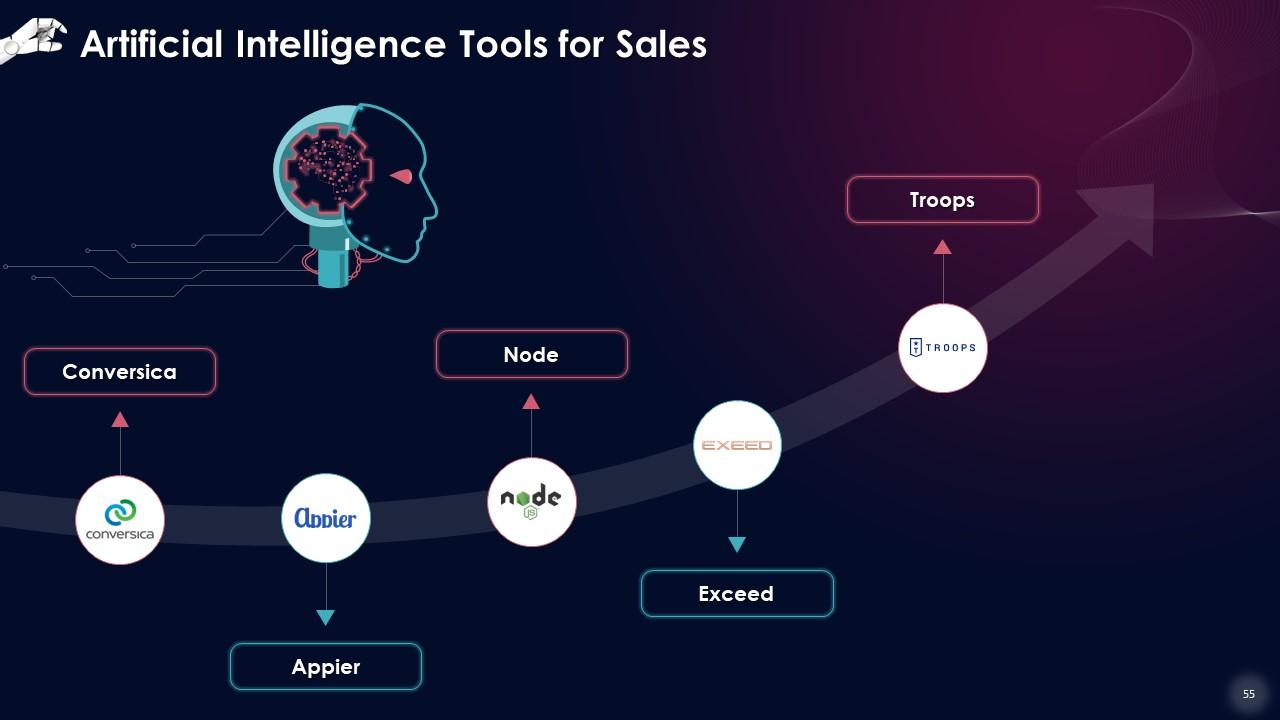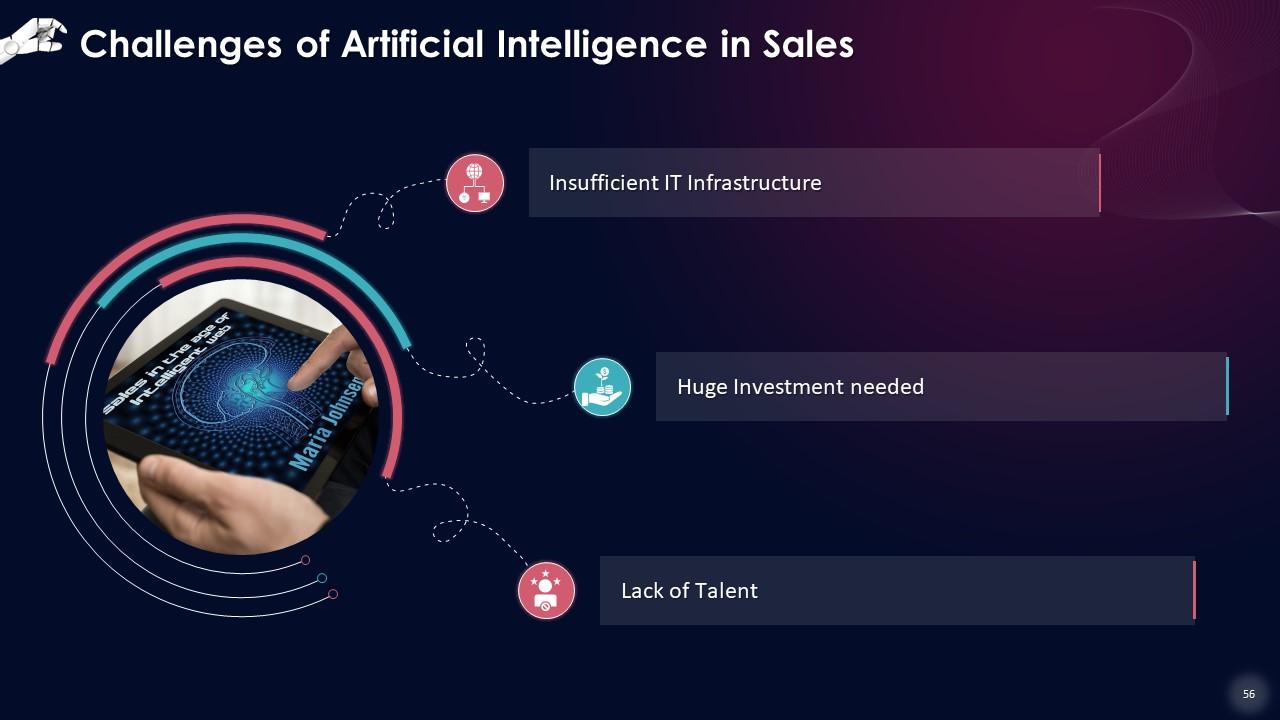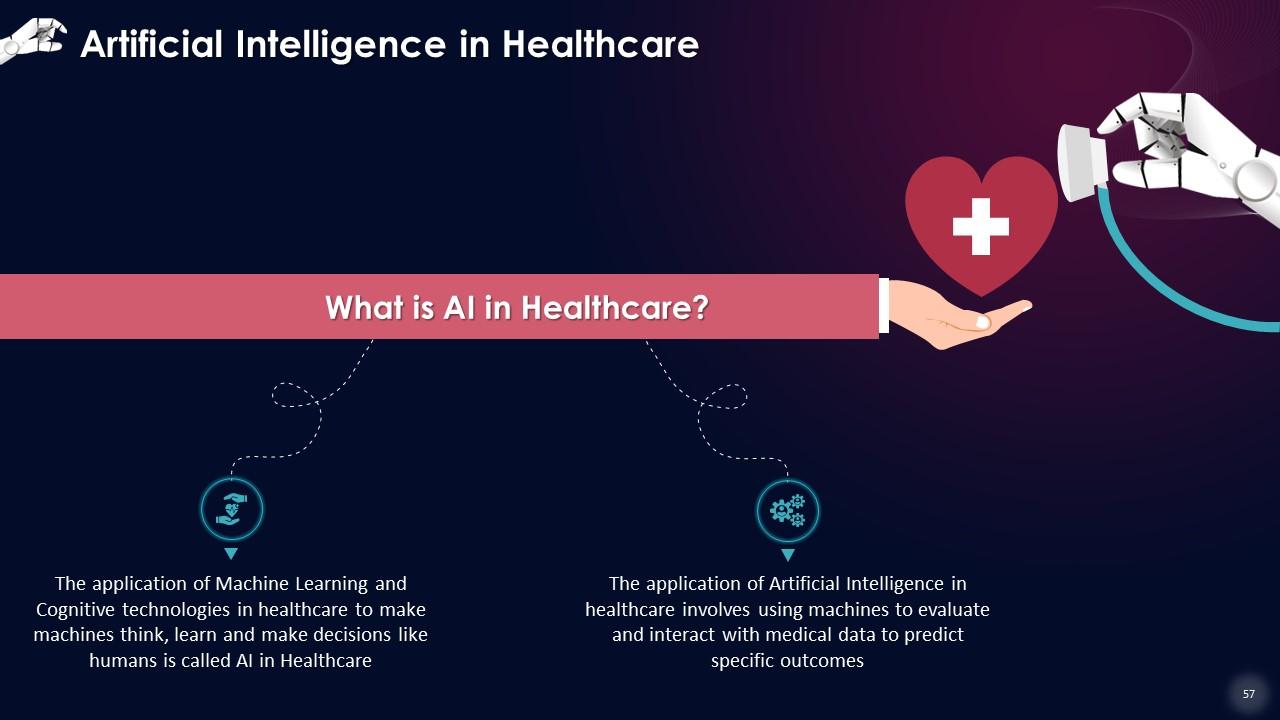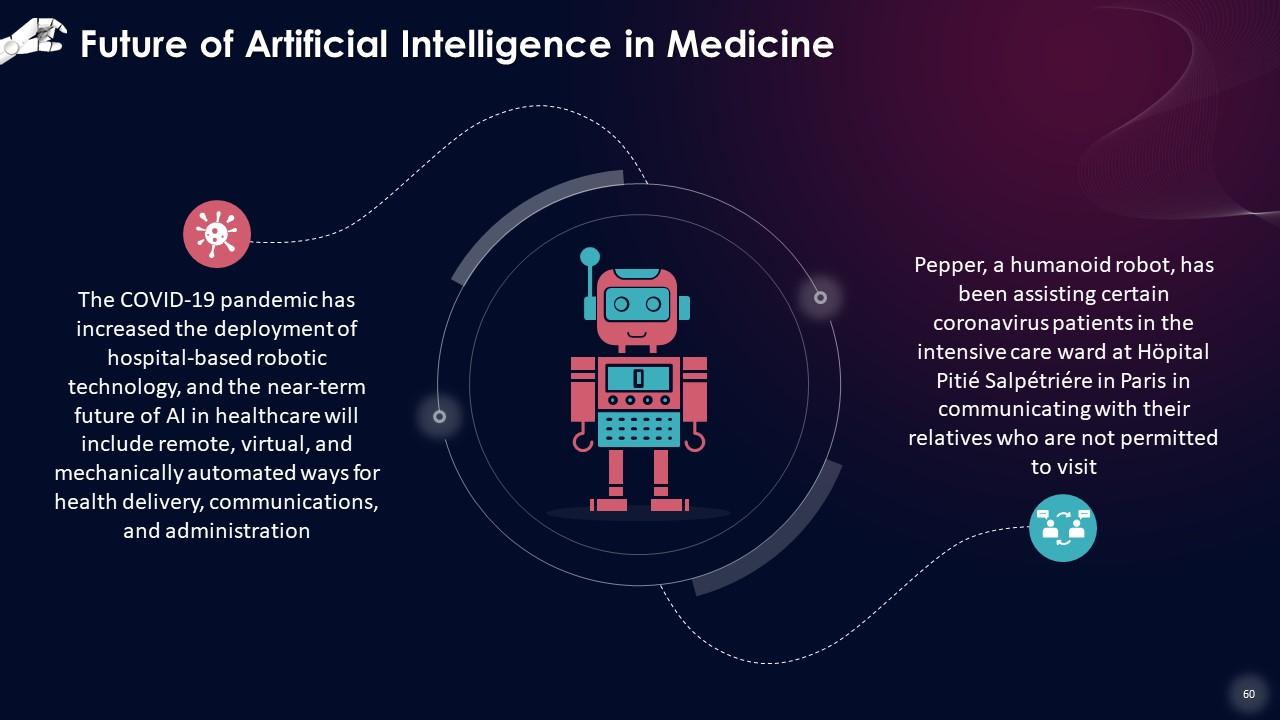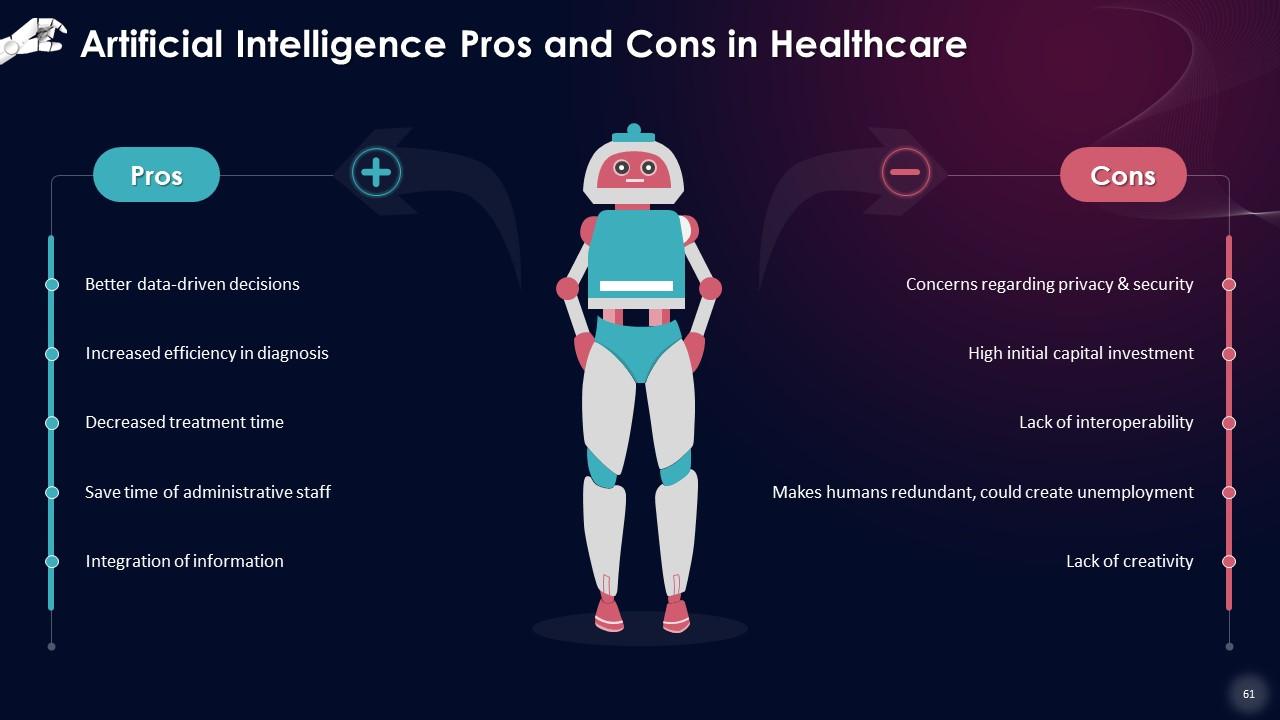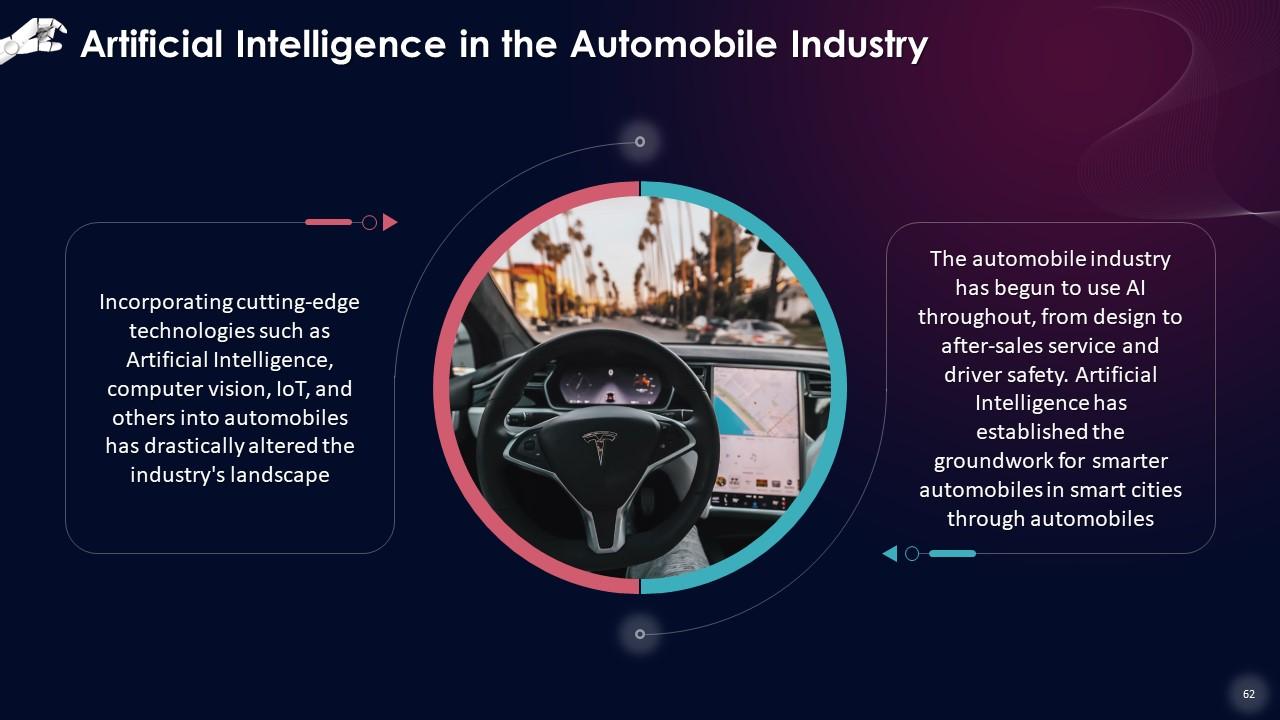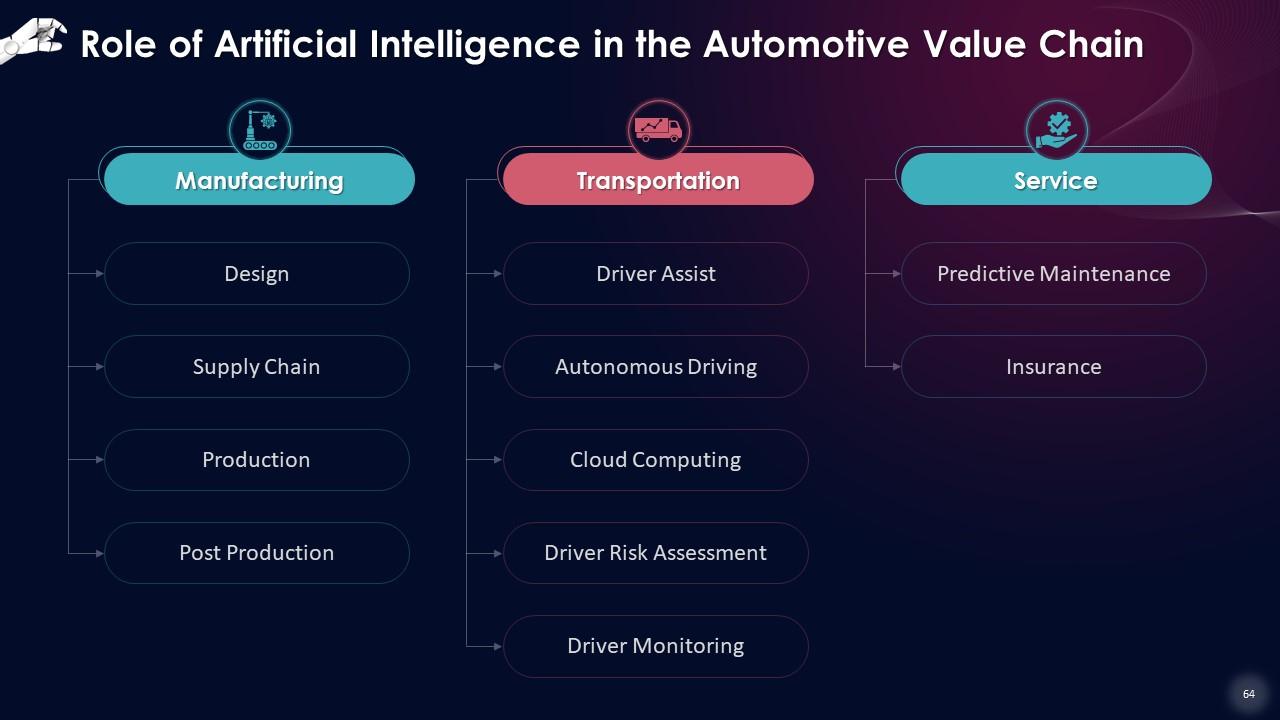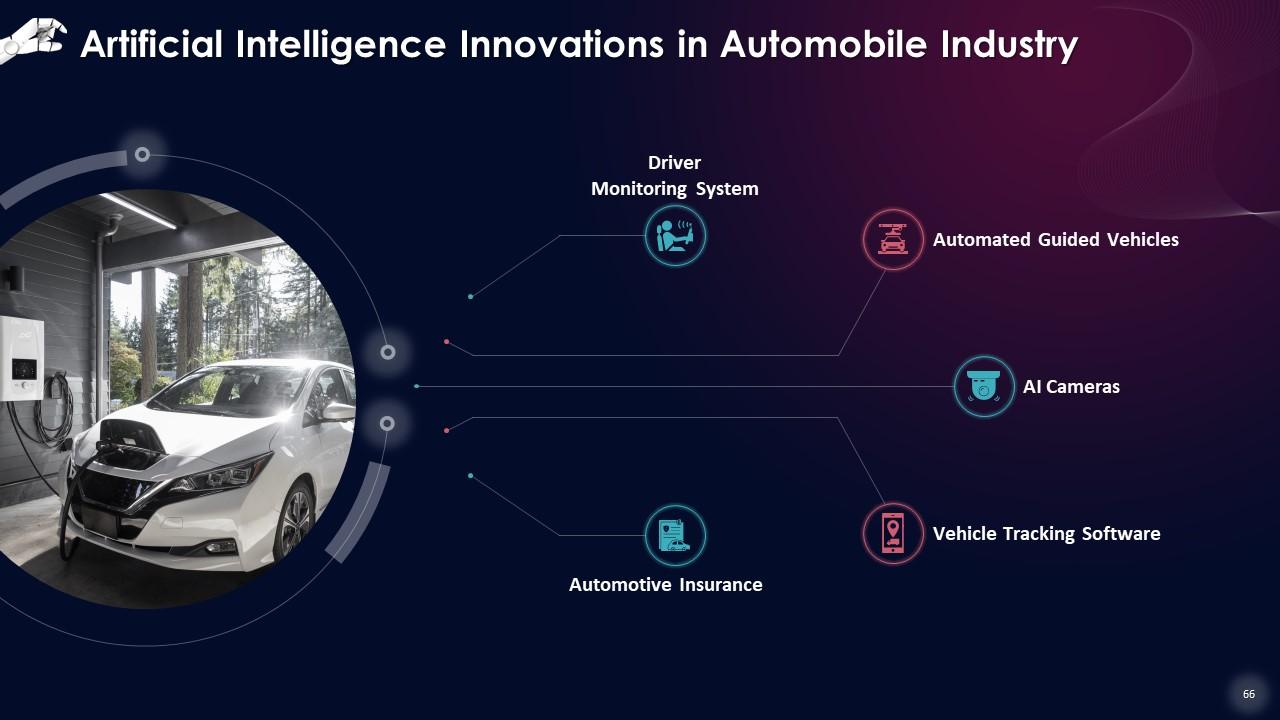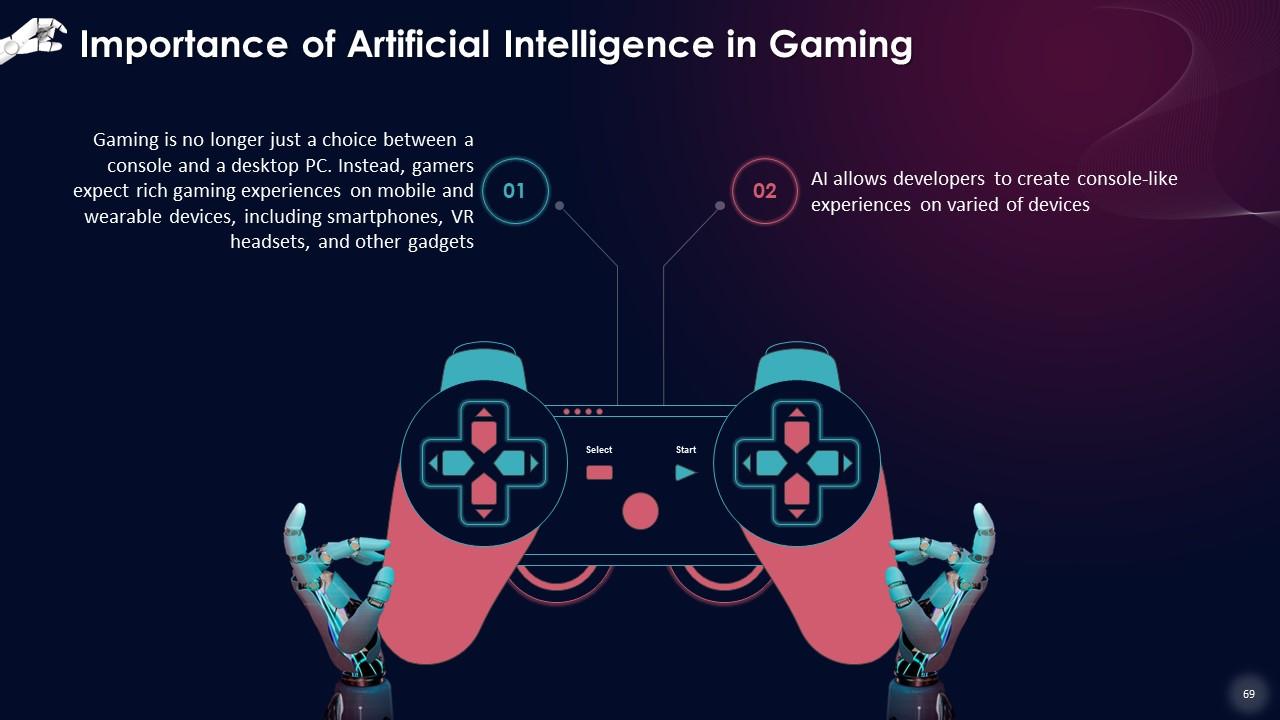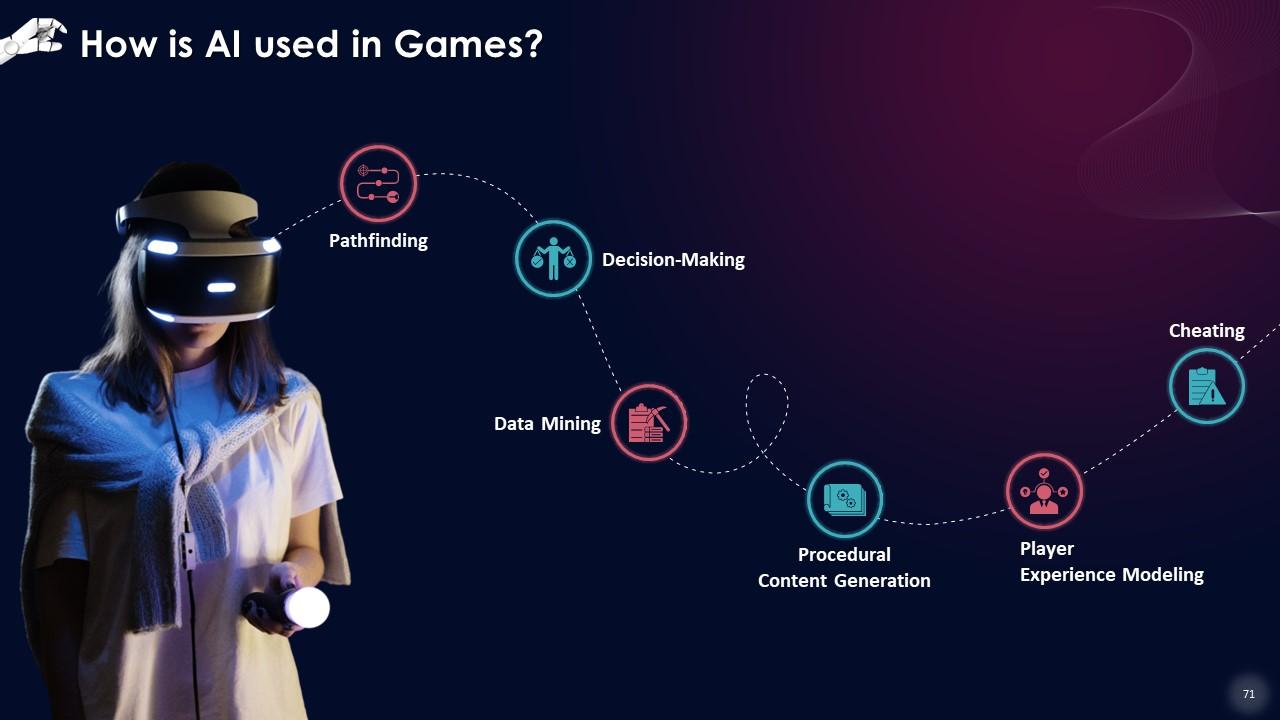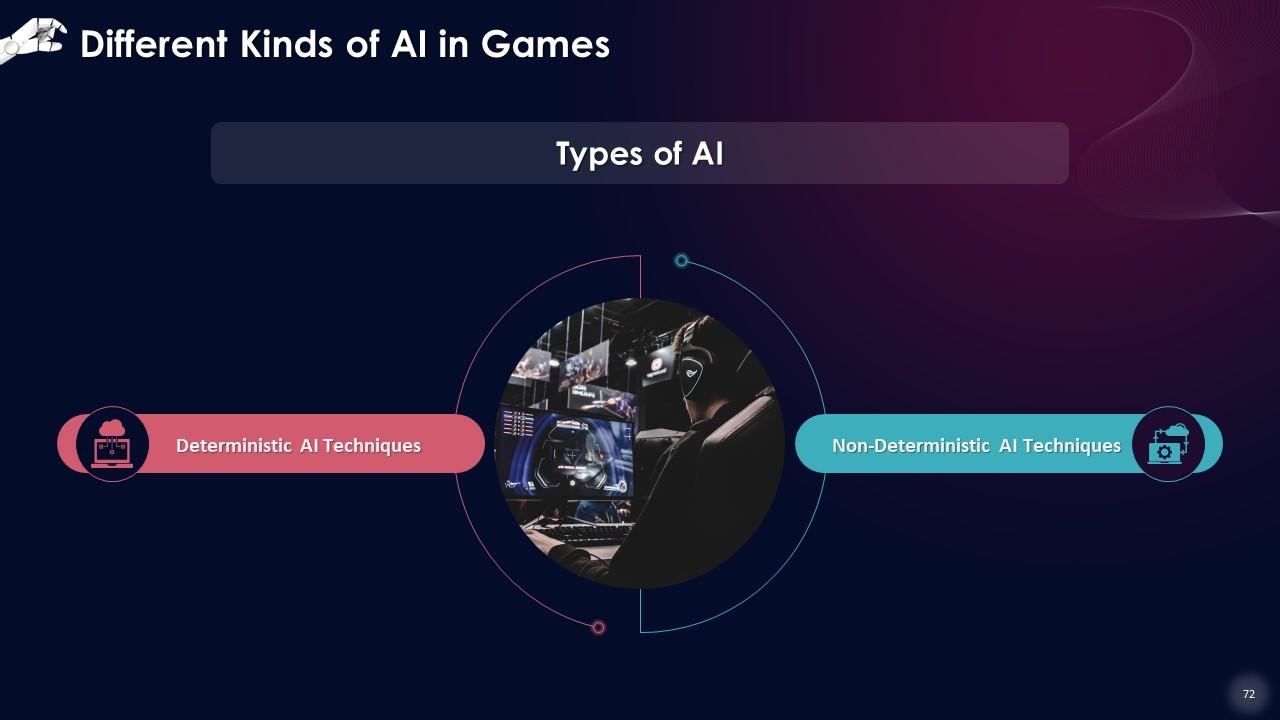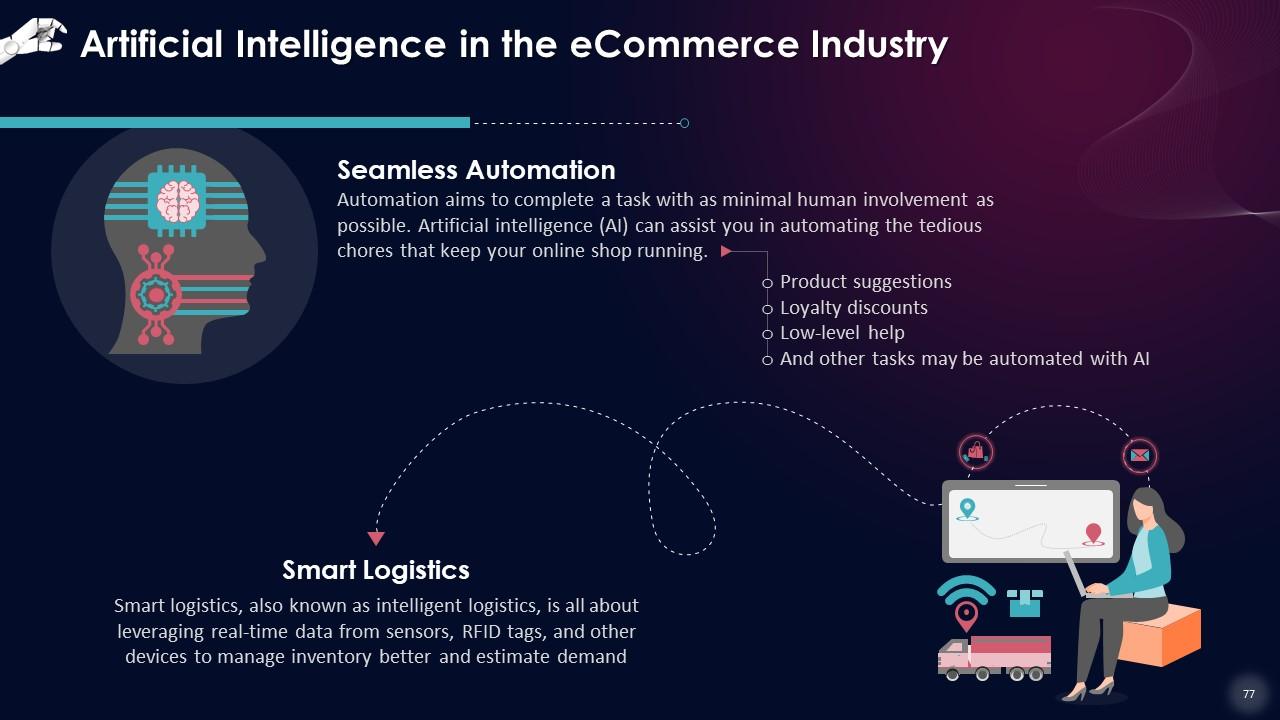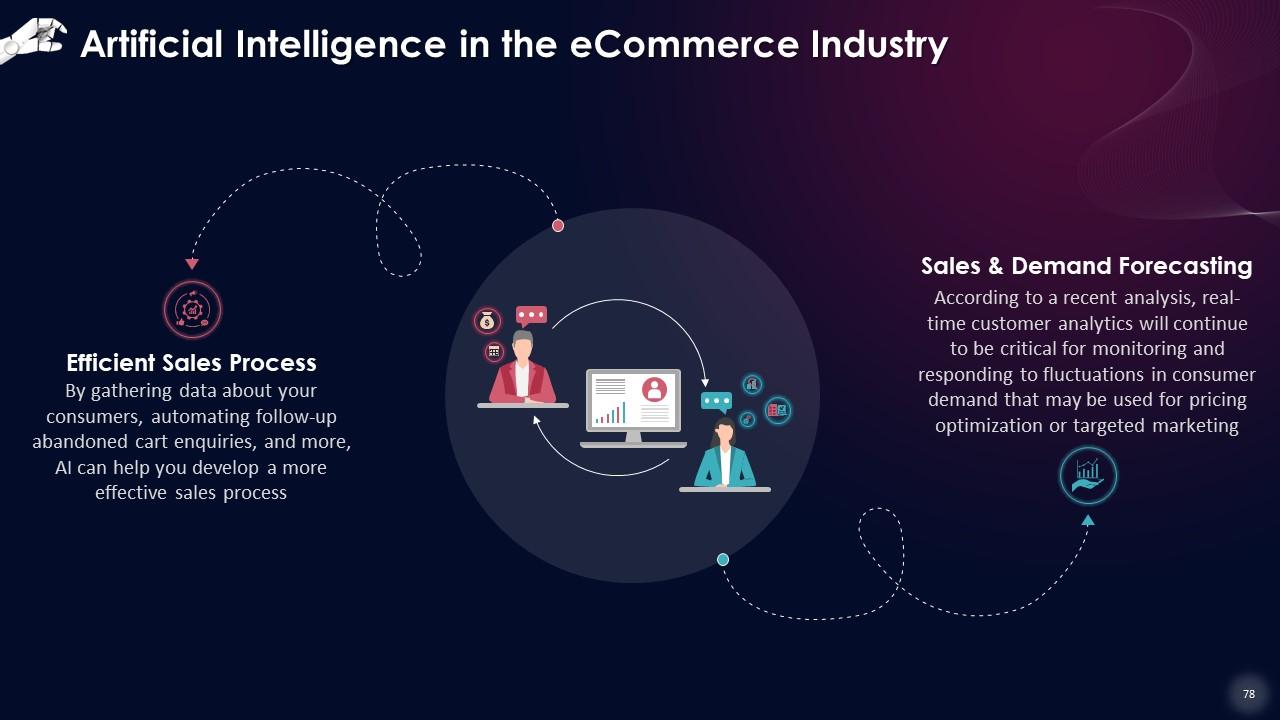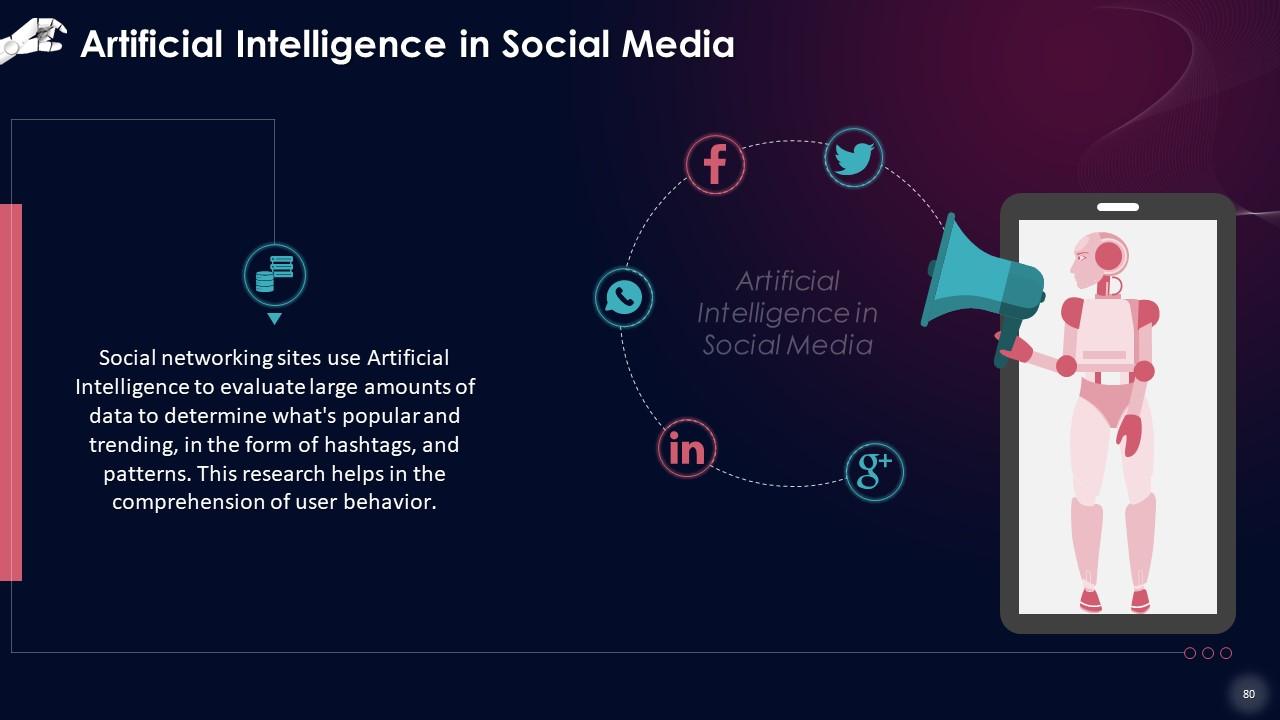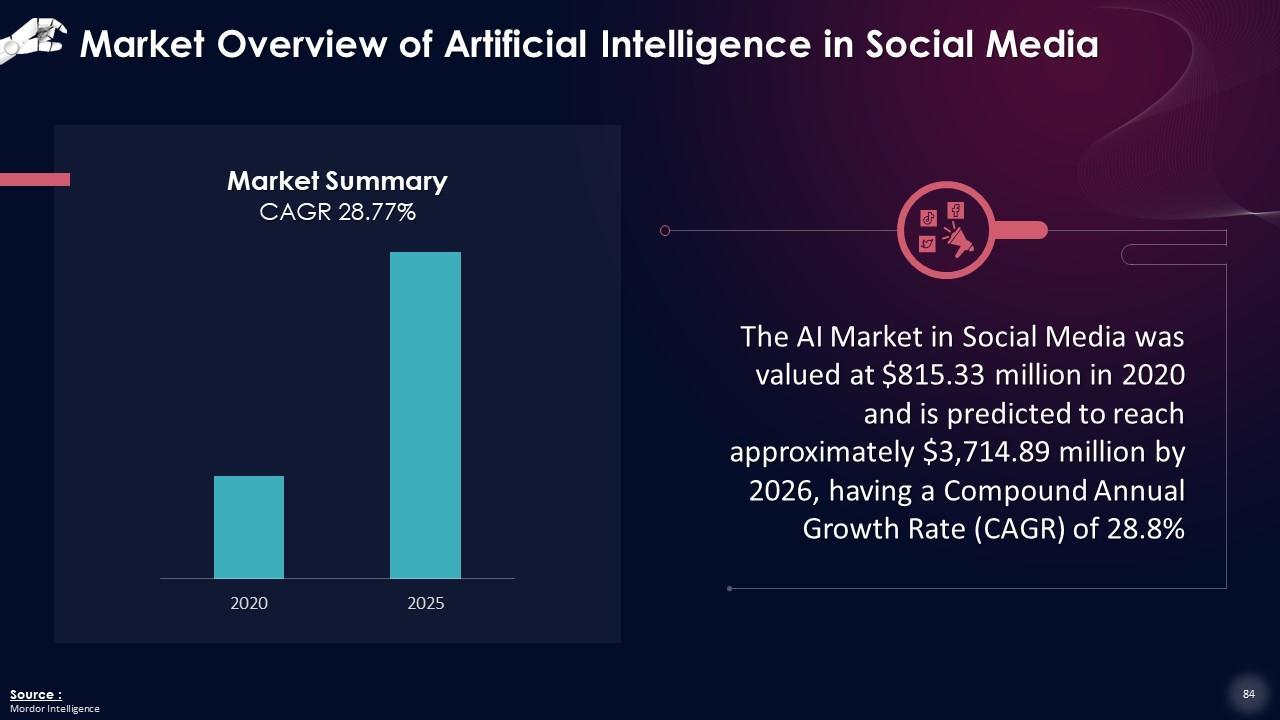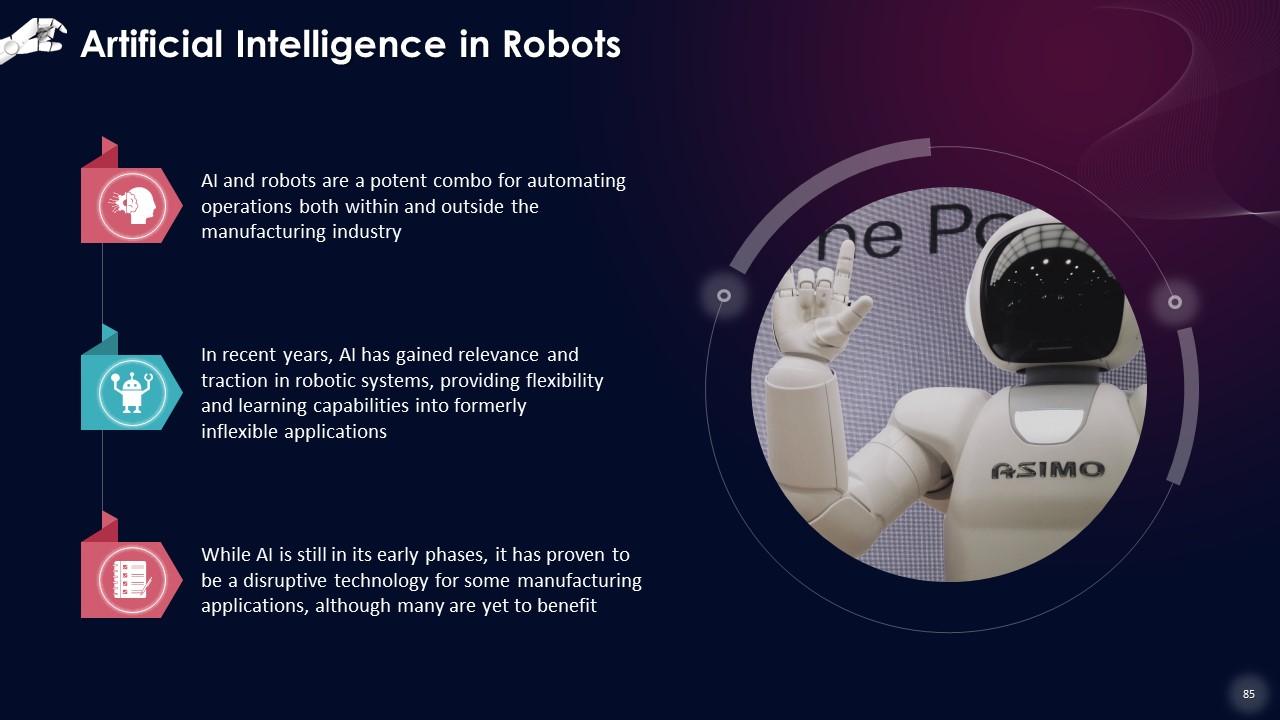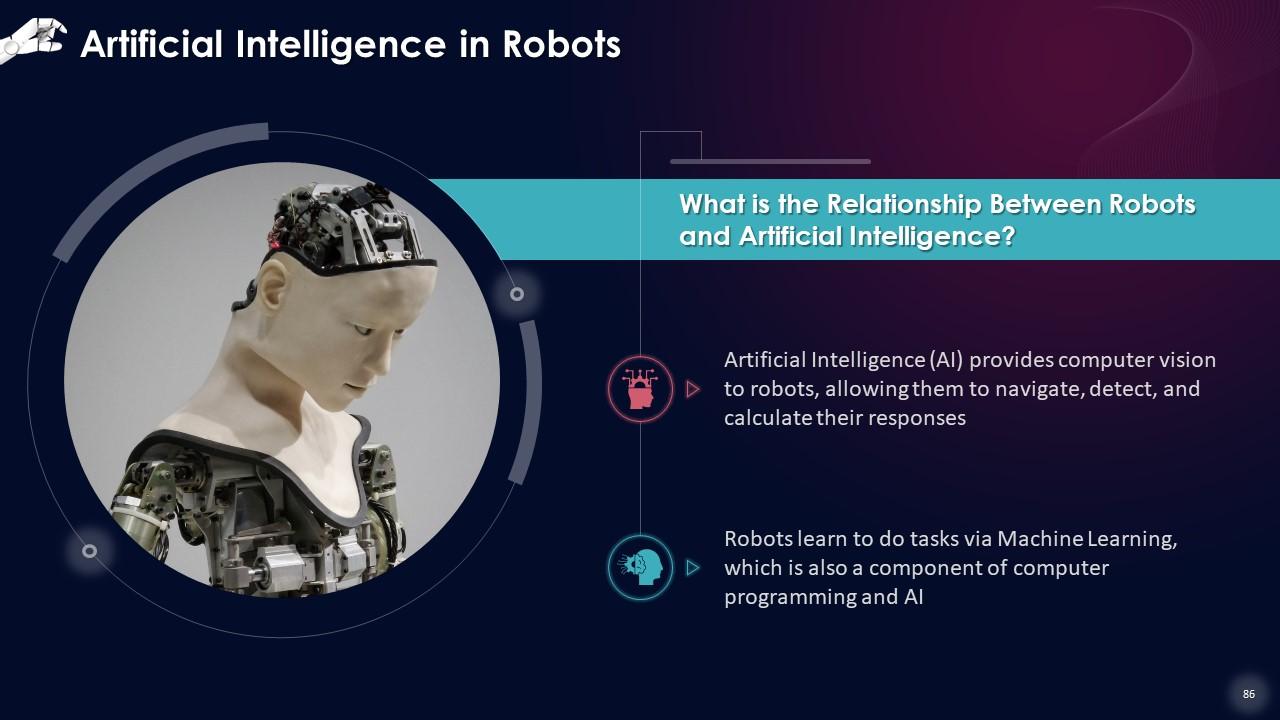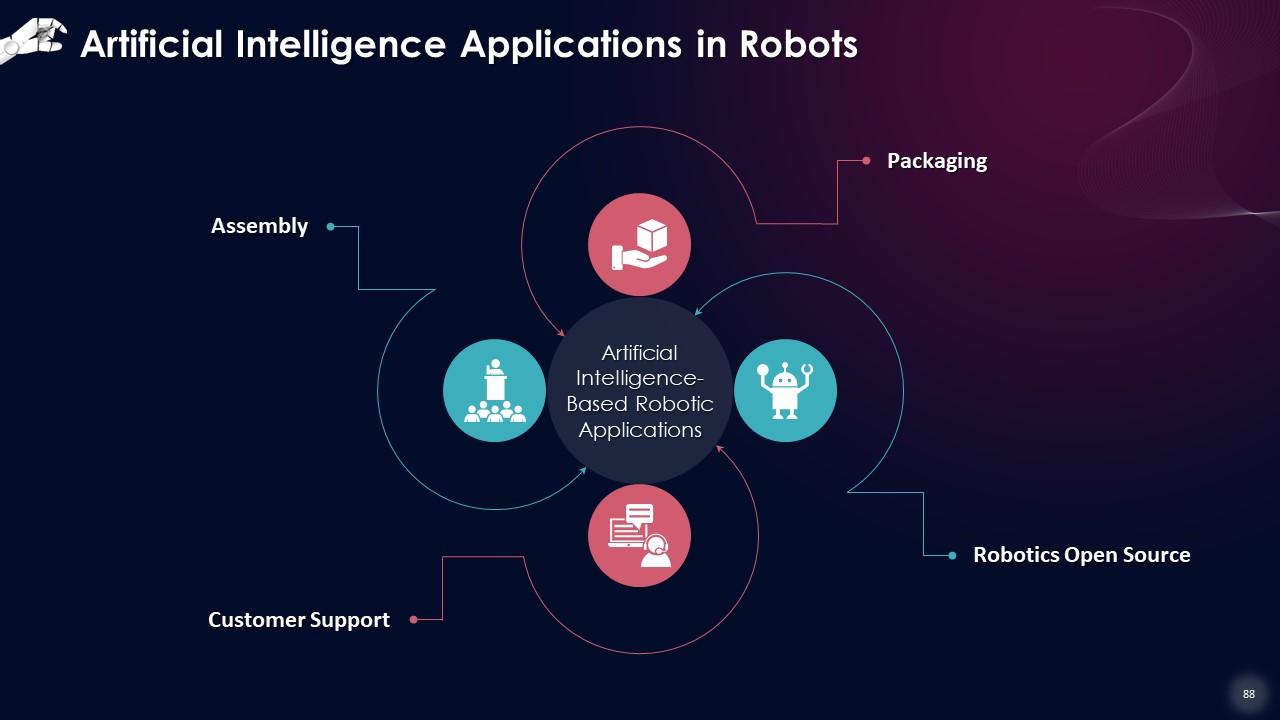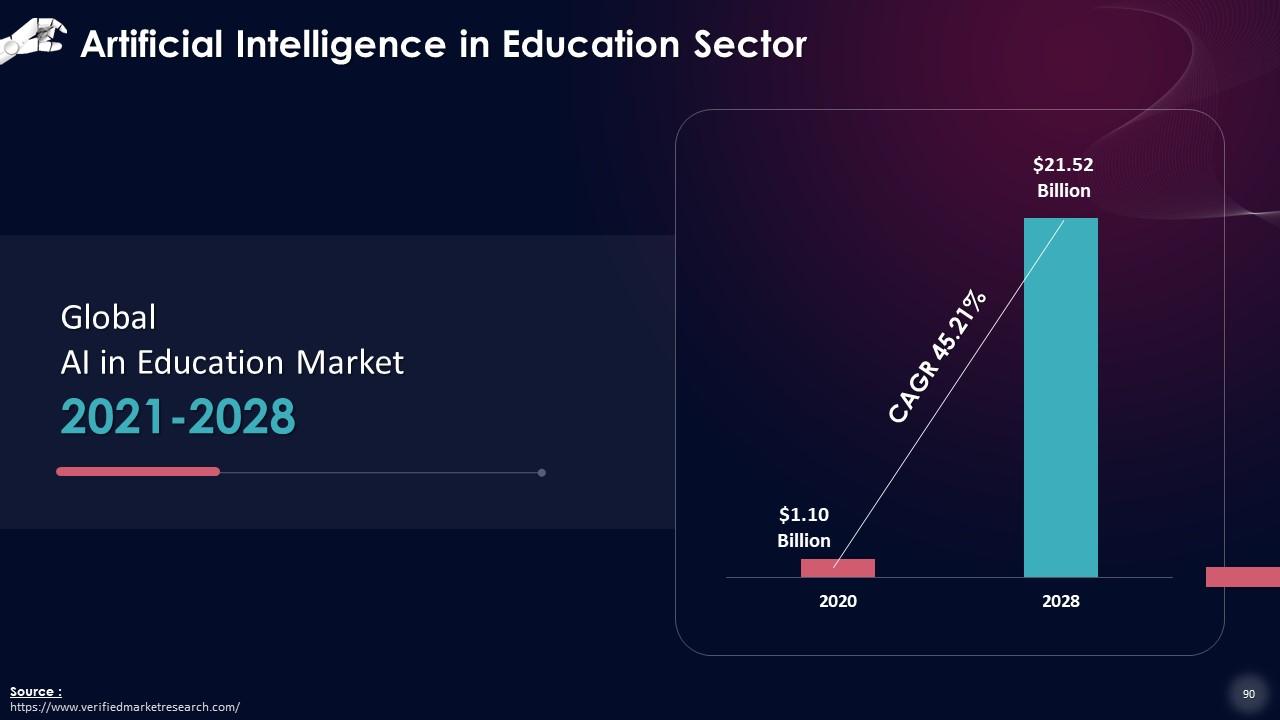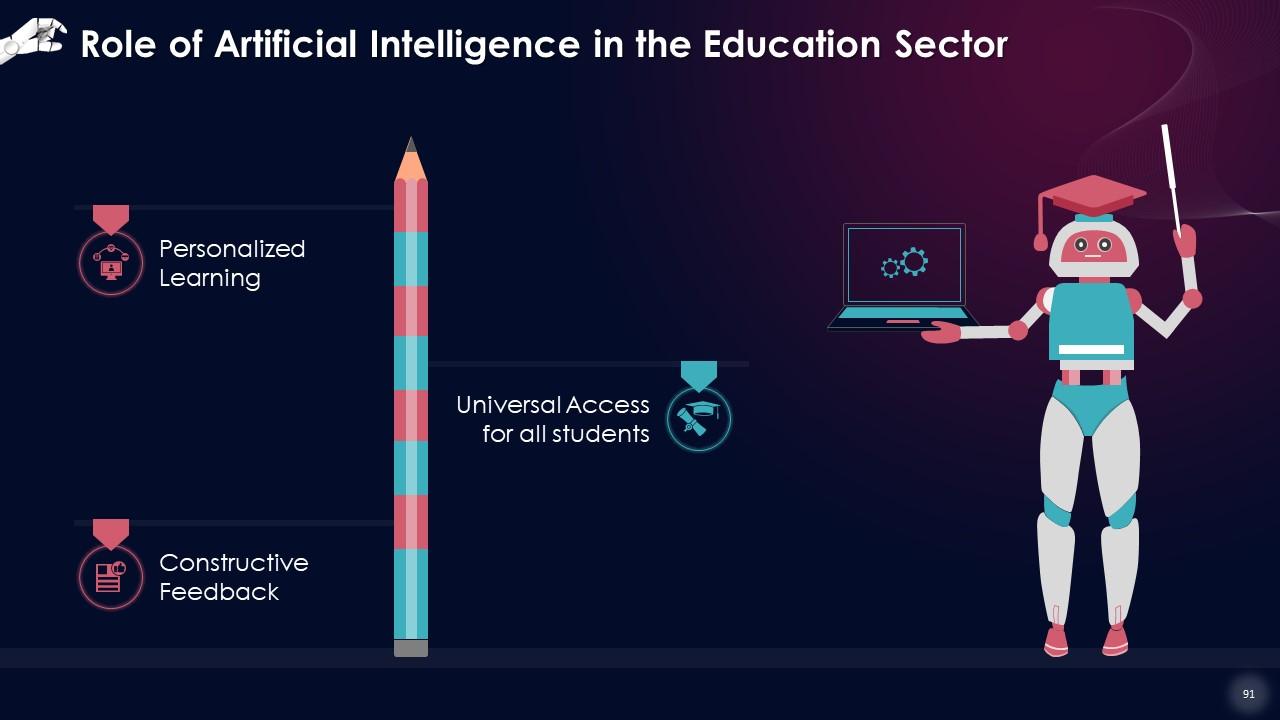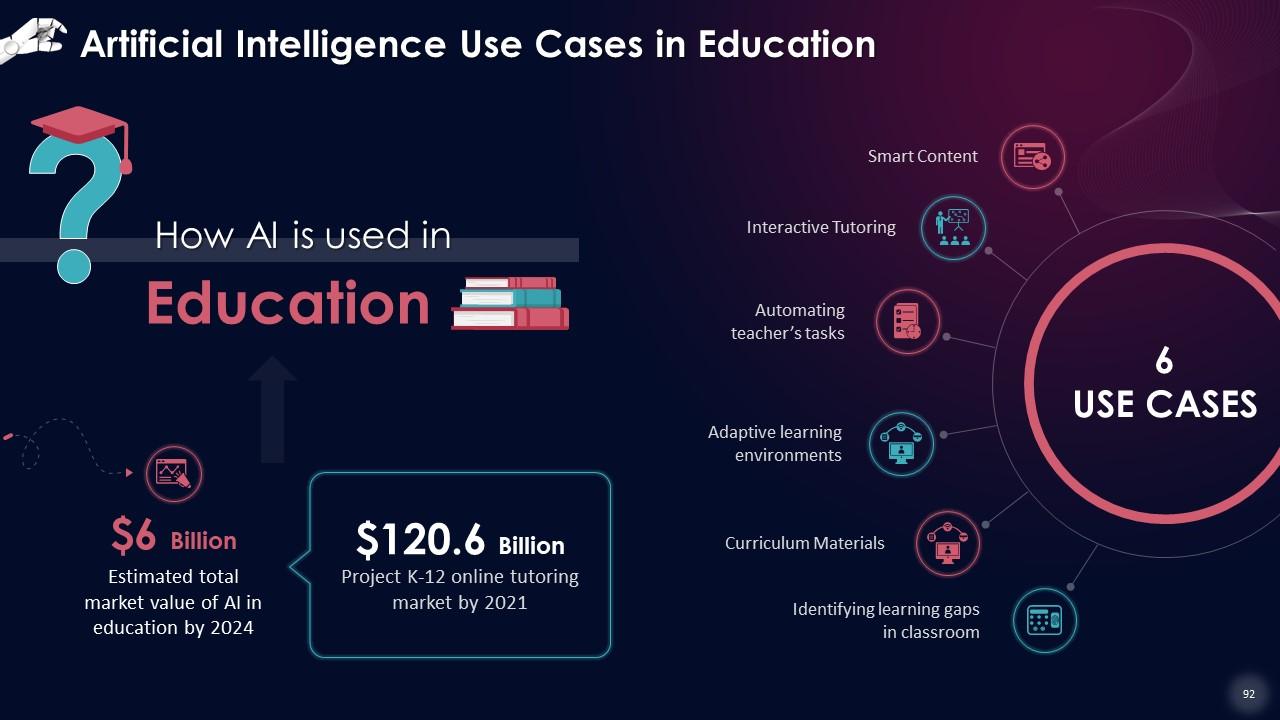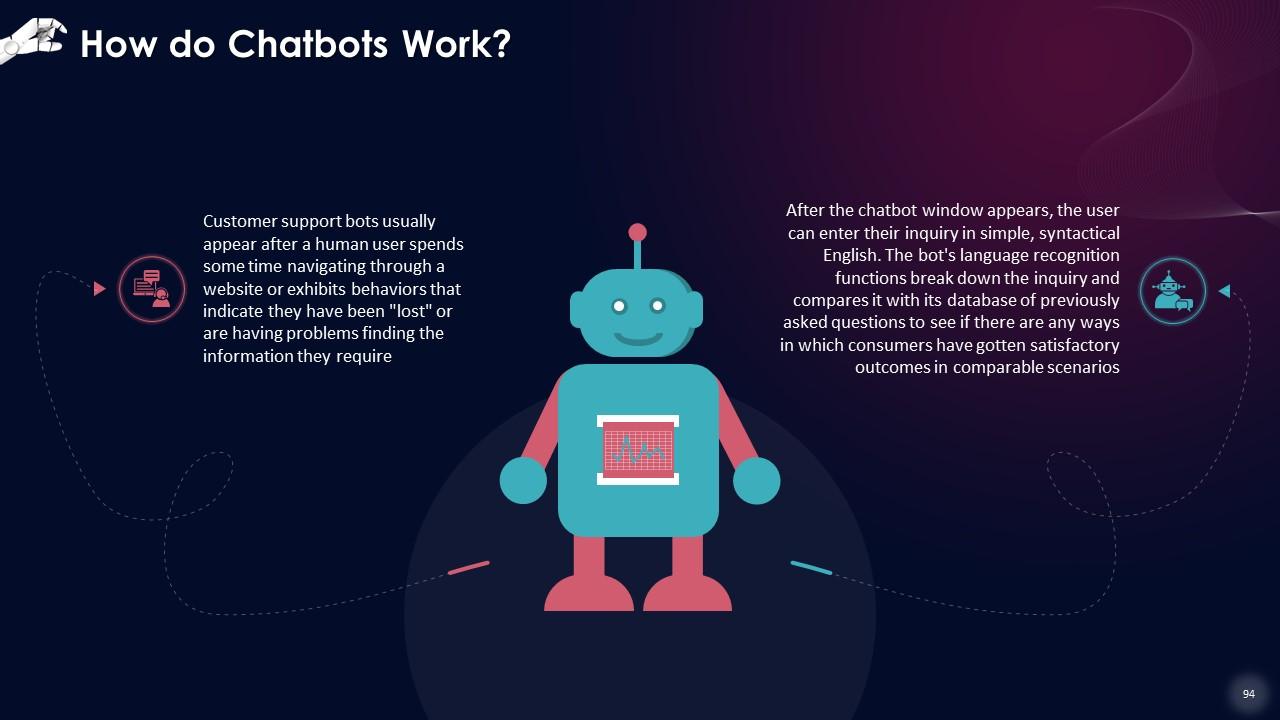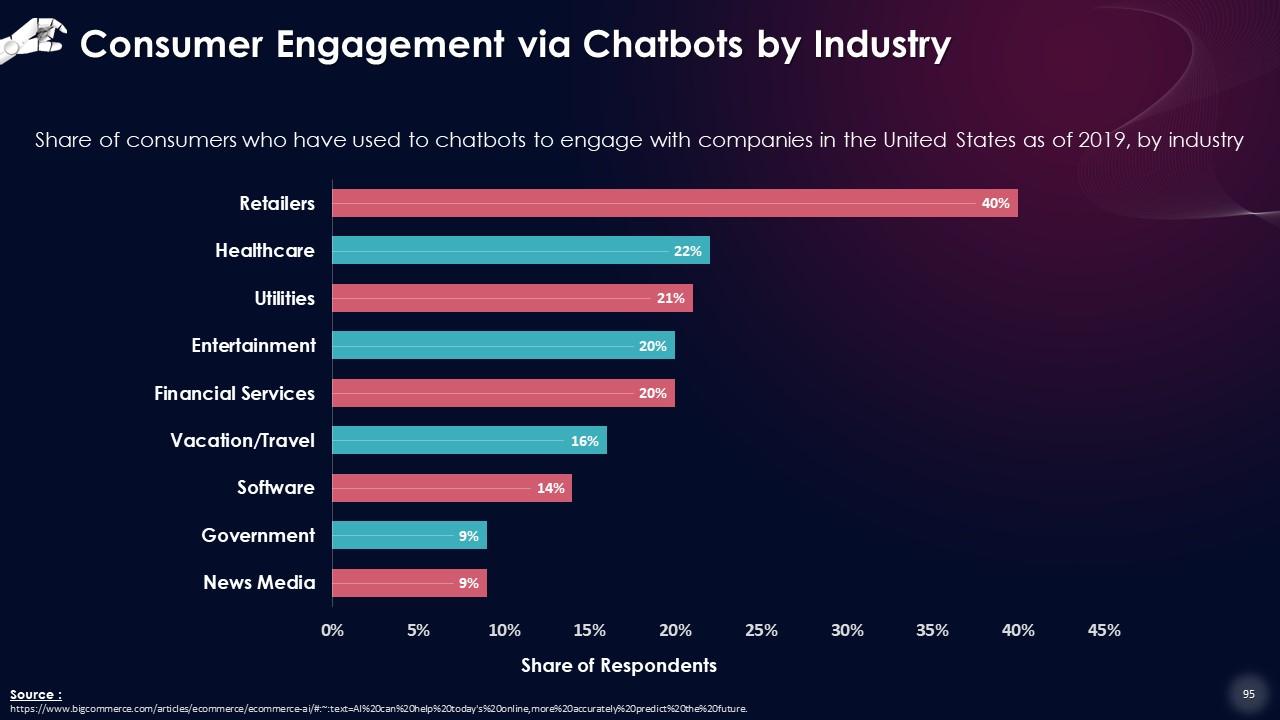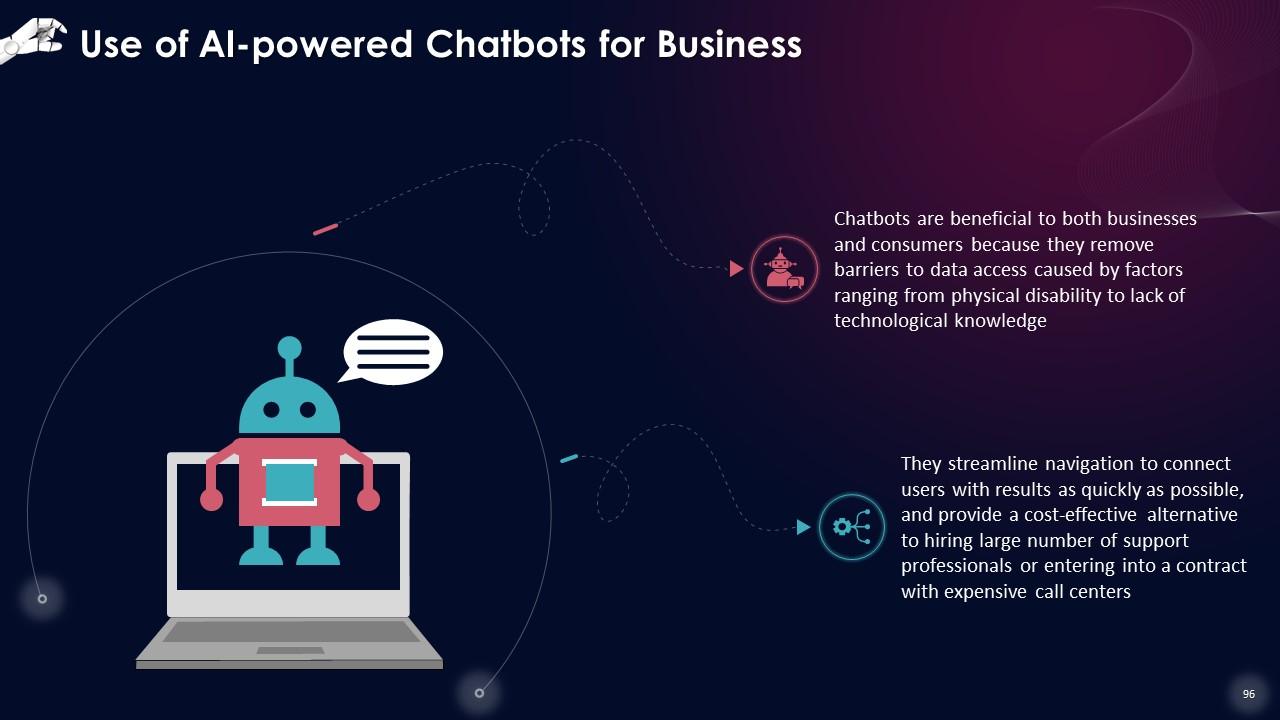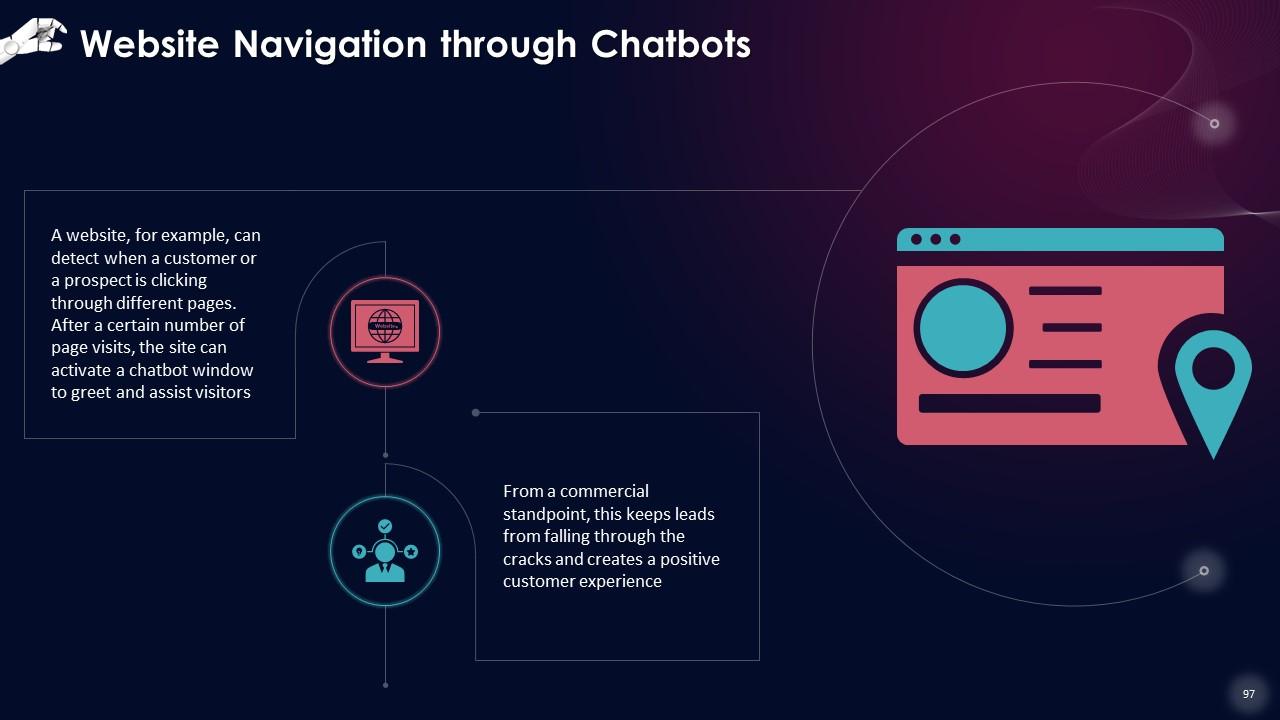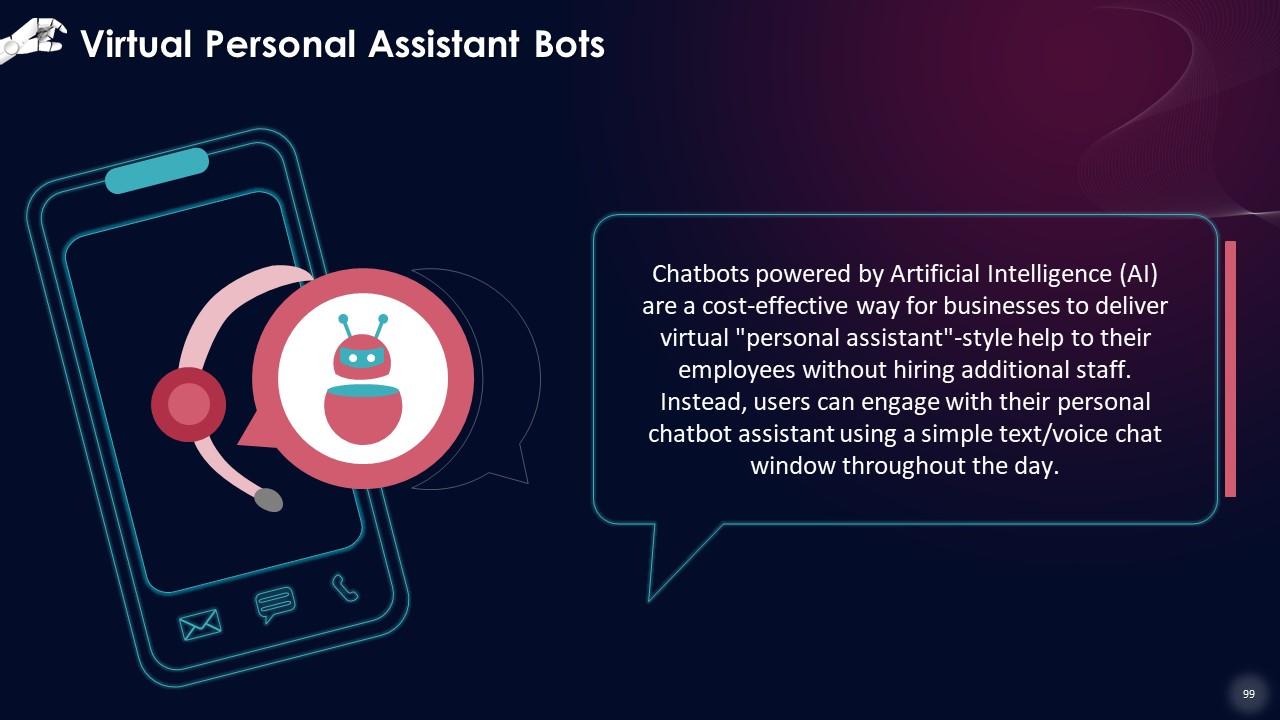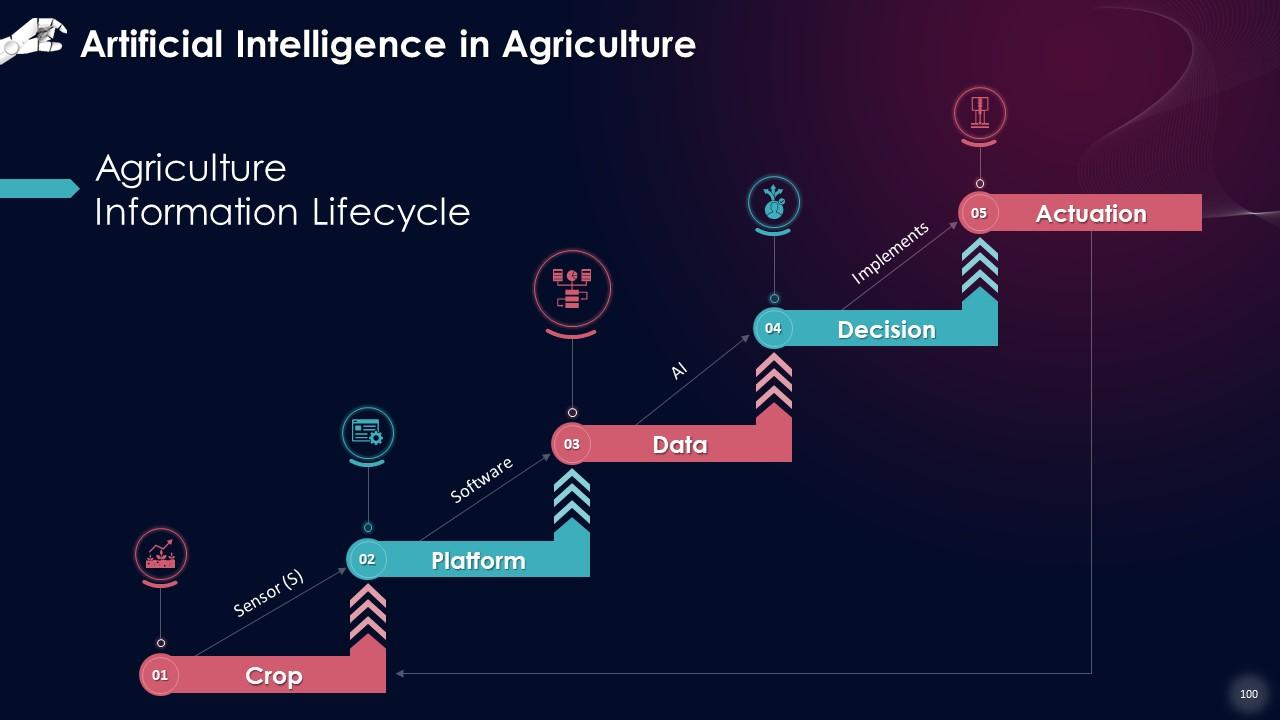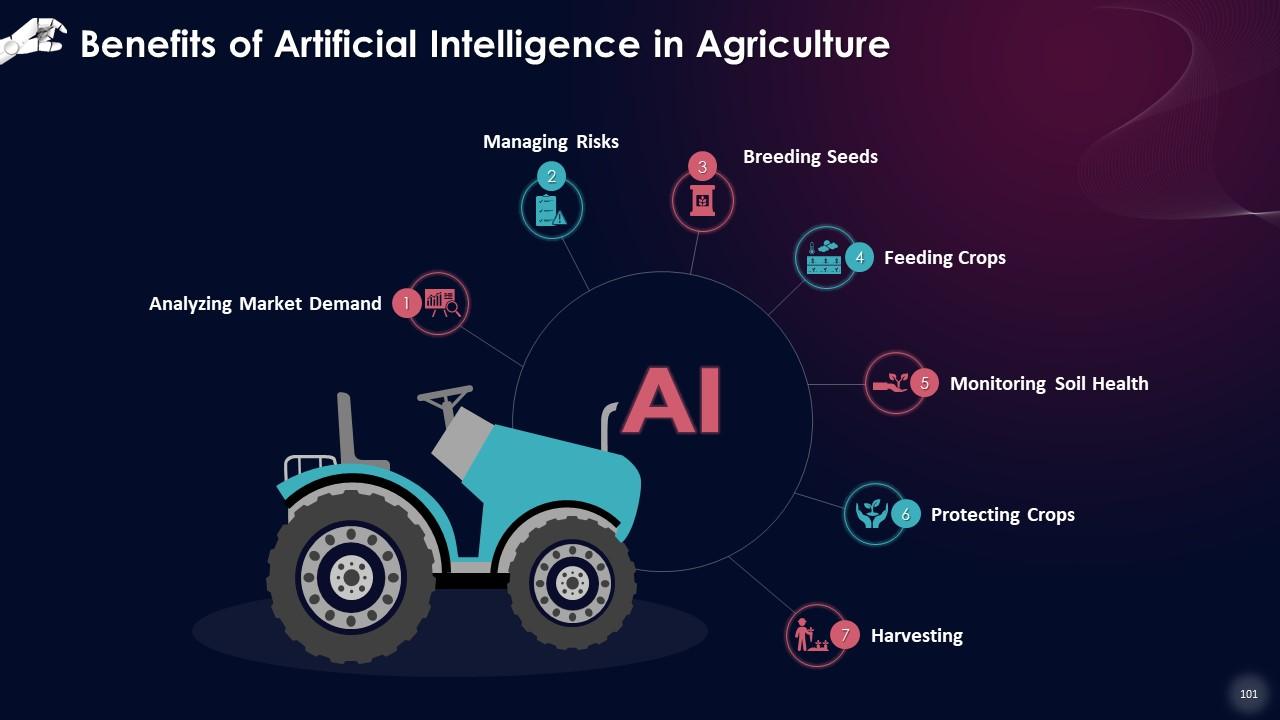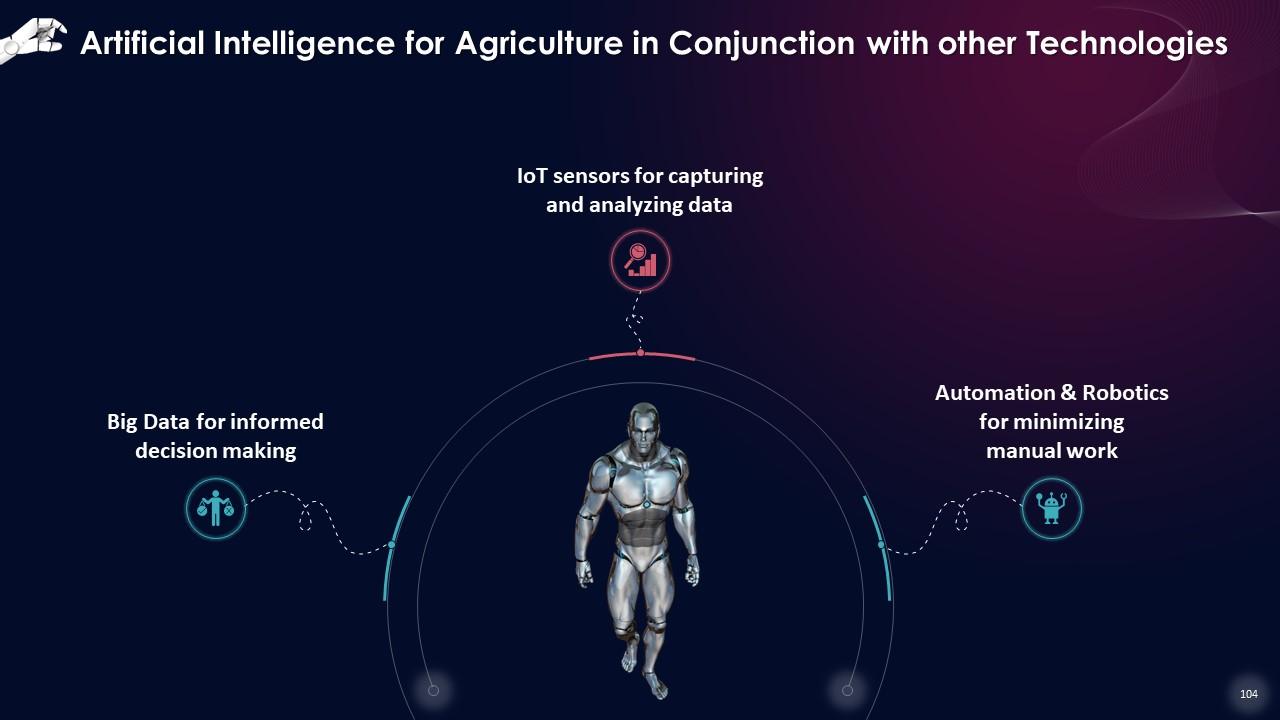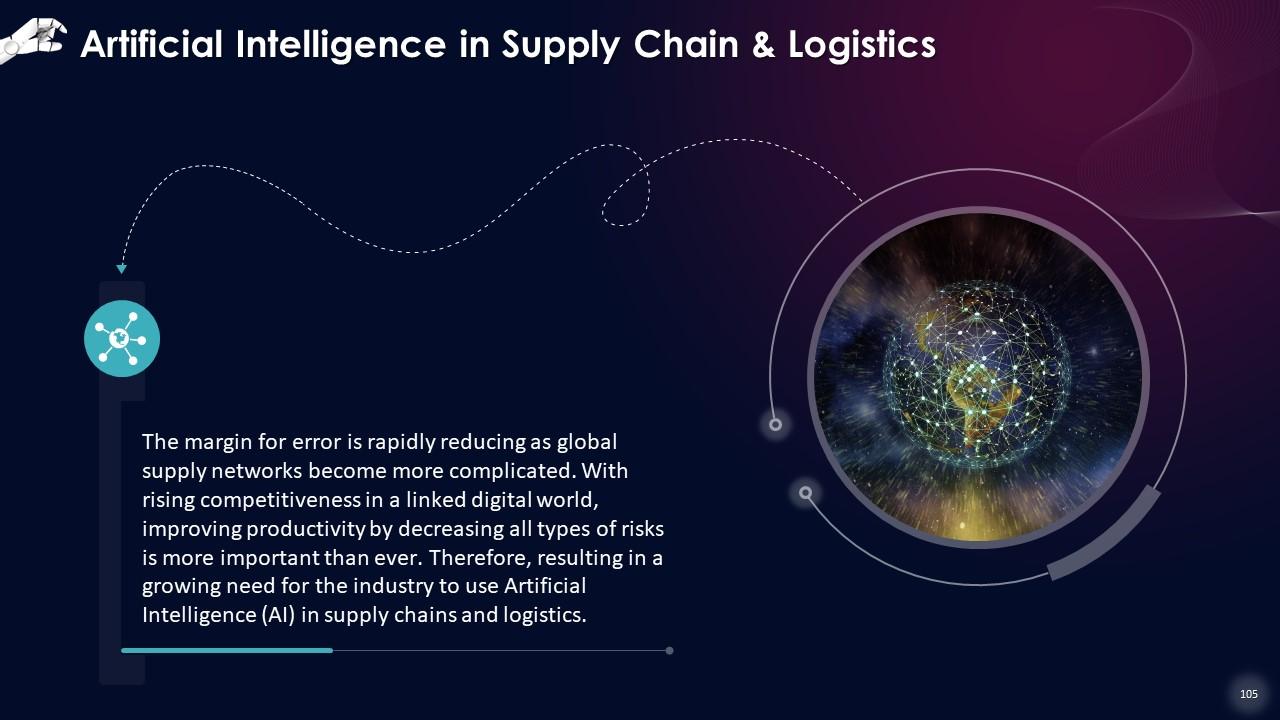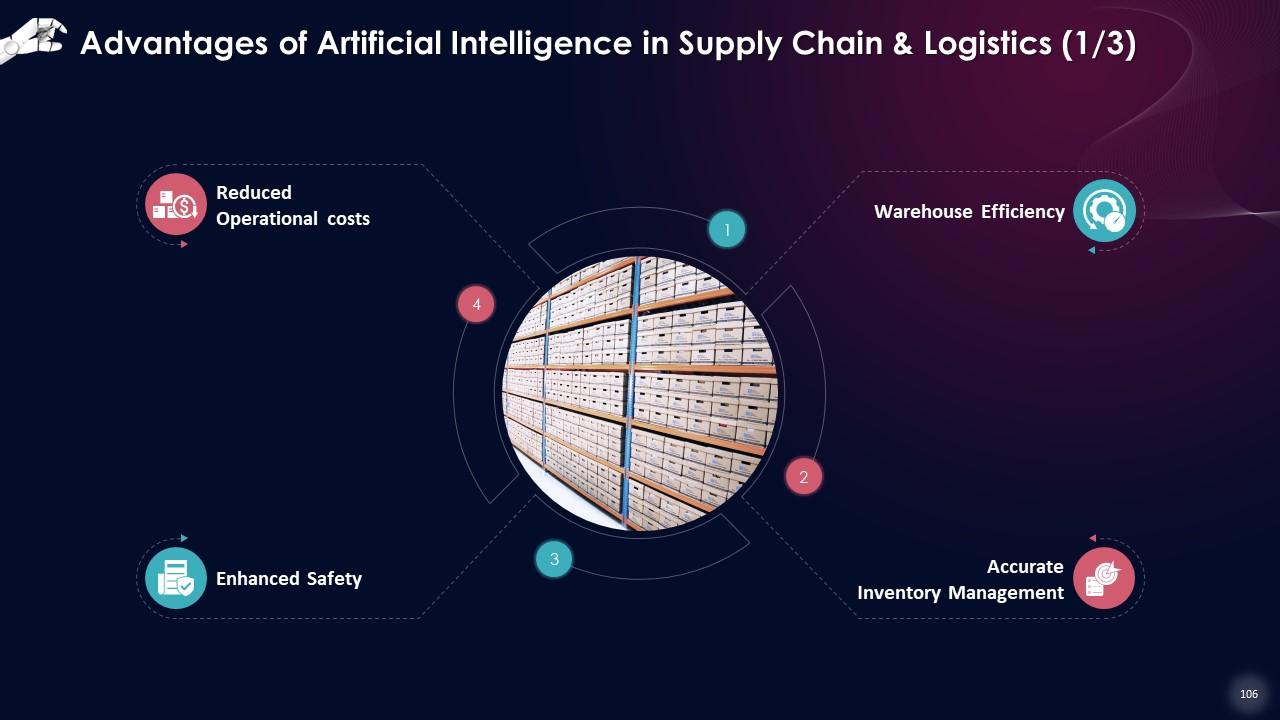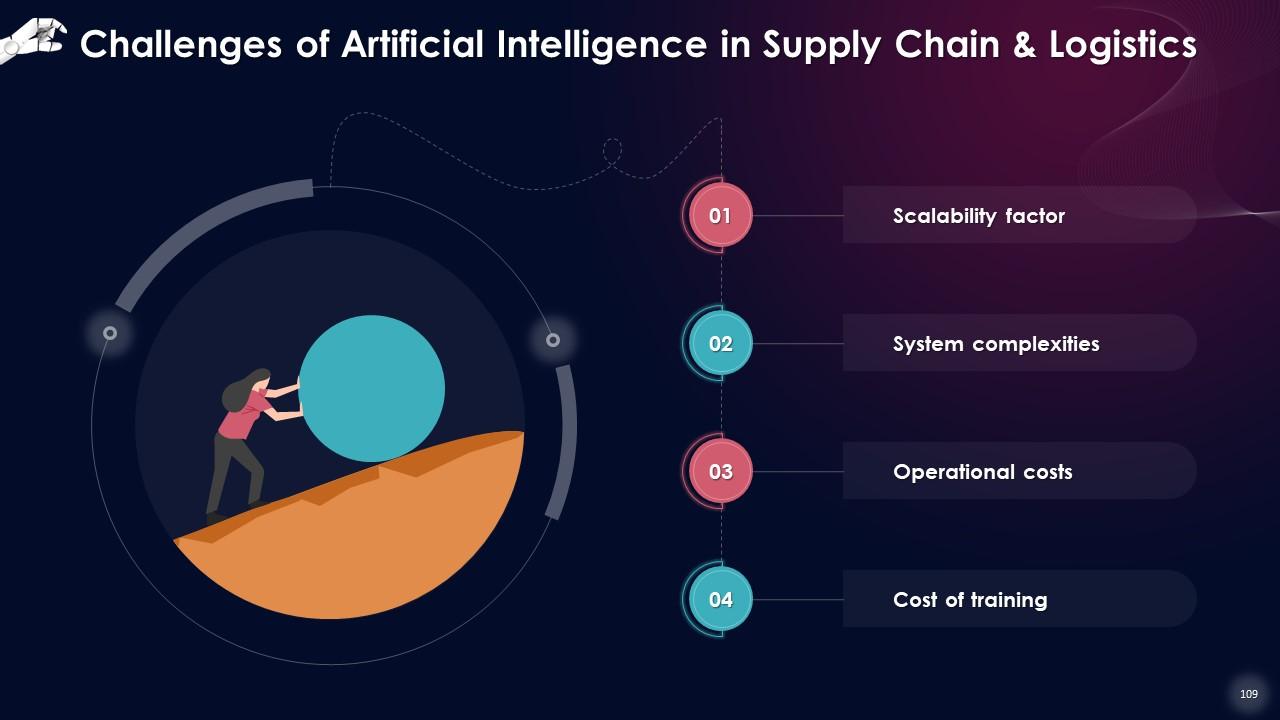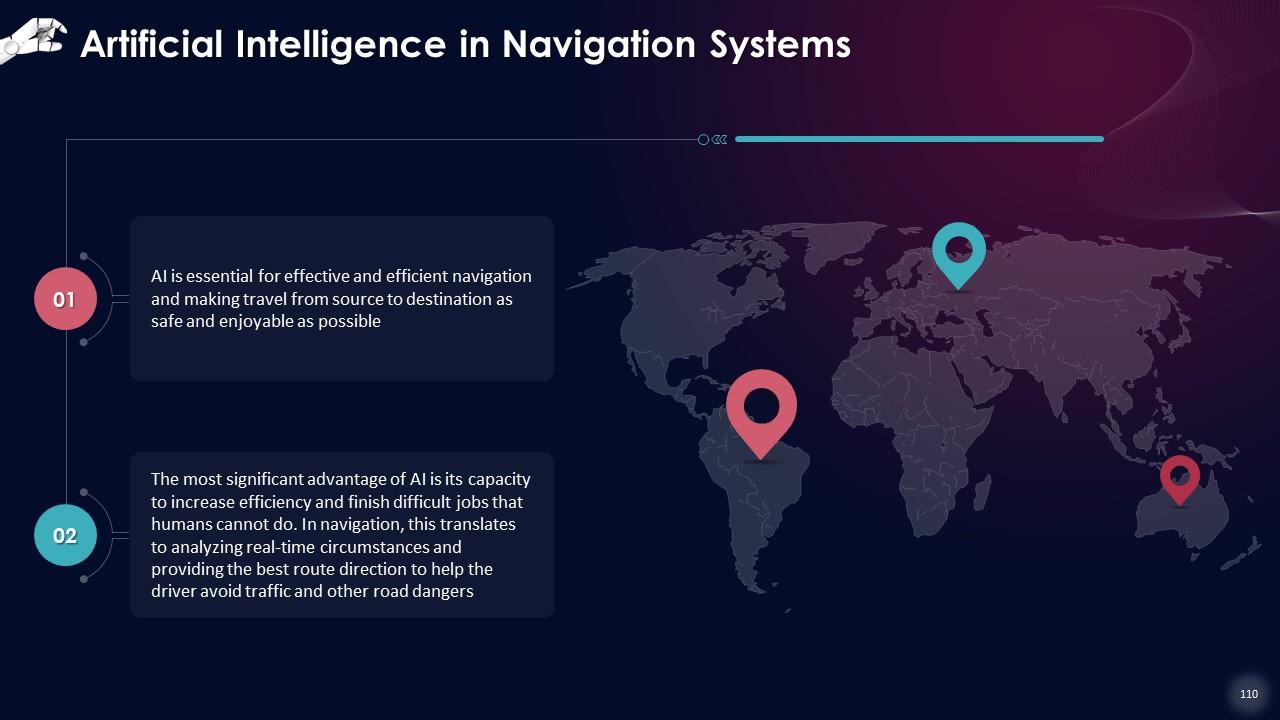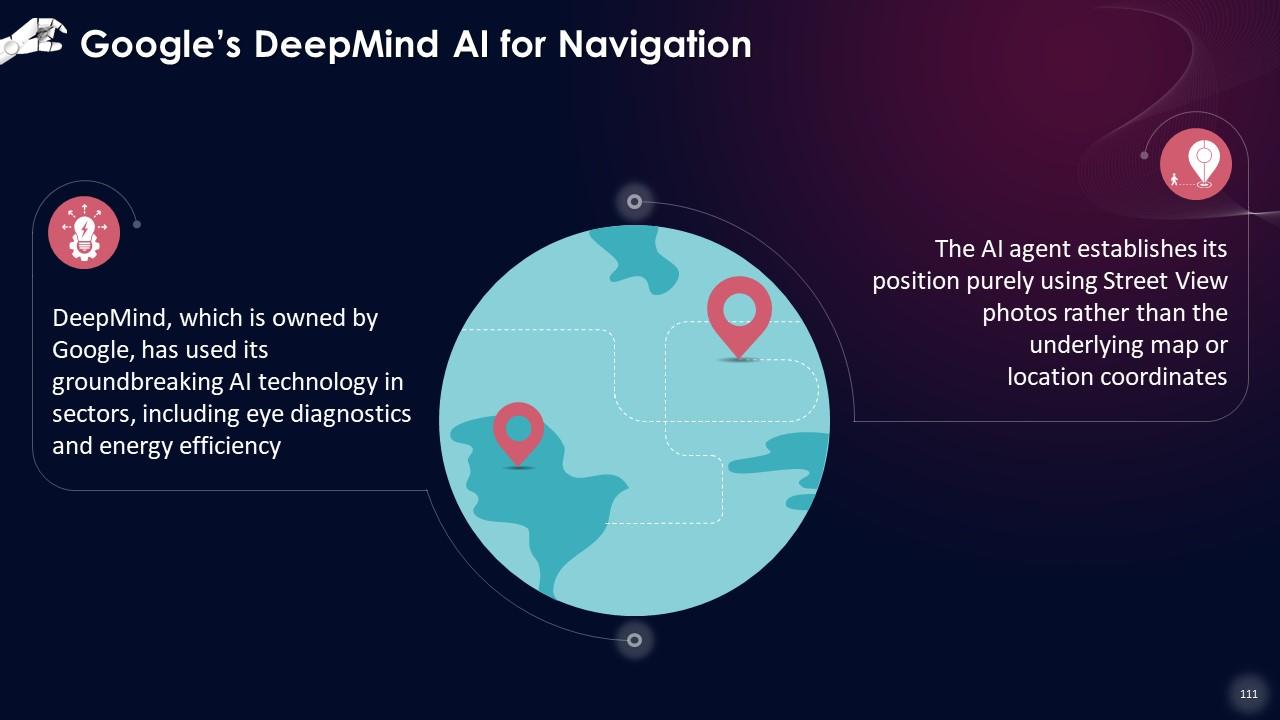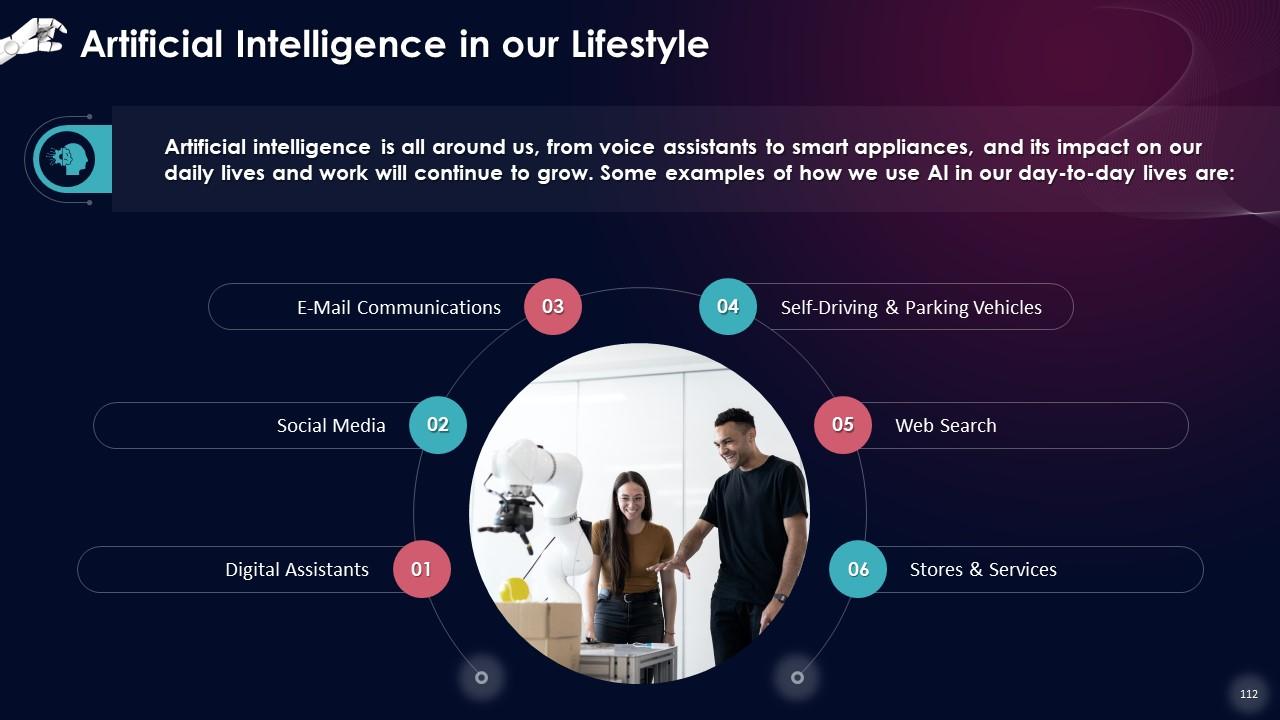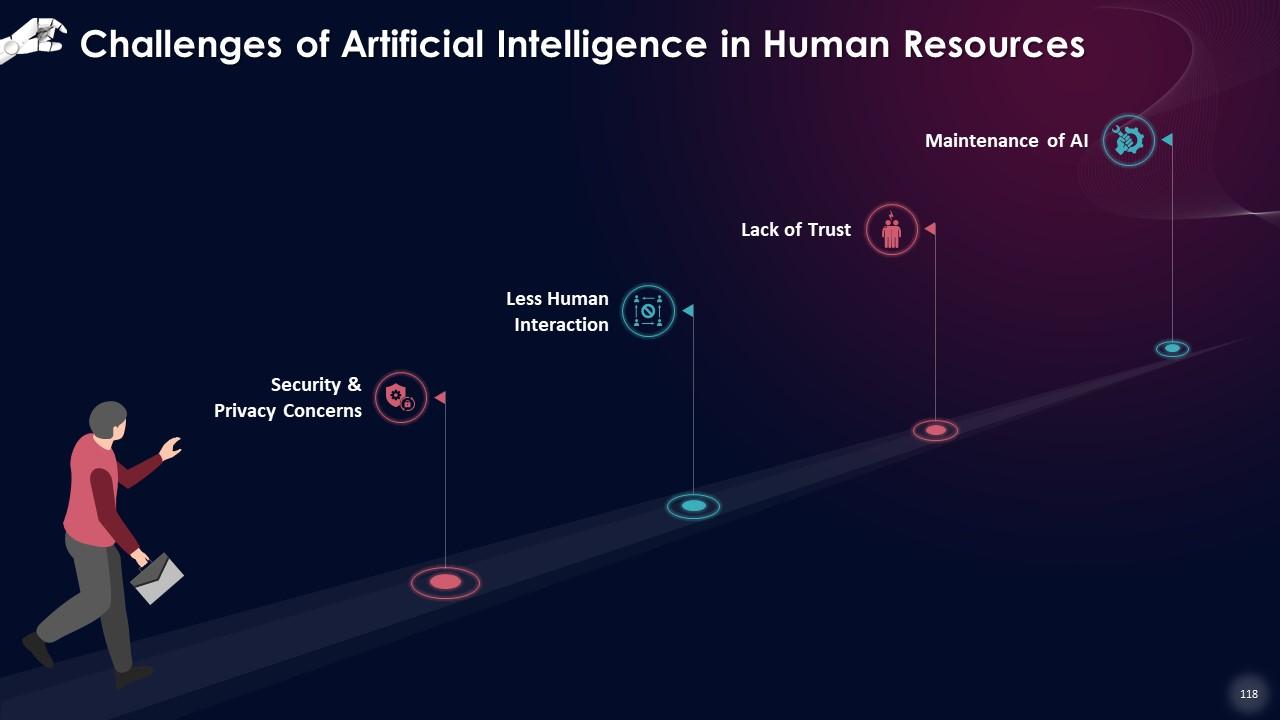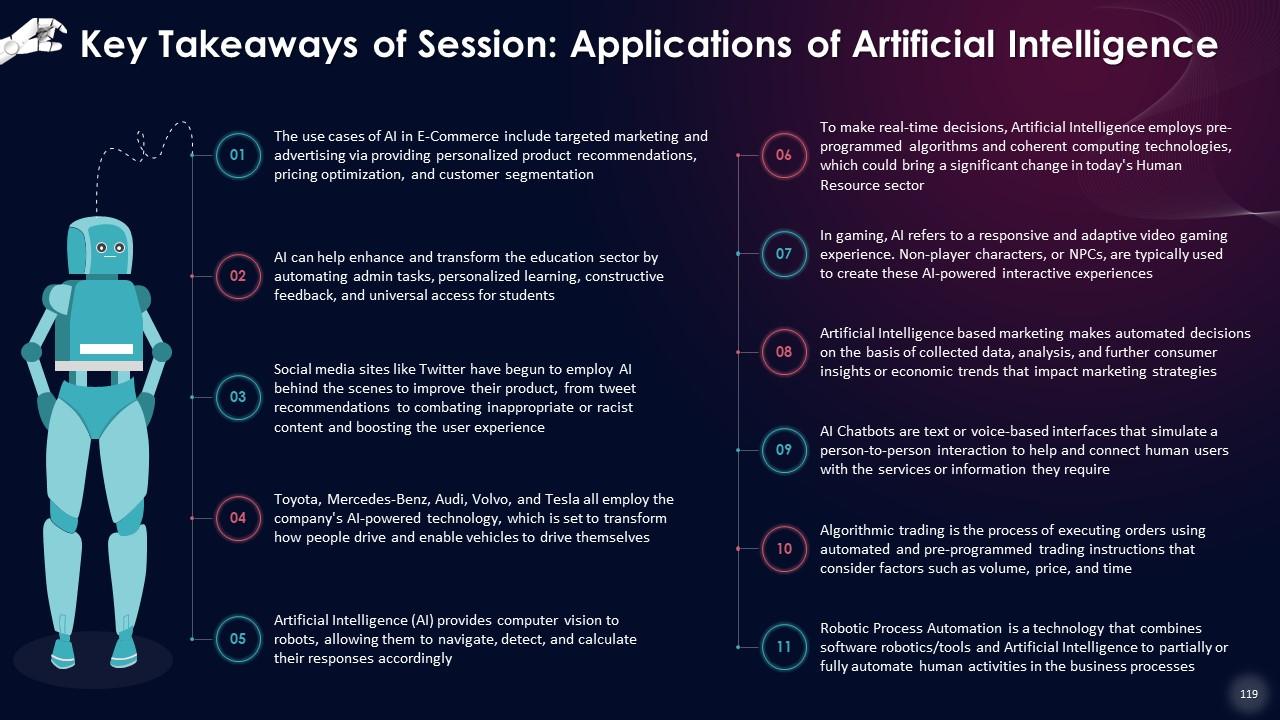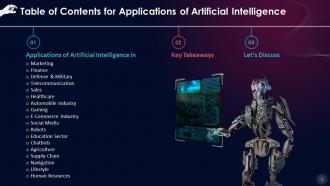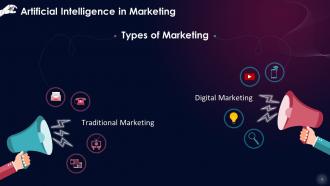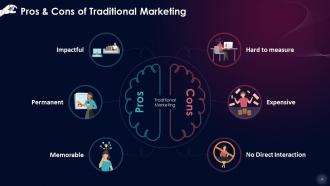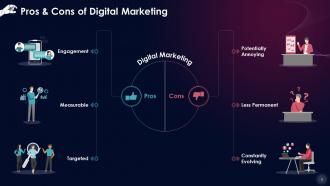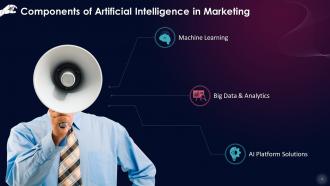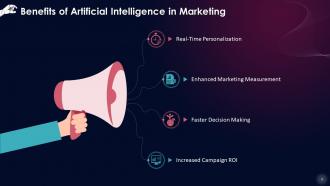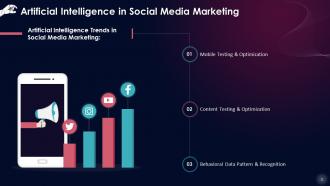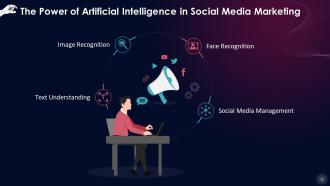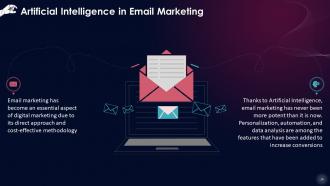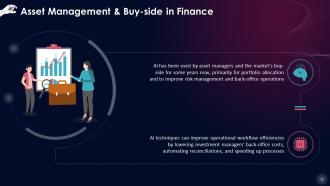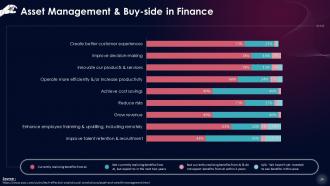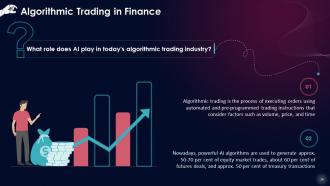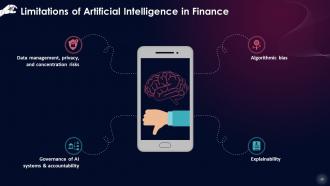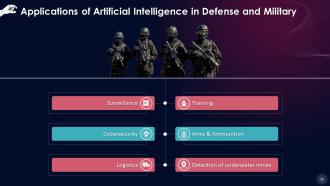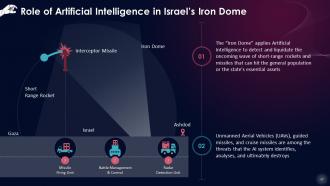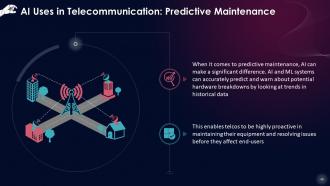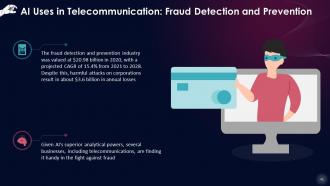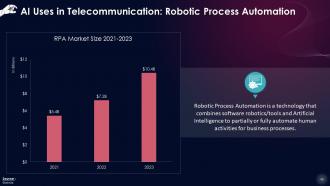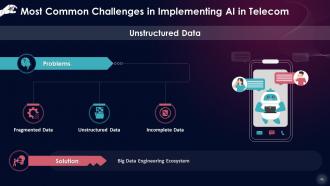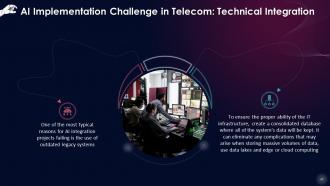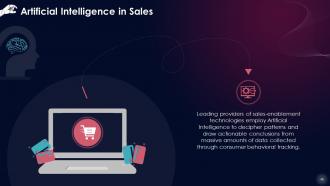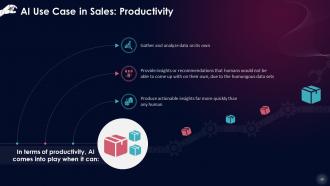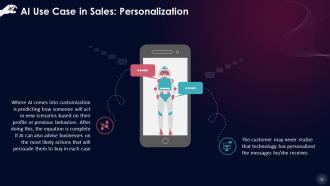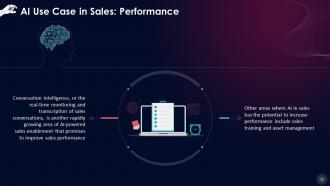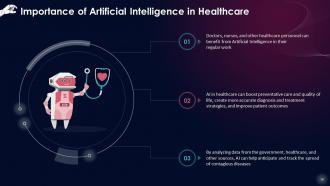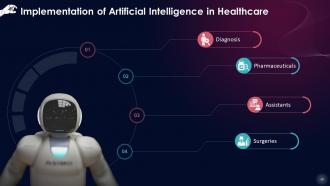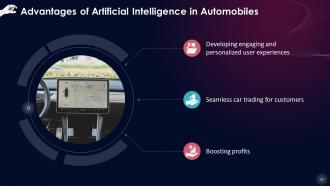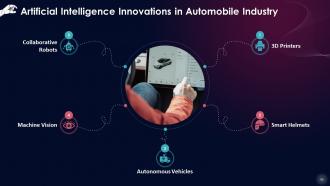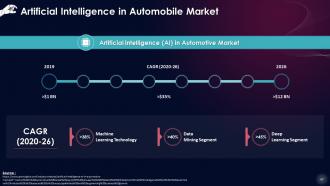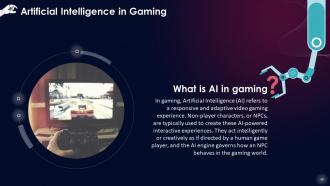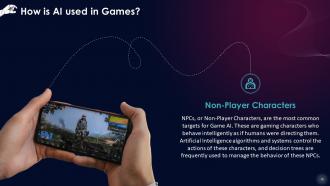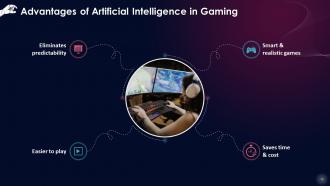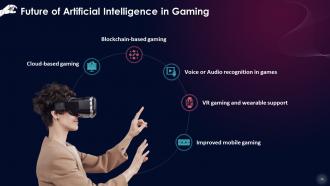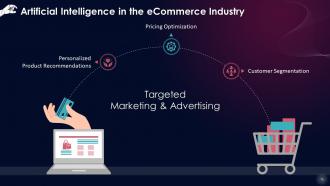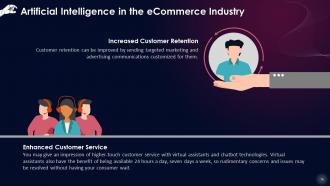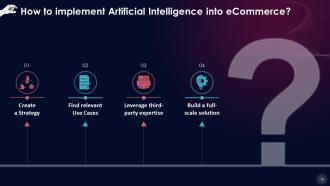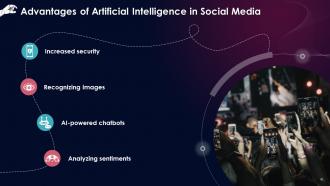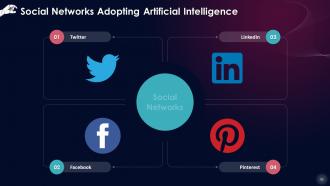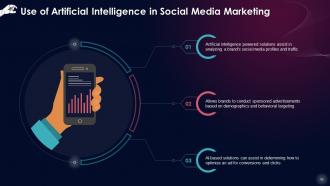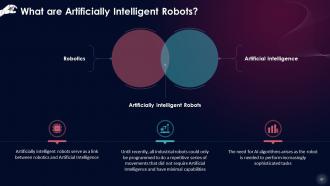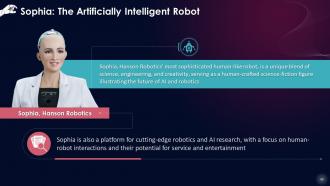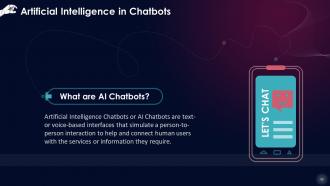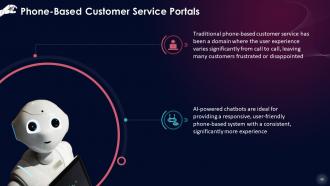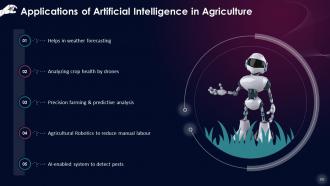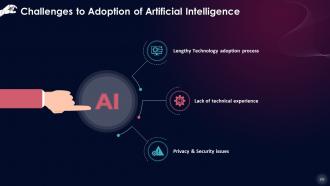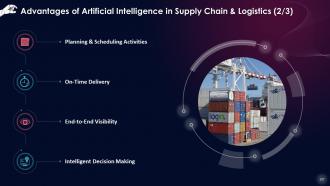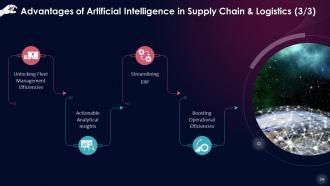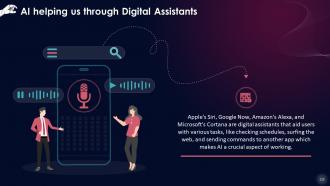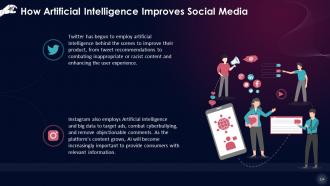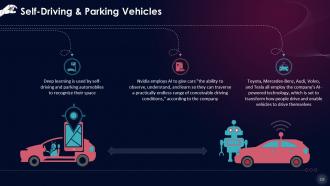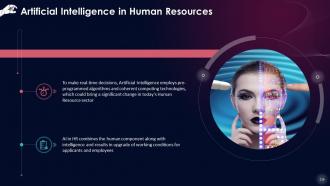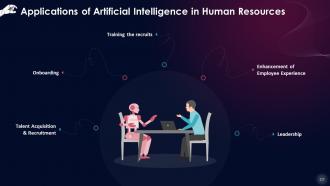Exploring Real World Applications Of Artificial Intelligence Training Ppt
This training module on Exploring Real-World Applications of Artificial Intelligence dives into the practical applications of AI across various industries and domains. Sectors covered are marketing, finance, defense and military, telecommunication, sales, healthcare, automobile industry, gaming, e-commerce, social media, robots, education, chatbots, agriculture, supply chain, navigation, lifestyle, and human resources. It also includes Key Takeaways and Discussion Questions related to the topic to make the training session more interactive.
This training module on Exploring Real-World Applications of Artificial Intelligence dives into the practical applications ..
- Google Slides is a new FREE Presentation software from Google.
- All our content is 100% compatible with Google Slides.
- Just download our designs, and upload them to Google Slides and they will work automatically.
- Amaze your audience with SlideTeam and Google Slides.
-
Want Changes to This PPT Slide? Check out our Presentation Design Services
- WideScreen Aspect ratio is becoming a very popular format. When you download this product, the downloaded ZIP will contain this product in both standard and widescreen format.
-

- Some older products that we have may only be in standard format, but they can easily be converted to widescreen.
- To do this, please open the SlideTeam product in Powerpoint, and go to
- Design ( On the top bar) -> Page Setup -> and select "On-screen Show (16:9)” in the drop down for "Slides Sized for".
- The slide or theme will change to widescreen, and all graphics will adjust automatically. You can similarly convert our content to any other desired screen aspect ratio.
Compatible With Google Slides

Get This In WideScreen
You must be logged in to download this presentation.
PowerPoint presentation slides
Presenting Training Deck on Exploring Real-World Applications of Artificial Intelligence. This deck comprises of 120 slides. Each slide is well crafted and designed by our PowerPoint experts. This PPT presentation is thoroughly researched by the experts, and every slide consists of appropriate content. All slides are customizable. You can add or delete the content as per your need. Not just this, you can also make the required changes in the charts and graphs. Download this professionally designed business presentation, add your content and present it with confidence.
People who downloaded this PowerPoint presentation also viewed the following :
Content of this Powerpoint Presentation
Slide 4
This slide demonstrates two categories of marketing namely traditional and digital. Traditional marketing encompasses a variety of advertising and marketing techniques whereas digital marketing is the advertisement or promotion of brands online via the Internet.
Instructor’s Notes:
- Traditional Marketing: Traditional marketing is a comprehensive term that encompasses a variety of advertising and marketing techniques. It's the most well-known type of marketing, covering commercials we see and hear daily. Print, broadcast, direct mail, and telephone are the four main types of traditional marketing tactics
- Digital Marketing: Digital marketing is the advertisement or promotion of brands online via the Internet and other kinds of digital communication to engage with potential customers. This comprises email, social media, web-based advertising, and text and multimedia messages etc as a marketing channel
Slide 5
This slide lists the advantages and disadvantages of traditional marketing. The pros include that it is impactful and easy to understand, permanent, and gets recall, whereas the cons are that it is hard to measure, expensive, and offers no direct interaction with the consumer.
Slide 6
This slide lists the advantages and disadvantages of digital marketing. The pros include that it has more options for engagement, makes it easier to manage campaigns, and has clear targeting; cons are that digital ads can potentially be annoying, are fleeting, and constantly evolving.
Slide 7
This slide gives an introduction to Artificial Intelligence in Marketing. AI in marketing makes automated decisions on the basis of data, analysis, and further consumer insights or economic trends that impact marketing strategies.
Instructor’s Notes:
Today, marketers are using many AI tools to supplement marketing teams or to execute more tactical activities that require little human touch.
Slide 8
This slide highlights components of Artificial Intelligence in Marketing such as Machine Learning, Big Data and Analytics, and AI Platform Solutions.
Instructor’s Notes:
- Machine Learning: Machine Learning drives Artificial Intelligence, which entails computer algorithms that can study data and improve automatically over time. Machine Learning devices assess new data in the context of relevant historical data, making decisions based on history
- Big Data & Analytics: With the rise of digital media, there is a glut of data. This allows marketers to evaluate their efforts better and correctly allocate value across channels. Many marketers struggle to establish which data sets are worth gathering, resulting in accumulation of way too much data
- AI Platform Solutions: Effective AI-powered solutions give marketers a single platform to manage the massive amounts of data collected. These platforms may provide marketers with actionable marketing knowledge about their target audience, allowing them to make data-driven decisions about how to communicate with their potential customers. Frameworks like Bayesian Learning and Forgetting, for example, can assist marketers in better determining how receptive a customer is to a particular marketing attempt
Slide 9
This slide lists challenges that mark adoption of Artificial Intelligence in Marketing. These include privacy issues, training time & data quality, deployment practices, changing marketing landscape, and getting buy-ins.
Instructor’s Notes:
- Privacy: Consumers and government regulators are monitoring how businesses use personal data. Marketing teams must guarantee that they handle customer data ethically and follow relevant regulations or face severe penalties and handle bad press. When it comes to AI, this is a challenge. Unless the tools are specifically developed to follow specific legal requirements, they may violate guidelines what is allowed on how to using consumer data
- Training time & Data Quality: Artificial Intelligence tools do not immediately understand which actions to take to achieve marketing objectives. They will need time and training to study business goals, customer preferences, historical patterns, understand the whole context, and establish competence. This is not only time-consuming, but it also necessitates data quality assurances. If AI technologies are not educated on high-quality data that is reliable, timely, and representative, the tool will make suboptimal decisions that do not reflect user preferences, lowering the instrument's value
- Deployment Practices: Because AI is a relatively new marketing tool, concrete best practices have yet to emerge to guide marketing teams through their initial deployment
- Changing Marketing Landscape: With the advent of AI, marketing activities will be disrupted daily, and marketers must evaluate which positions will be eliminated and which created. According to one study, marketing technology will eventually replace nearly six out of ten existing marketing specialist and analyst roles
- Getting Management Buy-In: It can be tricky for marketing teams to convince business stakeholders of the value of AI investments. While Key Performance Indicators (KPIs) like ROI and efficiency are straightforward to measure, demonstrating how AI has enhanced customer experience or brand reputation is more complicated. With this perspective, marketing teams must ensure that they have the tools necessary to credit these qualitative advantages to AI investments
Slide 10
This slide showcases the advantages of Artificial Intelligence in Marketing. These benefits include real-time personalization, enhanced marketing management, faster decision making, and increased campaign ROI.
Instructor’s Notes:
- Real-Time Personalization: AI can help you send customized communications to customers at the ‘right’ times in their lives. AI may also assist marketers in identifying clients who are now disenchanted with a company and providing them information that will help change their mind and give the business another chance
- Enhanced Marketing Measurement: A lot of businesses fail to keep up with the volume of data generated through digital efforts, making it difficult to attribute success to specific campaigns. AI-powered dashboards provide a more comprehensive perspective of what's working, reproducing it across channels and allocating resources in the correct manner
- Faster Decision Making: AI can perform tactical data analysis faster than humans and use Machine Learning to make quick decisions based on campaign and customer context. This allows team members more time to focus on strategic projects, which can be used to inform AI-powered marketing. Marketers can leverage real-time information to make smarter marketing decisions with AI
- Increased Campaign ROI: Marketers can use AI to alter their entire marketing campaign if they use it effectively, pulling the most useful insights from their databases and acting on these in real-time. AI tools can make quick decisions on how to spread expense across media channels or examine the most efficient ad placements to ensure that customers are consistently engaged, maximizing campaign value
Slide 11
This slide depicts the use of Artificial Intelligence in Digital Marketing. It can be used in email marketing, SEO & content marketing, voice & text-based marketing, and social media marketing.
Slide 12
This slide lists top Artificial Intelligence trends in Social Media Marketing. These are mobile testing and optimization, content testing and optimization, and behavioral data pattern and recognition.
Instructor’s Notes:
- Mobile Testing & Optimization: You may design individual ads targeted at users based on the type of device they use via Artificial Intelligence. For example, someone browsing for products and services on a mobile device will have less screen space but may be more tempted to buy. When your AI tool identifies that this prospect is on a mobile device, it will present them with a mobile-friendly ad that will entice them to take the next step
- Content Testing & Optimization: By targeting audiences with specific, relevant digital text and compelling imagery, AI-powered technologies have helped organizations increase conversion significantly. This means that marketers can now personalize social media marketing messages depending on a user's previous patterns of preferences and habits
- Behavioral Data Pattern & Recognition: AI in social media aims to improve customization and targeting by using data from previous customer journeys to estimate outcomes and build automated marketing content/workflows
Slide 13
This slide discusses the impact of Artificial Intelligence on Social Media Marketing. Some of the ways AI can accelerate marketing are image recognition, face recognition, text understanding, and social media management.
Instructor’s Notes:
- Image Recognition: Images are abundant on social media platforms. For larger firms, manually screening hundreds of images of each individual would be too taxing. Advanced AI technology can immediately scan a large number of photographs, evaluate and sort these as needed. Facebook uses Machine Learning to extract specific information from photographs, such as the appearance of objects, company logos, etc
- Face Recognition: In 2010, Facebook became the first social media platform to use face recognition to identify people in photographs. Since then, face recognition has gotten significantly more widespread and accurate. According to a 2019 report, the facial recognition business would produce $7 billion in sales by 2024. What's more impressive is that modern facial recognition software has progressed to the point where it can recognize emotions on a human face. The ability to identify customers' moods results in more targeted, relevant advertisements adapted to each customer's emotional state
- Text Understanding: Machine Learning algorithms use Natural Language Processing (NLP) to assess how you converse, engage with diverse information, and react to issues. Most social media networks make use of text-deciphering algorithms. Facebook has effectively filtered massive text-based data present on its platform and Instagram using a deep learning engine called DeepText
- Social Media Management: Artificial Intelligence has the most direct and imminent impact on social media management. The majority of companies now have a presence on social media platforms. This accomplishes two goals: It broadens the company's reach to its target market, and it complicates the social media management process. When it comes to scheduling and distributing social media material, AI has proven to be valuable. Sophisticated technologies evaluate post engagement, gather useful data from user comments, and provide strategic post recommendations.
Slide 14
This slide discusses the impact of AI on Social Media Marketing. Some of the ways AI can accelerate marketing are content creation & optimization, tracking online behavior, targeted advertising, and automated customer service.
Instructor’s Notes:
- Content Creation & Optimization: Creativity and good research capabilities are required for content development. While AI may lack the former, it more than makes up for it with the latter. AI can generate good content because of its capability to conduct exhaustive research in a short amount of time. AI-based techniques have also proved to be beneficial in terms of content optimization. AI can provide ideas on optimizing your content for search engines after analyzing top search results on a specific topic
- Tracking Online Behavior: AI's superpower is its ability to recognize and track trends. It may gather and give you vital information such as user browsing behaviors, average time on site, bounce rates, clicks, and views, among other things. Once you have all the numbers, it will be much easier to figure out why visitors leave, which aspects of your website or social media account are working, and which need to be improved
- Targeted Advertising: Advertising is one of the most prevalent applications of AI. You can adapt your marketing efforts and deliver them to the right audience by gaining access to the metadata containing relevant information about your clients' demographics and preferences. Artificial Intelligence and deep learning tools can aid in the monitoring of ad campaign performance and keeping up with particular market trends. AI also makes competitor research and analysis immensely easier and more effective
- Automated Customer Service: Many firms find it challenging to respond to every consumer query immediately. By automating customer service, clients can receive faster responses, and firms will win their customers' trust
Slide 15
This slide showcases how the use of AI is enhancing Email Marketing. Email Marketing is an essential aspect of Digital Marketing and AI has made it more potent with features such as personalization, automation, and data analysis.
Instructor’s Notes:
AI is critical in improving your email marketing methods to offer your email plan that gives better outcomes.
Slide 16
This slide depicts the positive effects of the usage of Artificial Intelligence in Email Marketing. There has been a perceptible improvement in revenue, click-through rates, open rates, and deliverability upon integrating AI with email components. AI can make sense of data better and faster than humans, making it a near-certainty that the industry will use it in the coming years.
Slide 17
This slide highlights industries on Email Marketing Open Rates. These industries include non-profit organizations, agriculture, forestry, government, healthcare, education, real estate, construction, advertising, logistics, engineering, and architecture.
Slide 18
This slide talks about the use of Artificial Intelligence to assist in Search Engine Optimization of a web page or website to gain better ranks and more traffic. AI can help with SERP analysis, content creation, optimization advice, etc.
Slide 19
This slide lists issues in SEO that AI can help with. These include automated keyword research, automatic content creation, increased traffic & site growth, automation of SEO workflows, voice search content discovery.
Instructor’s Notes:
With the emergence of AI, digital marketers can now work with greater accuracy, speed, and precision while enhancing SEO accuracy. Marketers will be able to satisfy their clients' goals while also improving productivity by using AI-assisted content generation and optimization to swiftly get to the point of action.
Slide 20
This slide talks about the application of Artificial Intelligence and analytics based on voice content from phones and broadcasts in detecting financial crimes, better customer risk management, and reduces the cost of doing a business.
Instructor’s Notes:
The overall cost of financial crime compliance, which includes unfavorable media screening, is expected to reach $180.9 billion by 2020.
Slide 22
This slide introduces Artificial Intelligence in the Finance Sector. Artificial Intelligence (AI) systems and approaches have seen significant growth and usage in financial sector, owing to the volume of available data and the increasing affordability of computing resources
Slide 23
This slide discusses the importance of the application of AI in Finance. The use of AI techniques in finance can result in cost savings through lowering friction costs and increasing efficiency, which leads to increased profitability. Automation and technology-enabled cost reduction, in particular, provides for capacity reallocation, spending effectiveness, and more transparent decision-making.
Instructor’s Notes:
AI applications for financial services can improve the quality of services and products offered to financial customers, increase product customization and personalization, and diversify the product offering. AI processes can extract insights from data to form investment plans and improve financial inclusion by allowing the creditworthiness of clients with short credit histories to be assessed.
Slide 24
This slide showcases financial activities in which AI can be applied. AI and big data can influence business models in the financial sector. It also influences activities such as asset management and investment, trading, lending, etc.
Instructor’s Notes:
AML/CFT: Anti-Money Laundering/ Combating of Financing of Terrorism (Refer to the middle office category)
Slide 25
This slide depicts the usage of Artificial Intelligence in Hedge Funds which include idea generation, portfolio construction, risk management, and trade execution. It also shows the percentage of decision-making that relies on Artificial Intelligence.
Slide 26
This slide illustrates the use of AI in Asset Management within the finance sector. Asset managers and the market's
buy-side have used AI for some years, primarily for portfolio allocation and to improve risk management and back-office operations.
Instructor’s Notes:
AI techniques can improve operational workflow efficiencies by lowering investment managers' back-office costs, automating reconciliations, and speeding up processes. It results in lowering direct and indirect transaction costs and improving performance by reducing irrelevant features and information in decision-making.
Slide 27
This slide showcases the impact of Artificial Intelligence on Asset Management & Buy-side and how it enhances investor experience. The benefits of AI include better customer experience, improved decision-making, better products & services, efficiency, increased productivity, cost savings, reduced risks, growth in revenue, enhanced employee training & upskilling, and improved talent retention & recruitment.
Slide 28
This slide depicts asset management firms’ top priorities for meeting AI challenges such as lack of AI knowledge amongst employees, lack of trust in AI systems, its return on investment, etc.
Slide 29
This slide lists how to accelerate the benefits of Artificial Intelligence in Finance. The guidelines are to select an AI system that manages its data, start small & safe, gradually scale up, build capabilities, and be vigilant about its biases.
Instructor’s Notes:
- Select AI that manages its own data: AI is powered by the latest, comprehensive, standardized, validated, and easily accessible data. With capabilities to ingest, reconcile, validate, and standardize data from many sources in real-time, proper AI solutions will help construct their own foundation
- Start small & scale: Many AI solutions might start with small steps and quick returns. Governance, security, compliance, and ethics are incorporated into the best solutions. You can see immediate wins while strictly controlling your risks using the correct AI technology
- Get set to scale: Choose solutions that may begin in one area, but once demonstrated, can be applied across varied situations. Spending time and resources to develop a solution is frequently only the first step; scaling it can dramatically boost your return on investment. Many AI solutions will overlap and improve one another if they are correctly built
- Build out capabilities: Some AI installations may be plug-and-play at first, but your personnel will need to be upskilled as your solutions improve. You'll also need to create a culture and structure that can take advantage of more automation and move rapidly on data-driven insights in real-time
- Watch the bias: AI that takes decisions that are habitually unfair to specific groups of people, and this can impact a company's brand reputation, recruitment, and investment decisions, among other things. Make sure to think about ideas that can help AI algorithms eliminate prejudices
Slide 30
This slide showcases the role of Artificial Intelligence in algorithmic trading. Nowadays, powerful AI algorithms are used to generate approx. 50-70 per cent of equity market trades, about 60 per cent of futures deals, and approx. 50 per cent of treasury transactions.
Slide 31
This slide highlights the global algorithmic trading market from 2021 to 2025. From 2021 to 2025, the algorithmic trading market is predicted to increase by $3.79 billion, with a CAGR of almost 6 per cent.
Slide 32
This slide lists advantages of Artificial Intelligence in algorithmic trading. These include identifying and creating trading strategies, making decisions based on AI-driven model predictions, executing transactions without human intervention, managing liquidity, improving risk management, and organizing order flows and streamlining execution.
Instructor’s Notes:
The application of AI techniques such as evolutionary computation, deep learning, and probabilistic logic to identify trading strategies and their automated implementation without human intervention has the most disruptive potential in trading. AI-powered algorithms add a layer of development and complexity, maturing into fully automated, computer-programmed algorithms that learn from the data input used and rely little on human interaction.
Slide 33
This slide talks about the impact of Artificial Intelligence on credit intermediation. Through automation and associated efficiencies, advanced AI-based analytics models can boost the speed and minimize the cost of underwriting. This is revolutionizing creditworthiness of prospective buyers.
Instructor’s Notes:
The creditworthiness of clients with insufficient credit history or not enough collateral can be assessed using credit scoring models driven by big data and AI. This is accomplished by combining traditional credit data with big data that isn't intuitively related to creditworthiness.
Slide 34
This slide lists challenges or risks in the deployment of Artificial Intelligence in Finance. These include data management, privacy, & concentration risks, algorithmic bias, governance of AI systems, and explainability.
Instructor’s Notes:
- Data Management, privacy, and concentration risks: Although data is the foundation of any AI application, improper use of data in AI-powered applications or insufficient data is a significant source of risk to businesses that use AI. The reliability of the data used, obstacles relating to data privacy and confidentiality; fairness considerations; and potential concentration and significant competition issues are all examples of such risk
- Algorithmic bias: The decisions taken by AI can have a substantial impact on financial institutions’ clients. A single loan application that is denied can drastically alter a person's life. As a result, additional caution is advised to eliminate any sources of bias in the data
- Governance of AI systems and accountability: Solid governance and accountability systems are critical, mainly as AI models are increasingly used in high-value decision-making applications (e.g., credit allocation). Organizations and individuals responsible for designing, implementing, and operating AI systems should be held accountable for their proper operation
- Explainability: Explainability, or the difficulty of dissecting an ML model's output into the underlying reasons of its choice, is the most urgent obstacle in AI-based financial models. In addition to the complexity of AI-based models, market players may want to hide the mechanics of their AI models to preserve their intellectual property, obscuring the methodologies even more. The difficulty is amplified by most end-user consumers' lack of technical literacy and a mismatch between the complexity of AI models and the demands of human-scale reasoning
Slide 36
This slide showcases the importance of Artificial Intelligence in Defense and Military. Artificial Intelligence advancements will open up new possibilities in defense technologies. The capability of fighting a war can be improved by utilizing Artificial Intelligence in military operations and improving the performance of military forces.
Slide 37
This slide highlights that many countries across the world are using Artificial Intelligence to enhance their defense and military operations. Technologies such as Deep Learning machines, which require Big Data and artificial neural networks, are being used.
Instructor’s Notes:
Many countries across the world are using AI to improve the effectiveness of their defense forces in the following ways:
- With the extensive use of AI gadgets every operator in the defense network can be brought together to carry out and complete operations or assignments
- Unmanned and manned systems can be brought together for human and machine combat scenarios
Slide 38
This slide lists the advantages of Artificial Intelligence in defense and military operations. These benefits include better decision making, detection of mines underwater, deployment of military robots, better targeting, and unmanned vehicles & use of drones.
Instructor’s Notes:
- Better decision making: Artificial Intelligence can compile data from numerous sensors and satellites and draw judgments. This may also make it easier for defense personnel to make decisions on what measures to take
- Unmanned vehicles & use of drones: The number of unmanned vehicles, such as planes and combat tanks, will undoubtedly increase. This will allow officers to make choices more quickly, save money, and remove these expensive machines from risky situations. AI can help a drone take off and land without the need for human intervention, and it can even carry out the operation
- Better targeting potential: Some land-based combat vehicles employ AI and Machine Learning to improve targeting capabilities
- Deployment of military robots: Military robots with Artificial Intelligence can carry out operations or jobs on their own, saving precious human lives
Slide 39
This slide highlights applications of Artificial Intelligence in defense and military. These include surveillance, training, cybersecurity, arms & ammunition, and logistics.
Instructor’s Notes:
- Surveillance: AI paired with geospatial analysis can help extract valuable information from networked equipment like radars and automatic identification systems. Analysis of this data can reveal illegal or suspect activity and warn the proper authorities. IoT-enabled robots can also aid target detection and characterization with AI and computer vision
- Training: Training and simulation are two fields that use system and software engineering ideas to create models that can help soldiers train on combat systems used by real-world armed forces. The US Navy and Army have already started sensor simulation programs. Additionally, augmented and virtual reality (VR) technology can create effective, accurate, and dynamic training simulations
- Cybersecurity: Cyberspace is now viewed as the fourth front after land, sea, and air. A maliciously hacked network might put the entire region's security in jeopardy. Defense organizations are employing Machine Learning to predict and protect against illegal breaches.
- Arms & Ammunition: New-age weaponry now incorporates AI-enabled technology. Advanced missiles, for example, can estimate and assess target levels for kill zones without the involvement of humans
- Logistics: One of the factors in determining whether or not a military mission succeeds is logistics. Military logistic systems are combined with Machine Learning and geospatial analysis to reduce labor, time, and error
- Detection of underwater mines: Currently, ships equipped with sonar are widely employed to detect mines beneath the water. However, as AI advances, a submersible boat or vessel might be equipped with AI to identify mines. The time it takes to identify mines would be reduced, and it would examine the object, identify it, and take the appropriate decision
Slide 40
This slide showcases how different countries are using Artificial Intelligence in military operations. USA, China, and Russia are the first ones to use cutting-edge technology to strengthen their forces.
Instructor’s Notes:
- USA: The US Department of Defense unveiled its first AI plan in 2019, asking for expanded use of AI systems across the army, from decision-making to problem forecasting, through investment and engagement with private AI research organizations
- China: The Chinese government has also pushed for more AI and Machine Learning-based military technology development.They have advocated for "military-civil fusion-style innovation" incorporated into China's national strategy. China's State Council AI Plan outlines the country's ambitious plan to establish a 150 billion RMB AI industry, was released in 2017
- Russia: The military capability of Russia is well-known throughout the world. High-ranking army officials have been seen supporting the development of AI-based technology. According to sources, Russian defense forces are mulling the use of Artificial Intelligence, Big Data, and Machine Learning to conduct more effective intelligence operations. In both the military and commercial sectors, Russia is heavily investing in Artificial Intelligence (AI) for the detection, analysis, and refutation of misinformation
Slide 41
This slide talks about the AI powered drones used by the Turkish military for use in the defense sector. Turkey's drones are one of the most potent symbols of the country's air might as they can neutralize enemy targets in high-risk warfares.
Instructor’s Notes:
Kargu-2, Alpagu, Togan, and Simsek are four types of autonomous drones that have been deployed in the Turkish defense sector. These kamikaze-style drones can perform intelligence gathering, surveillance, target acquisition, and reconnaissance tasks in addition to attacking. They can attack targets in places where the operator and the warhead don't have access to mobile data or the Internet.
Slide 42
This slide discusses the use of Artificial Intelligence in Israel’s Iron Dome. Israel's Iron Dome was developed by Rafael Advanced Defense Systems and Israel Aerospace Industries to detect, intercept, and destroy rockets and 155mm artillery shells fired from a range of between 2.5 miles and 43 miles.
Instructor’s Notes:
According to reports, the AI-powered anti-missile system is 90% successful. The Iron Dome radar tracks the missile route after detecting and identifying an external rocket, and the Battle Management and Control (BMC) estimates the potential place of impact based on that information. If the AI system detects a credible threat, it orders the dome to fire an interceptor or a quicker missile at the threat, blowing off the enemy missile at a high altitude or over a neutral area.
Slide 43
This slide depicts the challenges associated with the deployment of Artificial Intelligence in defense and military. These challenges include financial investment, expertise, and ethical concerns.
Instructor’s Notes:
- Expertise: Investing a significant amount in a panel of experts to discuss the future of military strength and share views on how Artificial Intelligence and Machine Learning will affect national security is necessary yet tough, particularly for middle-income countries
- Financial Investment: The financial investment required to adopt AI-based technology is one of the key hurdles. How much we can afford to invest in infrastructure to support the development of such technologies is a significant question, especially in middle-income countries. One possible solution is for governments to identify and pursue AI initiatives that are critical to national security
- Ethical Concerns: The use of AI in defense create ethical considerations. Such technologies have been developed by experts and organizations worldwide, thereby creating tensions between governments. One of the arguments is that if an AI system fails to operate as intended, the results could be severe. Several human and civil rights organizations have asked for a complete ban on autonomous defensive techniques, including weapons
Slide 44
This slide discusses the importance of Artificial Intelligence in the telecommunications industry. Telcos face several new issues when market conditions shift, such as new predictive models required and the regularity with which they need to be updated. Hence, the adoption of AI technologies becomes important as they increase productivity without sacrificing accuracy.
Slide 45
This slide talks about predictive maintenance that AI enables. Maintaining a network becomes more challenging as it develops and becomes more sophisticated. Fixing problems can be a time-consuming and an expensive procedure. When it comes to predictive maintenance, AI can make a significant difference.
Slide 46
This slide discusses Network Optimization as a use of Artificial Intelligence in Telecom. Building Self-Optimizing Networks (SONs) is another popular application of AI in telecommunications. AI algorithms monitor such networks and can detect and accurately forecast network anomalies.
Instructor’s Notes:
According to IDC, companies are increasingly prepared to invest in AI as they recognize the value of deploying it in telecommunication network architecture. Over 63 per cent of telecom businesses are integrating AI to improve their network infrastructure.
Slide 47
This slide highlights the advantage of fraud detection and prevention as a result of incorporation of Artificial Intelligence in Telecom. The capacity to avoid fraud is the most significant benefit of AI-powered fraud analytics.
Instructor’s Notes:
When the system identifies a suspicious activity, it disables the related user or service, preventing the fraud from taking place. All of this is done automatically; organizations can, thus, effectively respond to an attack in a timely manner.
Slide 48
This slide introduces RPA and depicts its market size for the time period 2021-2023. RPA is a technology that combines software robotics/tools and Artificial Intelligence to partially or fully automate human activities for business processes.
Instructor’s Notes:
Telcos can use RPA to automate data input, order processing, billing, and other back-office tasks that take time and require a lot of manual labor. This frees up time for employees, allowing them to focus on other important duties, and minimizes the number of errors associated with physical work.
Slide 49
This slide illustrates the global market size of Artificial Intelligence in the Telecommunications Sector. The global AI in telecommunications industry is estimated to reach a staggering $14.99 billion by 2027.
Slide 50
This slide illustrates the most common challenges in implementing Artificial Intelligence. Even though the worldwide AI in the telecommunications market is expanding, many firms are still having difficulty deploying it.
Slide 51
This slide discusses the problem of unstructured or incomplete data. It's pointless to implement an AI system without access to relevant data. Many businesses struggle with data collecting due to issues of fragmented data, unstructured data, and incomplete data.
Instructor’s Notes:
- Fragmented data: Different systems collect and store data, but there is no single unified database from which it can be retrieved
- Unstructured data: Any AI system will struggle to make sense of a large amount of uncategorized data with no context or explanation of what it is connected to
- Incomplete data: Using data with missing components can cause the AI system to learn inconsistently or inaccurately
- Solution - Big Data Engineering Ecosystem: As AI algorithms demand clean, well-structured data, ETL (extracting, transforming, loading) and data cleanup take up about 80% of any ML project's effort. As a result, it's critical to set up a big data engineering ecosystem (based on Apache, Hadoop or Spark) that can collect, integrate, store, and analyze data from siloed data sources
Slide 52
This slide talks about the technical experience required in the deployment of Artificial Intelligence in Telecom. Artificial Intelligence (AI) is a relatively new technology. Building an in-house team might take longer and produce a negligible impact when local talent is scarce
Instructor’s Notes:
Finding a vendor with the ability and experience to properly construct an AI system can be a task in itself. Furthermore, because deploying AI can be costly, it is critical to begin your project with the proper partner.
Slide 53
This slide talks about the importance of technical integration in an AI project, as the use of outdated legacy systems is one of the main reasons why a project might fail. The ability of the IT infrastructure can be ensured the creation of a consolidated database, using data lakes or cloud computing, etc.
Slide 54
This slide discusses the implementation of Artificial Intelligence in Sales. AI can be used to interpret patterns and make decisions based on data collected through consumer behavioral tracking. These include message receipts & opens, clicks, search histories, keywords, navigation pathways traveled from one website to another, social media interactions, etc.
Slide 55
This slide depicts the 4 Ps of Artificial Intelligence in Sales. These are productivity, prediction, personalization, and performance.
Instructor’s Notes:
- Productivity: Aggregating and normalizing incoming leads from numerous channels, validating and nurturing leads with relevant material, and other automated interactions are essential sales tasks and processes that could benefit from AI-powered productivity
- Prediction: By studying and learning from aggregated data of similar historical encounters with clients, a robust CRM system with inbuilt Artificial Intelligence can provide predictions regarding consumer behavior. To boost the possibility of closing sales, AI can recommend which items to pitch, when to pitch, and through which channels
- Personalization: Better prediction allows for more personalization, which can substantially improve consumer experience. AI can determine the best time and way (email, phone, text message) to get in touch with the clients and ensure proper personalized engagement
- Performance: The ultimate goal of AI in sales is to close high-profit deals quickly and reliably. AI in sales can forecast which prospects to target and can constantly realign the sales pipeline, allowing a sales team to focus their efforts on deals with the best return on investment
Slide 56
This slide talks about productivity as a use case of Artificial Intelligence in Sales. It lists the ways in which AI can help boost productivity such as in its capability to gather & analyze its own data, provide insights & recommendations, and produce actionable insights.
Slide 57
This slide talks about prediction as a use case of Artificial Intelligence in Sales. To anticipate impending demand surges, AI looks for patterns in marketing engagement (opens, clicks, social media buzz) and related sales actions (new inquiries, repeat calls, repeat website visits, and so on)
Slide 58
This slide talks about personalization as a use case of Artificial Intelligence in Sales. Where AI comes into customization is predicting how someone will act in new scenarios based on their profile or previous behaviors. After doing this, the equation is complete if AI can also advise businesses on the most likely actions that will persuade them to buy in each case.
Slide 59
This slide talks about performance as a use case of Artificial Intelligence in Sales. Conversation intelligence, sales training, and asset management are rapidly growing areas of AI-powered enablement that improve sales performance.
Instructor’s Notes:
Conversation intelligence, or the real-time monitoring and transcription of sales conversations, is another rapidly growing area of AI-powered sales enablement that promises to improve sales performance. Such programs track conversations in real-time, assessing word choices, emotions, tones, and other parameters that reflect a prospect's sentiments or purchase intents as they move and grow naturally in conversation, using a combination of NLP and Machine Learning.
Slide 60
This slide showcases the potential future of AI in Sales by illustrating the top AI use cases for companies all across the world in 2020 and over the next two years. In 2018, AI was used by 21% of sales teams. However, by 2020, the figure had risen to 54%.
Slide 61
This slide lists types of Artificial Intelligence tools for Sales. These include Conversica, Appier, Node, Exceed, and Troops.
Instructor’s Notes:
- Conversica: Conversica is a critical sales tool. This tool's assistants interact with the visitors on a website. Conversica employs Artificial Intelligence (AI) to automatically contact and speak with leads, tailoring relevant responses to their questions
- Appier: Appier analyses buyer databases with AI to classify these and forecast how they might respond to sales campaigns. The need to pay data scientists to analyze the market will be eliminated with the use of Appier's expertise. Hence, saving money as well as time spent on research
- Node: Node uses unique AI to sift through large amounts of web data to identify potential clients. Node examines a company's target buyers and provides more leads; it can also improve forecasts due to this approach.
- Exceed: Exceed's advantage is that it engages with the leads entering a company's pipeline by communicating with them in a human-like manner. The interactions are two-way, which means the lead may ask questions and receive timely responses via email or chat
- Troops: This tool offers a fantastic salesforce slack integration that allows the automation of essential tasks. Businesses can benefit from the tool's insights
Slide 62
This slide lists the challenges of Artificial Intelligence in Sales. These challenges are lack of IT infrastructure, the huge investment of resources needed, and lack of talent.
Instructor’s Notes:
- Insufficiency of IT Infrastructure: A robust IT framework is required for an efficient AI-driven marketing approach. Artificial Intelligence generates enormous amounts of data, and this requires high-performance hardware. These computer systems can be costly to set up and maintain. These also most likely necessitate regular upgrades and maintenance to ensure that system functions properly. This can be a significant roadblock, especially for smaller businesses with limited IT budgets
- Investment of Resources: The execution efforts and costs for AI applications are typically a source of concern for decision-makers. As a result, it's critical to assess the AI capabilities of the company's present marketing tool
- Lack of Talent: There is an AI skills gap at present, which can significantly impact businesses that seek to develop in-house AI marketing solutions. As the number of AI technology companies and employment prospects grow, this problem is expected to worsen. The reality is that the present AI talent pool isn't developing fast enough to fill these new positions
Slide 63
This slide gives an overview of Artificial Intelligence within the Healthcare industry. The application of Machine Learning and Cognitive technologies in healthcare to make machines think, learn and make decisions like humans is called AI in Healthcare.
Slide 64
This slide highlights the importance of Artificial Intelligence in the healthcare industry because of its crucial role in a productive, thriving society. AI in healthcare can boost preventive care and the quality of life, create more accurate diagnosis and treatment strategies, and improve patient outcomes.
Slide 65
This slide lists examples where Artificial Intelligence can be used within healthcare. These include diagnosis, pharmaceuticals, assistants, and surgeries.
Instructor’s Notes:
- Diagnosis: The involvement of AI in diagnostic and treatment suggestions is one of its most significant advantages in healthcare. Applying deep learning in medical diagnosis to detect cancer is a critical AI trend in medicine. Because medical AI techniques can gather data in one location, they can use it to gain insight into past and current health issues. Millions of symptoms, diagnoses, and specific cases could be stored in healthcare AI databases, allowing early detection
- Pharmaceuticals: Artificial Intelligence and healthcare are closely associated with the pharmaceutical industry. Artificial Intelligence in medicine can save approximately reduce $70 billion spent yearly on research and development by the ten largest pharmaceutical corporations, AI drug discovery companies are gaining clout as a result
- Assistants: The Virtual Health Assistant, or VHA, is one example of Artificial Intelligence in healthcare that allows communication between remote patients, physicians, and payers. This Artificial Intelligence healthcare application provides a conversational technology interface for AI in medicine, similar to the digital assistants and chatbots that offer services at the consumer level
- Surgeries: The application of AI in surgery not only grows beyond technology functioning as an extra set of hands or eyes for human surgeons, but the link between AI and surgery is growing as well. Artificial Intelligence has proven to be beneficial in detecting anomalies in medical imaging, increasing detection rates for cancer-positive lymph nodes, reducing the number of missed diagnoses, and saving lives
Slide 66
This slide discusses the scope of Artificial Intelligence in the healthcare industry. The future of AI in healthcare will include remote, virtual, and mechanically automated ways for health delivery, communications, and administration
Instructor’s Notes: AI robot systems are being used to sanitize patient rooms and operating rooms, lowering the risk of infection for both patients and medical staff
Slide 67
This slide lists the advantages and disadvantages of Artificial Intelligence within the healthcare industry. The advantages include better data-driven decisions, increased efficiency in diagnosis, decreased treatment time, save time of administrative staff, and integration of information whereas, disadvantages include concerns regarding privacy & security, high initial capital investment, lack of interoperability, makes humans redundant & could create unemployment, and lack of creativity.
Slide 69
This slide gives an overview of how AI is helping to revolutionize the automotive industry. High-tech automotive firms have begun to employ cutting-edge technologies such as AI to compete in the market while providing the highest level of customer satisfaction.
Slide 70
This slide lists the benefits of the impact of Artificial Intelligence on the automobile industry. AI helps in developing engaging and personalized user experiences, provides seamless car trading for customers, and boosts business profits.
Instructor’s Notes:
- Developing engaging and personalized user experiences: Driver assistance technology, commonly used in vehicles today, relies heavily on AI. It successfully monitors a driver's eye, detecting whether or not the motorist is sleepy or sleeping. The AI in the car learns everything about the driver's preferred temperature setting, favorite songs, and navigational preferences to make traveling more fun, intuitive, and stress-free
- Seamless car trading for customers: AI is not restricted to automobile manufacturing and delivering superior user experiences, it also makes consumers' car buying and selling process extremely easy. In the future, AI-enabled interface systems will be able to recommend the best cars to customers based on their driving skills, insurance, health data, penalties, and other factors. In addition, next-generation vehicles will be able to get real-time information on traffic congestion or any other emergency and use AI to build high-resolution 3D representations of actual roadways
- Can help in boosting profits: Artificial Intelligence has the potential to help automakers stop losing money. In the short run, taking advantage of the increasingly advanced levels of data on vehicles, parts usage, and driving behaviors will be critical. Machine Learning and data science are essential technologies enabling flexible demand planning techniques and optimizing cost savings
Slide 71
This slide showcases the applications that Artificial Intelligence has in the automotive industry. AI is currently being used in areas such as design, supply chain, production, and post-production. Furthermore, AI is being used in 'driving assistance' and 'driver risk assessment' systems, which is revolutionizing the transportation industry. It is also making waves in the aftermarket services such as predictive maintenance and insurance.
Slide 72
This slide lists types of innovations based on Artificial Intelligence in the automobile industry such as 3D printers, smart helmets, autonomous vehicles, machine vision, and collaborative robots.
Instructor’s Notes:
- 3D Printers: 3D printers are used in the automotive sector to make fitness prototypes, visually pleasing parts, and efficient car models, among other things. Fused Filament Fabrication (FFF), employed in the automobile industry for manufacturing end-use parts, is one of the critical technologies underpinning 3D printers
- Smart Helmets: Driver safety is one of the top priorities and smart helmets are among the most important AI innovations in this industry. Drivers prefer smart helmets because of the modern technology that allows them to summon an ambulance or a family member in an accident. It also includes other features such as operating vibration sensors, alcohol sensors, collision alarms, LED lights, etc
- Autonomous Vehicles: High-tech giants are attempting to mass-produce self-driving cars all around the world. Without a human driver in the driver's seat, AV can perceive the surrounding environment and drive on its own. The ability to wander freely and independently in the city is beneficial to senior citizens
- Machine Vision: A Machine Vision System (MVS) is an AI technology that enables a computer to inspect, evaluate, and recognize static or moving images. It's a branch of computer vision similar to surveillance cameras but allows for automatic image capture, evaluation, and processing. It is critical for optimizing value chain operations such as quality assurance, production, logistics, and others. Machine vision is being used in the automotive sector to recognize specific objects, speed up existing production processes, and eliminate any errors or dangers, among other things
- Collaborative Robots: With their sophisticated features such as machine loading, machine tending, inspection, assembly in factories, and many more, collaborative robots, or cobots, are thriving in this business. Cobots collaborate with human employees to improve outcomes, consistency, flexibility, and assistance while reducing human error
Slide 73
This slide lists types of innovations based on Artificial Intelligence in the automobile industry such as driver monitoring systems, automated guided vehicles, AI cameras, vehicle tracking software, and automotive insurance.
Instructor’s Notes:
- Driver Monitoring System: Driver monitoring systems are quickly becoming one of the most popular AI advancements in preventing catastrophic road accidents by notifying drivers during tiredness, distraction, and other factors. It's also known as driver state sensing, and it uses a dashboard-mounted high-tech camera with infrared LEDs to track drivers' eye movements
- Automated Guided Vehicles: AGVs have begun to provide many benefits to the automotive sector, including lower direct labor costs, elimination of manpower shortages, reducing errors, restricting heavy products handling, scalability, increased productivity, improved safety, etc.
- AI Cameras: Integrating AI cameras in vehicles has enhanced the automobile industry's revenue. Drivers choose cars with AI cameras to ensure the safety of themselves and their loved ones. With a multi-path approach and the use of AI for image or video recognition, these AI cameras provide many services to drivers, making roads significantly safer
- Vehicle Tracking Software: The motor industry has recognized the relevance of vehicle tracking software in locating a car efficiently and effectively. The GPS is configured to offer real-time updates on a vehicle's location and condition
- Automotive Insurance: In the smart automobile sector, automobile insurance is critical. Drivers can estimate their own auto damage for their insurance providers
Slide 74
This slide lists the projected growth of Artificial Intelligence in the Automotive Industry. The AI in Automotive Market was valued at over $1 billion in 2019 and is expected to expand at a 35% Compound Annual Growth Rate (CAGR) between 2020 and 2026.
Instructor’s Notes:
Artificial Intelligence in the automobile industry is predicted to cause significant upheaval by improving production capabilities and enhancing company growth. The development and implementation of novel technologies like autonomous mobility, car simulations, rapid prototyping, and AI-enabled automotive manufacturing gives the autonomous technologies sector a bright future. Automakers are rapidly adopting AI platforms into their existing production systems and are focusing on developing autonomous vehicles to improve passenger mobility.
Slide 75
This slide gives an overview of Artificial Intelligence in gaming. It refers to a responsive and adaptive video gaming experience AI powered Non-Player Characters or NPCs achieve that are creative and behave as if a human player is in-charge.
Slide 76
This slide highlights the importance of Artificial Intelligence in gaming as it aims to improve the gaming experience for a player. AI allows developers to create console-like experiences on a varied devices like smartphones, VR headsets, and other gadgets.
Slide 77
This slide discusses Non-Player Characters or NPCs which are the most common targets for gaming AI. These are intelligent gaming characters that Artificial Intelligence algorithms and systems control.
Instructor’s Notes: For example, consider the game named Monster Hunter: World; there's practically a living ecosystem in there with AI-powered monsters going about their business. The game's director, Yuya Tokuda, even mentions NPCs fighting each other at a mere whim in the game. He recalls a time in the game when his character was fighting a monster, when another one barged in, smashed the first creature with a stone, and fled.
Slide 78
This slide lists the applications of Artificial Intelligence in the field of gaming. These applications include pathfinding, decision-making, data mining, procedural content generation, player experience modeling, and cheating.
Instructor’s Notes:
- Pathfinding: Pathfinding concerns getting from one point to another. The most significant aspect of pathfinding is the gaming environment as a whole. As you move around the game environment, the game AI can generate its landscape or world. Your motions, playing style, in-game decisions, appearance, and techniques can all provide feedback to the AI, which can be used to construct the terrain
- Decision-Making: The AI will allow your decisions to have a more significant impact on the action. For example, in Red Dead Redemption 2, NPC behavior and contact with you are influenced by factors such as bloodstains on your clothes or the hat you're wearing
- Data Mining: Artificial Intelligence enables game designers and studios to do data mining on players’ behavior to better understand how players end up playing the game, which areas they play the most, and why they stop playing. This enables game producers to improve gameplay or find new ways to monetize their games
- Procedural Content Generation: Artificial Intelligence (AI) can be used in games to automatically generate fresh content, interactive narrative, environmental conditions, levels, and even music
- Player Experience Modeling: Game AI can determine a player's skill level and emotional condition and customize the game in light of this data. This might even include dynamic game difficulty balancing, in which the game's complexity is altered in real-time based on the player's skill level. Game AI may even assist in determining the player's intent
- Cheating: The most typical method of cheating by NPCs is when they use information that the players in that situation do not have access to. For example, in a fighting game, an NPC may be given human-like senses such as vision and hearing, yet they may cheat by monitoring the player's position on the game engine
Slide 79
This slide demonstrates the most commonly used AI techniques in the field of gaming. These techniques are either deterministic or non-deterministic.
Instructor’s Notes:
- Deterministic AI Techniques: The most-used game AI algorithms are deterministic AI techniques. Deterministic conduct or performance is predetermined and is easy to predict, and there isn't a single element of uncertainty in these procedures. They're quick and straightforward to set up, comprehend, test, and debug. The problem is that deterministic approaches require developers to plan for all conceivable cases and code all behavior manually
- Non-Deterministic AI Techniques: This is contrary to deterministic behavior. There is some uncertainty in non-deterministic behavior (which depends on the AI method used and how well that AI method is understood). For instance, an NPC learns a player's actions and tactics and changes to counter them. A neural network, Bayesian approach, or genetic algorithm could be used to learn this way
Slide 80
This slide lists advantages of Artificial Intelligence in gaming. These benefits include smart & realistic games, saving time & money, easier to play, and eliminates predictability.
Instructor’s Notes:
- Smart & realistic games: The NPCs in these games develop by self-learning from their activities, using techniques such as pattern learning and reinforcement learning. Because the games interpret and adapt to the player's actions, they become more lifelike. Several programs can generate virtual worlds without the use of human interfaces
- Saves time & cost: Usually, creating a game necessitates a significant amount of time and money. And you have no idea how well the market will receive the game. AI can assist in minimizing the time it takes to create a game and save a lot of money that would otherwise be used on development
- Easier to play: The use of AI aids in making the game more intuitive. Furthermore, the game can employ AI to determine the user's skill level and competence and alter the game's difficulty level in real-time to match that
- Eliminates predictability: When nondeterministic behavior is applied, the game becomes unpredictable, indicating that even the game's developer cannot foresee what will happen in the game. This delivers a novel, refreshing experience and extends the game's playability by preventing it from becoming predictable and uninteresting
Slide 81
This slide lists the possible AI innovations in the gaming industry. These include cloud-based and blockchain-based gaming along with voice recognition in game, VR gaming, and improved mobile gaming.
Instructor’s Notes:
- Cloud-based gaming: Cloud gaming is a concept that allows users to play games without downloading and installing them. This innovation has been in development for a long time, but it is still not widely used
- Blockchain-based gaming: Blockchain gaming is a relatively unknown concept. It implies that both gamers and developers must collaborate on a blockchain platform to play these games. At the same time, to be a part of this gaming community, players must purchase or own digital properties
- Voice or audio recognition in games: The use of audio recognition in gaming will alter our perceptions of games. In gaming, speech recognition allows the user to manage game movements, monitor controls, and even eliminate the need for a controller
- VR gaming and wearable support: The advancements in Augmented Reality, Virtual Reality, and Mixed Reality have raised the bar for immersive games based on Virtual Reality and Mixed Reality, making them more realistic and innovative in their approach to entertainment. The finest example of a wearable gadget used for wearable gaming is the Oculus Quest, a fully-featured PC-quality Virtual Reality device
- Improved mobile gaming: Mobile gaming is a new trend that allows players to play an unlimited number of games. Phone manufacturers have been concentrating on making smartphones that can handle high resolution and graphics
Slide 82
This slide lists the advantages Artificial Intelligence brings to the table in terms of changing the face of the eCommerce industry. One of the biggest use cases is targeted marketing and advertising via providing personalized product recommendations, pricing optimization, and customer segmentation.
Instructor’s Notes:
- Targeted Marketing & Advertising: Advancements in AI and Machine Learning have facilitated deep customization approaches, allowing the message/communication to be customized for each user. You can hone in on what your consumers want and deliver the message that will resonate the most by evaluating massive data from purchase histories and other customer interactions
- Personalized Product Recommendations: Collecting and processing customer data regarding their online purchasing experience is now easier than ever. AI is being used to provide customized product suggestions based on prior consumer behavior and customer lookalikes
- Pricing Optimization: Dynamic pricing using AI is a method for altering the price of your product based on supply and demand. Today's solutions can forecast when and what to discount with the correct data, dynamically determining the floor discount required for sale
- Customer Segmentation: More consumer data and processing capacity are allowing e-commerce businesses to understand their customers better and spot new trends earlier than ever before
Slide 83
This slide highlights the advantage of increased customer retention and enhanced customer service that the adoption of Artificial Intelligence within eCommerce offers.
Instructor’s Notes:
According to McKinsey's omnichannel personalization research, personalization techniques can increase revenue and retention by between 10% and 15%.
Slide 84
This slide highlights the advantage of seamless automation and smart logistics that the adoption of Artificial Intelligence within eCommerce offers.
Slide 85
This slide highlights the advantage of efficiency in sales process and sales & demand forecasting that the adoption of Artificial Intelligence within eCommerce offers.
Slide 86
This slide depicts a step-by-step process of successful implementation of Artificial Intelligence in eCommerce.
Instructor’s Notes:
- Create a Strategy: You'll need to devise a strategy that lays out the steps to achieving your AI goal. Consider taking a practical approach and remembering what you want to accomplish with AI
- Finding relevant Use Cases: Business goals, data segmentation, and widely available Artificial Intelligence models all come together in the most effective AI use cases. You should concentrate on revenue-generating possibilities where you have a data edge and where established AI technology may be used
- Leverage third-party expertise: Bring in an experienced team to help you create a strategic AI roadmap on a project. These third parties can also aid in the development of your MVP (Minimum Viable Product)
- Build a full-scale solution: Once you're confident with what your team has created, it's time to build the full-scale solution. It may still take a few revisions to get it to work the way you want it to. You'll see an increased advantage from the initiatives you execute as you and your team become more comfortable working in the AI realm
Slide 87
This slide depicts the role of Artificial Intelligence in Social Media. Social Networking Sites are using AI to evaluate user data to determine trending topics, hashtags, and other patterns, which ultimately helps comprehend user behavior.
Instructor’s Notes:
Artificial Intelligence can monitor unstructured user comments to provide a tailored experience and detect crises. The technology can also help with content creation by evaluating multiple activities and demographics.
Slide 88
This slide highlights the major advantages of adopting Artificial Intelligence in Social Media. These benefits are increased security, recognizing images, AI-powered chatbots, and analyzing sentiments.
Instructor’s Notes:
- Increased security: Artificial Intelligence can assist social media sites in protecting user data and increasing the privacy of their information. This technology can assist users in improving the security of their social media accounts by providing user authentication, pattern detection, fraud protection, and other features
- To recognize images: AI-powered picture recognition software and applications aid in recognizing diverse photos, allowing users to better understand changes in their behavior or patterns. It can sift through millions of photos using advanced algorithms to extract useful information
- AI powered chatbots: Businesses that use social media can deploy AI-powered chatbots to respond quickly to their consumers' questions. By recognizing the purpose of an inquiry, AI-enabled chatbots can efficiently conduct dialogues with customers and provide answers they require. Businesses can significantly improve customer experience by doing so
- Analyzing sentiments: Since AI has the ability to analyze the nature or intent of a query, comment, or other item posted by a user, it can assist brands in identifying sentiments and understanding how you feel. Natural Language Processing (NLP) is used for this, and it may also identify good or negative terms in a comment or a post
Slide 89
This slide lists major social networking companies such as Twitter, Facebook, LinkedIn, and Pinterest that have already implemented AI to speed up their processes and keep the environment safe for their users.
Instructor’s Notes:
- Twitter: To build a thumbnail, Twitter employs AI to recognize a face from a complete image, and it uses neural networks to figure out which part of an image the user wants. This technique is also used to suggest replies while a user comments or responds to a comment
- Meta (formerly Facebook): Machine learning and AI are used by top social networking platforms such as Meta (formerly Facebook) to serve you relevant content, recognize your face in photos, recommend tag alternatives, identify graphics, and perform other functions
- LinkedIn: To anticipate appropriate candidates for a specific job role, this social networking platform uses Artificial Intelligence. LinkedIn also uses AI to highlight candidates who are actively seeking new opportunities or are the most likely to respond
- Pinterest: Pinterest has more than 200 million users who pin on the network, with 80% consuming customized content. The platform uses neural networking to display consumers' content, based on relevance. It means that photographs on Pinterest are connected to a neural network based on a specific theme
Slide 90
This slide depicts how Artificial Intelligence can be used in Social Media Marketing. AI-powered solutions assist in analyzing a brand's social media profiles and traffic, allow brands to conduct sponsored advertisements based on demographics and behavioral targeting, and assist in determining how to optimize an ad for conversions and clicks
Instructor’s Notes:
- Using AI-powered solutions, you can understand users' behavior and what they say or write about your brand. This information can also help you understand your global brand equity, spot new trends, target new audiences based on their interests, and find new ways to promote yourself on social media
- These tools can also give you helpful information, such as which language will produce better results or which terms are commonly used by clients shopping for items or services similar to yours
- These tools also assist in evaluating the performance of an ad campaign to determine whether it is on track to produce the expected results
- AI can also assist in forecasting market growth and adjusting advertising efforts. You can boost your ROI and attract more clients to your business
Slide 91
This slide demonstrates the market overview of Artificial Intelligence in Social media. The AI Market in Social Media was valued at $815.33 million in 2020 and is predicted to reach approximately $3,714.89 million by 2026, having a Compound Annual Growth Rate (CAGR) of 28.8%.
Instructor’s Notes:
One of the most important sources of customer intelligence data is social media. The demand for AI solutions to identify client preferences is expected to rise throughout the forecast period as the number of people using social media grows.
Slide 93
This slide illustrates that AI and robots are potent for automating operations both within and outside the manufacturing industry. In recent years, AI has gained relevance and traction in robotic systems, providing flexibility and learning capabilities into formerly inflexible applications.
Slide 94
This slide showcases the relationship between Artificial Intelligence and robots. Artificial Intelligence (AI) provides computer vision to robots, allowing them to navigate, detect, and calculate their responses. Robots learn to do tasks via Machine Learning, a component of computer programming and AI.
Slide 95
This slide introduces the concept of artificially intelligent robots which serve as link between robotics and AI. These robots run on AI algorithms which helps them to perform sophisticated tasks.
Slide 96
This slide lists few main ways like assembly, customer support, packaging and robotics open source in which AI is deployed.
Instructor Notes:
- Assembly: In robotic assembly applications, AI is an essential tool. When paired with sophisticated vision systems, AI may aid in real-time course correction, especially in complicated industrial industries such as aerospace. While in operation, AI may also be used to assist a robot in learning on its own which pathways are optimal for various procedures
- Customer Support: Robots are being deployed in retail businesses and hotels worldwide to provide customer care. The majority of these robots use AI natural language processing capabilities to communicate with clients in manner akin to humans. The more these algorithms can engage with humans, the more they learn
- Packaging: Robotic packaging typically employs AI to provide faster, lower-cost, and more careful packing. AI saves specific actions made by a robotic system while continually refining them, making the installation and movement of automated systems simple enough for anybody to accomplish
- Robotics Open Source: A few robotic systems with AI capabilities are now being marketed as open-source solutions. Users may educate their robots to do specialized activities depending on their specific application, such as small-scale agricultural tasks. The combination of open-source robotics with AI may be a significant trend in the future of AI robots
Slide 97
This slide showcases Hanson Robotics’ most advanced human-like robot, Sophia, which is a blend of science, engineering, and creativity that acts as a platform for robotics and AI research.
Slide 98
This slide depicts the estimated growth in the application of AI in education market by 2028. Artificial intelligence and Machine Learning have a promising future in this market, with a scorching rate of growth. From 2021 to 2028, the AI in Education market is expected to increase at a CAGR of 45.2%, from $1.1 billion in 2020 to $21.52 billion in 2028.
Slide 99
This slide lists advantages of Artificial Intelligence which can help enhance and transform the education sector. Some of these advantages include automation of admin tasks, personalized learning, constructive feedback, and universal access for students.
Instructor’s Notes:
- Automate admin tasks: Grading homework and assessments take a lot of instructor's time, and AI can quickly tend to these tasks. As AI optimizes administrative work, teachers have more time to spend with each student. AI also has massive potential for making enrollment and admissions procedures more efficient
- Personalized learning: The goal of AI in education is to better understand each student's potential and limitations. AI in schools makes things more accessible and convenient for both teachers and students
- Constructive feedback: Artificial Intelligence-powered programmes can provide vital feedback to both students and teachers. Teachers can use AI in the classroom to help them enhance the instructions they provide their students and make learning more engaging. Students benefit from immediate feedback since it enables them to realize areas where they need to improve
- Universal access for all students: Artificial Intelligence can aid in the creation of global classrooms that are accessible to everybody, including those who are differently-abled such as students with certain visual or hearing impairments along with students from varied linguistic backgrounds
Slide 100
This slide lists use cases of Artificial Intelligence within the education industry.
Slide 101
This slide demonstrates Chatbots as an application of Artificial Intelligence. These are text or voice-based interfaces that simulate interactions between people to help and connect human users with the services and information that they require.
Instructor’s Notes: Text-based chatbots are used to provide customer service and outreach on websites and social media platforms. On the other hand, voice-based chatbots are used for call deflection and sorting, as well as customer assistance over the phone.
Slide 102
This slide depicts the working of AI Chatbots typically found on company websites. These bots help human users navigate on the website and find the information they require. A user can enter their query in simple english, which is then broken down by the bot’s language recognition function to provide a satisfactory answer based on the database of questions previously asked.
Slide 103
This slide illustrates the share of consumer engagement via AI-powered chatbots by industry. These industries include retail, healthcare, utilities, entertainment, financial services, travel, software, government, and news media. Chatbots offer high scalability and assist merchants in collecting information and improving user experience as more businesses shift to online platforms.
Slide 104
This slide demonstrates the use of Artificial Intelligence based Chatbots that can be beneficial to businesses and consumers as they remove barriers to data access. They also help in streamlining navigation to connect users with results and provide cost-effective alternatives to hiring support professionals.
Slide 105
This slide shows how the use of Chatbots can enhance user experience while navigating websites. Most people have been frustrated by their inability to find the information they are looking for on a website, no matter how hard they try. Text-based chatbots are an excellent method to reach consumers when they need assistance. This alleviates frustration and creates a positive experience
Slide 106
This slide talks about phone-based customer service portals. AI-powered chatbots are ideal for providing a responsive, user-friendly phone-based system with a consistent, substantially enhanced experience.
Instructor’s Notes: A caller can get general or account-specific queries answered, make payments, or access a self-service knowledge base using a modern phone-based chatbot without the wait time or trouble of speaking with a human. Of course, the bot is also programmed to instantly recognize unique or challenging questions and can direct such customers to human experts.
Slide 107
This slide discusses AI-powered Chatbots that deliver virtual personal assistance. Businesses may use chatbots to enhance the productivity of their critical human assets or schedule management once virtual personal assistants are in place.
Slide 108
This slide depicts the agriculture information life cycle and how the implementation of AI can be useful in increasing productivity.
Instructor’s Notes: Agriculture entails processes and phases, the majority of which are performed manually. AI can help with the most complex as well as the routine jobs by supplementing existing technology. When integrated with other technologies, it can gather and evaluate massive data on a digital platform, determine the best course of action, and even initiate that action.
Slide 109
This slide lists advantages of AI in the agriculture sector such as analyzing market demand, managing risks, protecting crops, harvesting, etc.
Instructor’s Notes:
- Analyzing Market Demand: AI can make crop selection easier and assist farmers in determining which product is the most profitable
- Managing risks: Forecasting and predictive analytics can help farmers reduce errors in business processes and lower the chance of crop failure
- Breeding seeds: AI can assist in developing crops that are less prone to disease and are better adaptable to environmental conditions by gathering data on plant growth
- Feeding crops: AI can help determine the best irrigation patterns and fertilizer treatment times and predict the best agronomic product mix
- Monitoring soil health: AI systems may perform chemical soil analyses; based on this, reliable estimations of missing nutrients can be provided
- Protecting crops: AI can track the health of plants in order to detect and even predict diseases, identify and eradicate weeds, and make pest control recommendations
- Harvesting: It is possible to automate harvesting and even forecast the ideal time for it with the use of AI
Slide 110
This slide lists applications of Artificial Intelligence in agriculture which is being used to help produce healthier crops, control pests, monitor soil and growing conditions, organize data for farmers, reduce effort, and greater efficiencies a wide range of agriculture-related operations along the food supply chain.
Slide 111
This slide discusses issues associated with the adoption of Artificial Intelligence in the agriculture sector. Some of these problems are lengthy technology adoption process, lack of technical experience, and privacy & security issues.
Instructor’s Notes:
- Lengthy Technology adoption process: Farmers must realize that Artificial Intelligence is a more advanced version of essential technologies for processing, acquiring, and analyzing field data. For AI to function, technological infrastructure is needed. As a result, even the farms with some technology in place may find it difficult to upgrade
- Lack of Technical Experience: The agricultural industry in emerging countries differs from Western Europe and the United States. Artificial Intelligence in agriculture could assist some locations, but it may be challenging to sell it in areas where agricultural technology is not being popular. Farmers and agriculture business owners ready to adopt innovative solutions will need training and continuing support from digital businesses and their products
- Privacy & Security Issues: Precision agriculture and smart farming creates several legal difficulties that often go unanswered because there are no defined policies and regulations surrounding the use of AI, not just in agriculture but in general. Farmers may encounter significant challenges due to privacy and security threats like cyberattacks and data breaches
Slide 112
This slide talks about the scope of Artificial Intelligence and how it can be combined with other technologies to help agriculture.
Instructor’s Notes:
- Big data for informed decision making: Data analytics in agriculture can result in large productivity gains and significant cost reductions. By merging AI and big data, farmers can acquire credible recommendations based on well-sorted real-time information on crop demands. As a result, guesswork will be eliminated, allowing for more precision in farming methods such as irrigation, fertilization, crop protection, and harvesting
- IoT sensors for capturing and analyzing data: Farmers can monitor, measure, and save data from fields in real-time using IoT sensors and other supporting technology (such as drones, GIS, and other tools). Farmers may acquire more accurate information faster by combining AI agricultural technologies with IoT sensors and software. Better data equals better judgments and less trial and error. On balance, there is net savings of both time and money
- Automation & Robotics for minimizing manual work: One of the most challenging problems in farming is workforce shortage, which can be solved with AI, autonomous tractors, and the Internet of Things. Since these technologies are more accurate and hence eliminate errors, they have the potential to be cost-effective. When combined, AI, autonomous tractors, and the Internet of Things are the key to precision agriculture with less time and money invested on trial and error
Slide 114
This slide introduces the growing need for implementation of Artificial Intelligence in Supply Chain and Logistics as global supply networks become more complex.
Slide 115
This slide lists advantages of Artificial Intelligence in Supply Chain and Logistics such as warehouse efficiency, accurate inventory management, enhanced safety, and reduced operational costs.
Instructor’s Notes:
- Warehouse Efficiency: An efficient warehouse is an important aspect of the supply chain. Automation can help with the prompt retrieval of items from warehouses and the smooth delivery of goods to customers. AI can also address a variety of warehouse problems faster and more precisely than humans, simplify complex procedures, and speed up work
- Accurate Inventory Management: Accurate inventory management can ensure appropriate flow of commodities in and out of a warehouse. AI-driven inventory management technologies can be highly effective due to their capacity to handle large amounts of data. These intelligent algorithms can evaluate and interpret large datasets quickly, offering timely supply and demand forecasting advice
- Enhanced Safety: AI-based automated technologies can help with better planning and warehouse management, along with staff and product safety. AI can also alert manufacturers of any potential dangers. It can keep records of stocking parameters and operations and provide feedback loops and preventative maintenance
- Reduced Operational Costs: This is a significant advantage of AI systems in the supply chain. Automated intelligent activities, from customer service to warehousing, can function error-free for longer periods of time, lowering the number of errors and workplace mishaps. Warehouse robots are faster and more accurate, resulting in improved output
Slide 116
This slide lists advantages of Artificial Intelligence in Supply Chain and Logistics such as planning & scheduling activities, on-time delivery, end-to-end visibility, and intelligent decision making.
Instructor’s Notes:
- Planning & scheduling Activities: AI in the supply chain enables the scheduling of more optimal alternatives as and when such disruptions occur by providing precise forecasts and quantification of expected results across schedule stages
- On-Time Delivery: AI technologies can reduce reliance on manual labor, making the entire process faster, safer, and more intelligent. This facilitates prompt delivery to the consumer. Traditional warehouse procedures are accelerated by automated technology, removing operational bottlenecks along the value chain allowing businesses to meet delivery targets
- End-to-End Visibility: With today's complicated supply chains, manufacturers need to gain total visibility into the whole supplier value chain with the least effort. A cognitive AI-driven automated platform provides a single virtualized data layer to reveal cause and effect, eliminate bottleneck procedures, and identify improvement opportunities
- Intelligent Decision Making: AI-powered supply chain optimization software magnifies crucial judgments by employing cognitive predictions and recommendations on optimal actions. This may aid in improving overall supply chain performance
Slide 117
This slide lists the advantages of Artificial Intelligence in Supply Chain and Logistics such as unlocking fleet management efficiencies, actionable analytical insights, streamlining Enterprise Resource Planning (ERP), and boosting operational efficiencies.
Instructor’s Notes:
- Unlocking Fleet Management Efficiencies: Fleet management operation is one of the most undervalued components of the supply chain. Fleet managers are in charge of maintaining the continuous flow of commerce by orchestrating the critical relationship between the provider and the consumer. AI in supply chain and logistics allows for real-time tracking, which helps with reducing unplanned fleet downtime, improving fuel efficiency, and detecting and avoiding obstacles
- Actionable Analytical Insights: Several firms today lack important actionable data that may be used to make decisions that meet expectations quickly and efficiently. Cognitive automation that uses AI can sift through enormous volumes of scattered data to find patterns and quantify tradeoffs on a large scale, far better than traditional systems can
- Streamlining ERP: According to research done by Panorama Consulting, "Over 63% of manufacturing organizations surpass their ERP budgets, with average installation costs exceeding $3 million." Supply chain managers have complex business processes since they deal with heterogeneous purchasing, procurement, and logistics across worldwide supply networks. AI in supply chain and logistics helps in streamlining the ERP framework, making it future-ready and intelligently connecting people, processes, and data
- Boosting Operational Efficiencies: Radical efficiencies can be obtained when supply chain components become crucial nodes for tapping data and powering machine learning algorithms. On-demand trends, product life cycles, and stacking the product against the competition can influence price change. This information is invaluable and may be used to improve the supply chain planning process and increase efficiencies
Slide 118
This slide highlights the challenges of AI in Supply Chain and Logistics such as the scalability factor, system complexities, operational costs, and cost of training.
Instructor’s Notes:
- Scalability Factor: The problem is the initial start-up users/systems required for the AI to learn the patterns and be more impactful and effective, even though most AI and cloud-based technologies are quite scalable
- System Complexities: AI systems are typically cloud-based, requiring a large amount of bandwidth to fuel the system. Operators may also need specialized gear to access AI capabilities, and the cost of AI-specific technology can be too expensive for many supply chain partners
- Operational Costs: An AI-controlled machine has a complex network of individual processors that need periodic maintenance and replacement. The problem is that the operational investment could be significant due to the potential cost and energy involved
- Cost of Training: Like any other new technology solution, training necessitates a significant investment of both time and money. During the integration phase, supply chain partners will need to collaborate with AI providers to develop a training solution that is both effective and cost-efficient
Slide 119
This slide demonstrates that AI can increase efficiency and finish complex tasks that humans cannot do. AI is essential for effective and efficient navigation and making travel from source to destination as safe and enjoyable as possible.
Slide 120
This slide talks about the DeepMind AI by Google which can be used for navigation without maps. Currently, autonomous robots and cars navigate using GPS and built-in maps, but recent advancements in the application of deep learning to traverse mazes has raised hopes of a more human-like approach.
Slide 121
This slide discusses the influence of Artificial Intelligence on our lifestyle since it is all-pervasive now. Some examples include social media, digital assistants, web searching, etc.
Slide 122
This slide highlights how Artificial Intelligence helps us through digital assistants such as Siri, Alexa, Cortana, etc in our day-to-day lives.
Slide 123
This slide showcases improvement due to implementation of Artificial Intelligence in social media platforms. For example, Twitter uses deep neural networks to handle a large amount of data to learn users' preferences over time.
Slide 124
This slide talks about self-driving and parking vehicles and the Artificial Intelligence technology backing these.
Slide 125
This slide highlights the importance of amalgamation of Artificial Intelligence within the Human Resources Department and how it can make it more efficient. AI in HR combines the human component along with intelligence and results in upgrade of working conditions for applicants and employees
Slide 126
This slide lists areas where Artificial Intelligence can be implemented in the Human Resources sector. AI can help in the recruitment and training of employees, which can be a tedious job and can lower the burden on the people working in the important business domain.
Instructor’s Notes:
- Talent Acquisition and Recruitment: Bringing creative professionals under the group will lead to the company's potential growth; hence, talent acquisition is critical for the HR department. AI minimizes the time and effort required to execute these and other tedious tasks, from screening applications to managing databases, scheduling interviews, and responding to and resolving issue and queries that candidate may have
- Onboarding: Newly hired staff will be taught corporate knowledge and policies via AI-based integrated systems. Artificial Intelligence in HR allows procedures to be tailored to the specific needs of employees and their responsibilities to be segregated. AI tracks the company's vital contact information and other essential functions such as legal document verification
- Training the recruits: Using AI development services, employees will be able to learn and teach themselves about appropriate responsibilities and needs. AI helps them stay updated by offering knowledge on current industry technology and software improvements
- Enhancement of Employee Experience: AI may be incorporated effectively throughout the employee lifecycle, from recruitment and onboarding through HR service delivery and career pathing, resulting in a tailored employee experience. Human Resource departments can now analyze employee engagement and job satisfaction more precisely with targeted feedback and employee appreciation programs
- Leadership: AI enhances the functioning approaches of trainers and project leaders in a company because it will aid and develop trainees. By questioning members of their respective teams, AI will assess the structure of the leader's qualities and provide them with the skills they lack or the traits they need to modify
Slide 127
This slide lists challenges faced during the implementation of Artificial Intelligence in Human Resources such as security and privacy concerns, less human interaction, lack of trust, and maintenance of AI.
Instructor’s Notes:
- Security & Privacy concerns: The most common concern among HR executives is making AI more accessible and safer to use. The most common reason why people are apprehensive about adopting AI at work is security and privacy concerns
- Less Human Interaction: According to an Oracle survey, 31% of respondents stated they would rather interact with a human than a machine in the job. HR professionals must also be prepared to deal with these difficulties by keeping up with changing trends and technologies
- Lack of Trust: Employees expect their employers to preserve their personal information and gain their consent before using technology to gather data on them. Organizations want to feel secure in the event of a data breach, thus HR professionals are forced to take a leap of faith
- Maintenance of AI: The upkeep of AI is another issue that needs to be addressed. Artificial Intelligence necessitates ongoing reviews and modifications, which is a time-consuming process
Exploring Real World Applications Of Artificial Intelligence Training Ppt with all 125 slides:
Use our Exploring Real World Applications Of Artificial Intelligence Training Ppt to effectively help you save your valuable time. They are readymade to fit into any presentation structure.
-
The designs by SlideTeam are honestly the best I have seen so far. Will be definitely coming back for more.
-
Unique research projects to present in meeting.


